The Power 100
By The Editors April 25, 2018 9:00 am
reprints

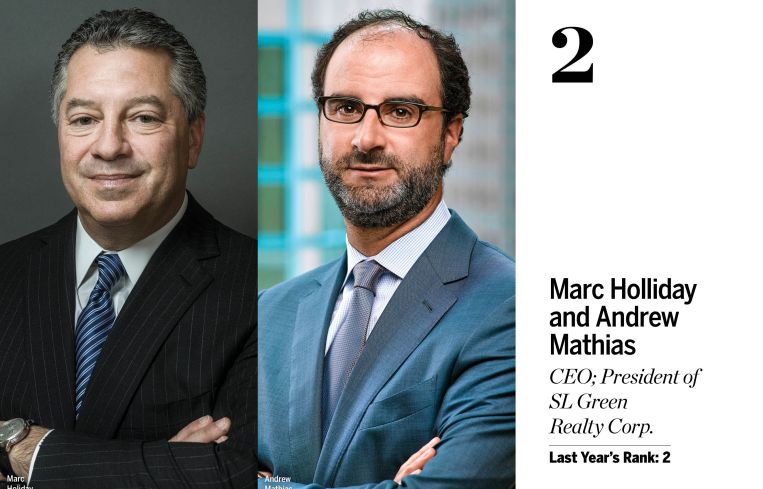
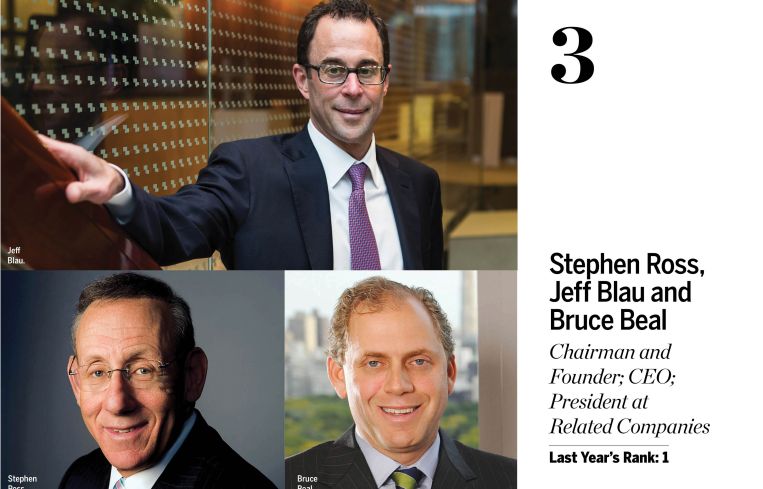
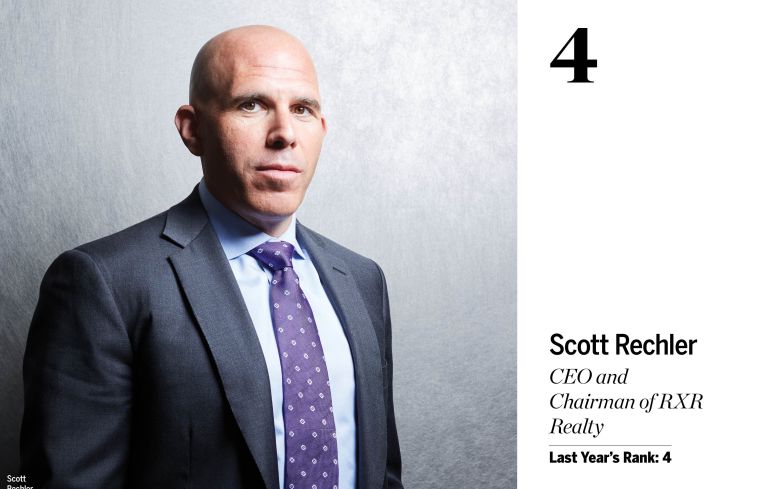

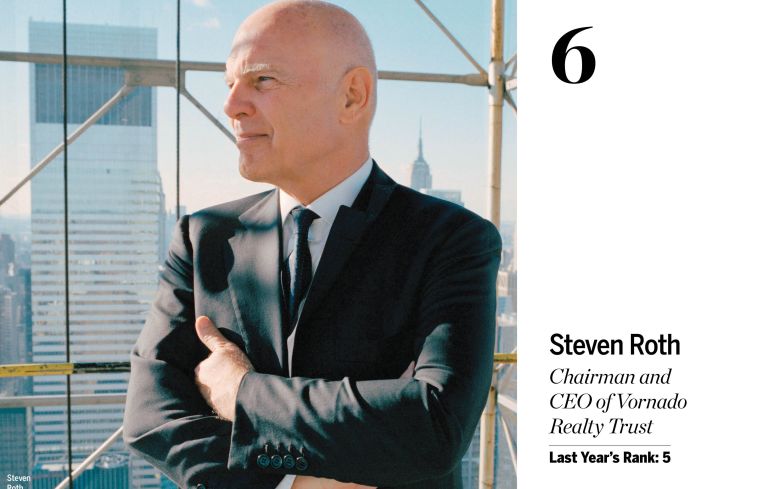
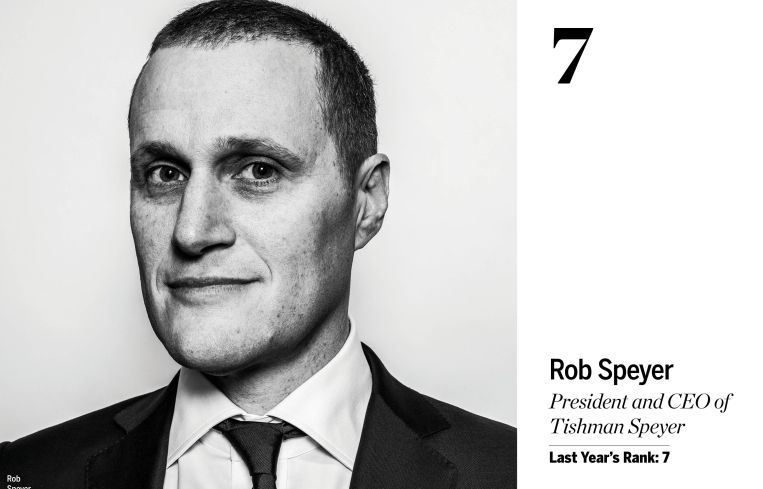
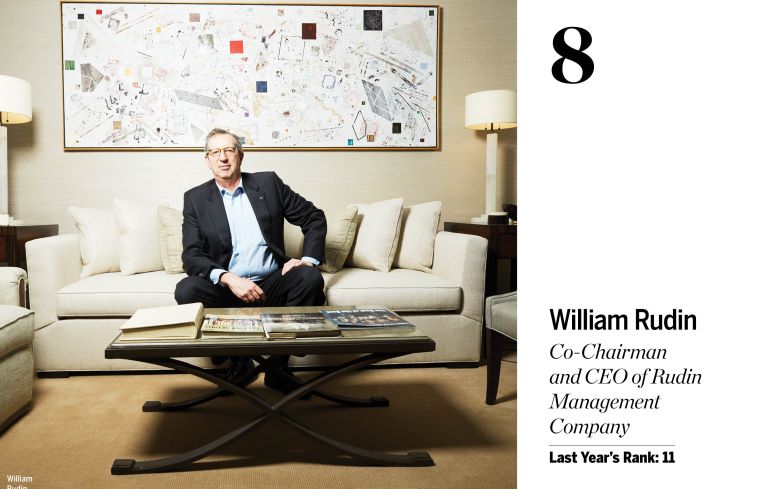

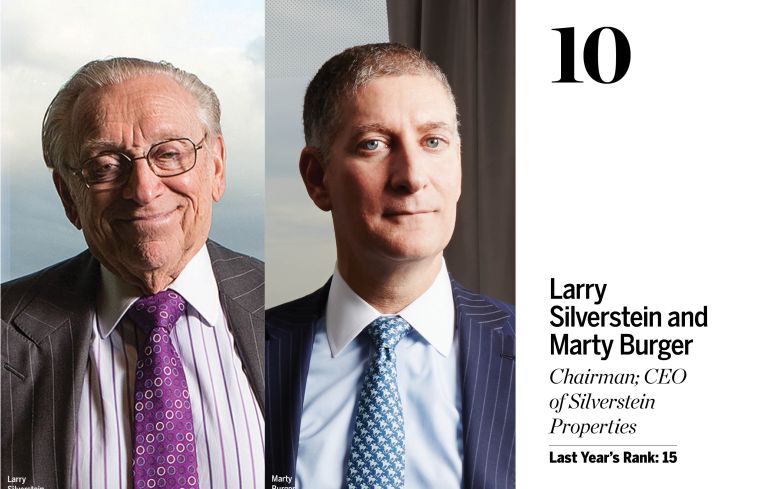


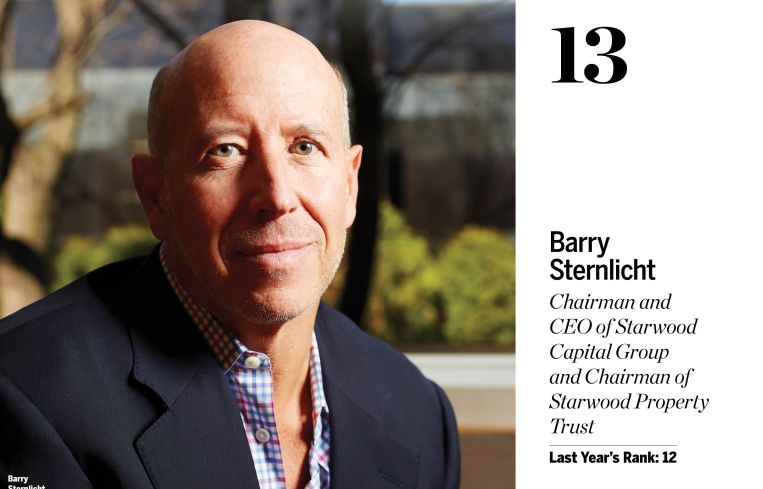

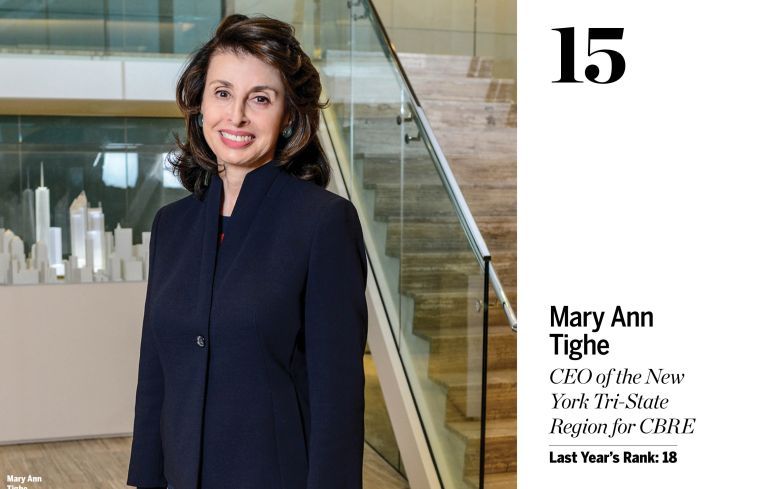

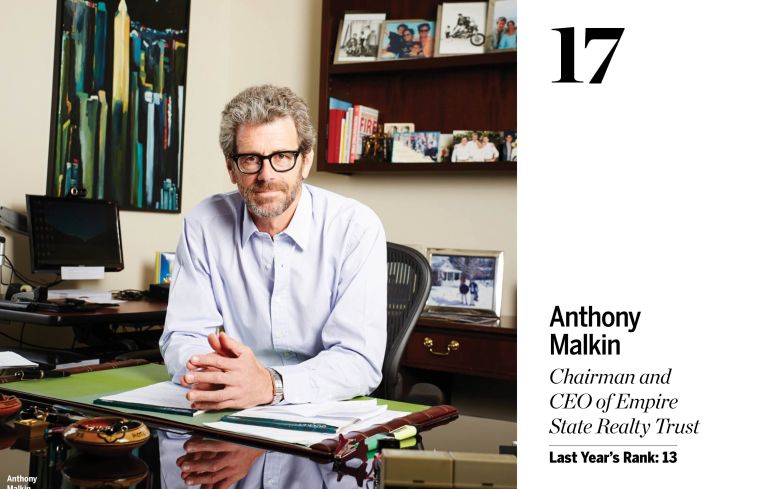


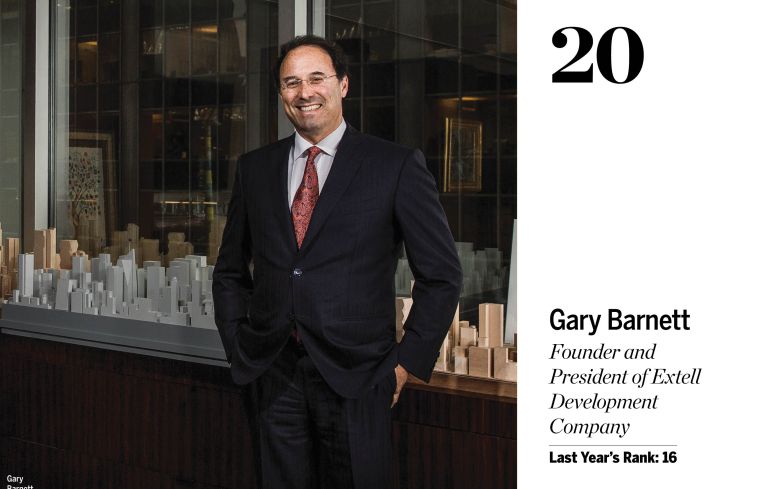



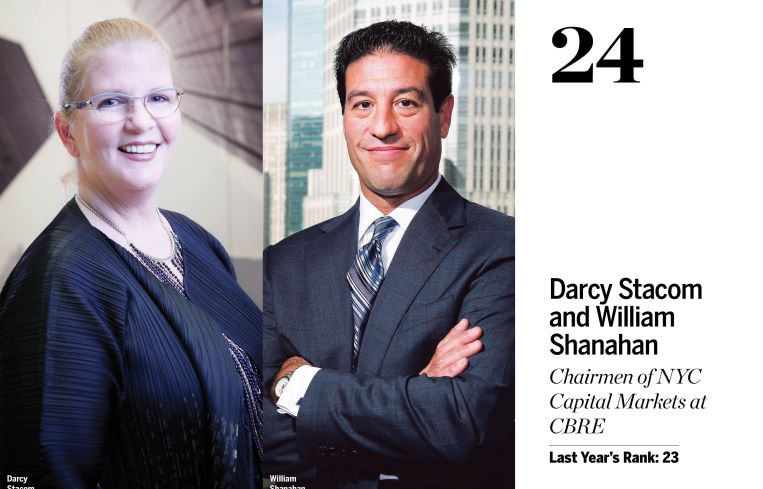

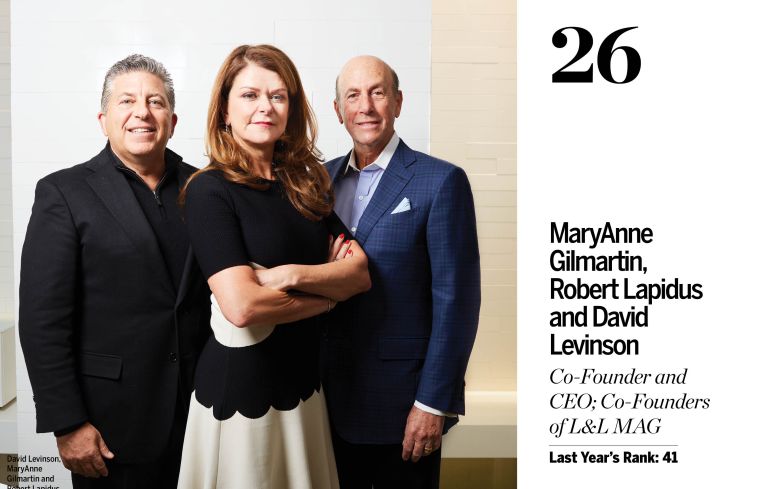

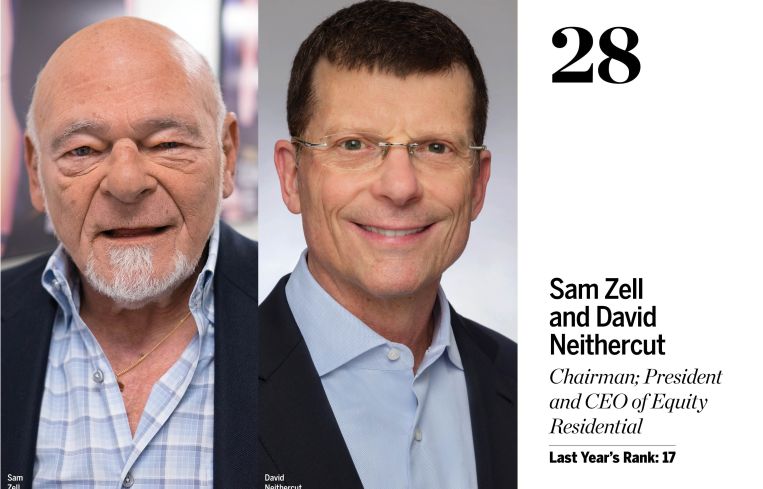

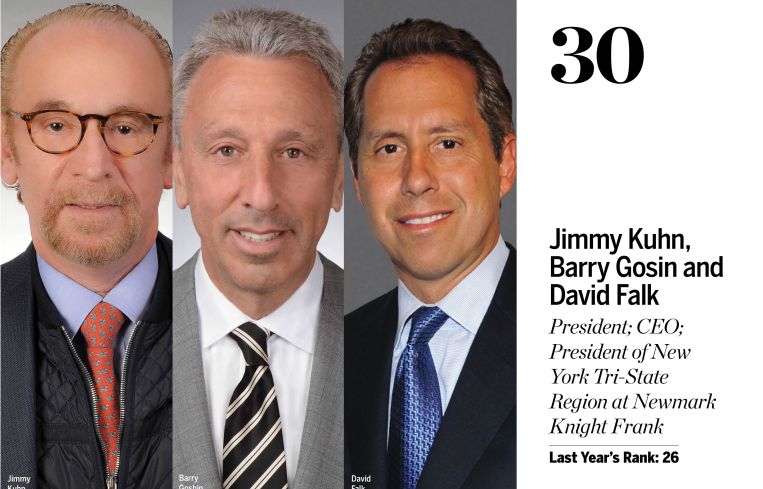


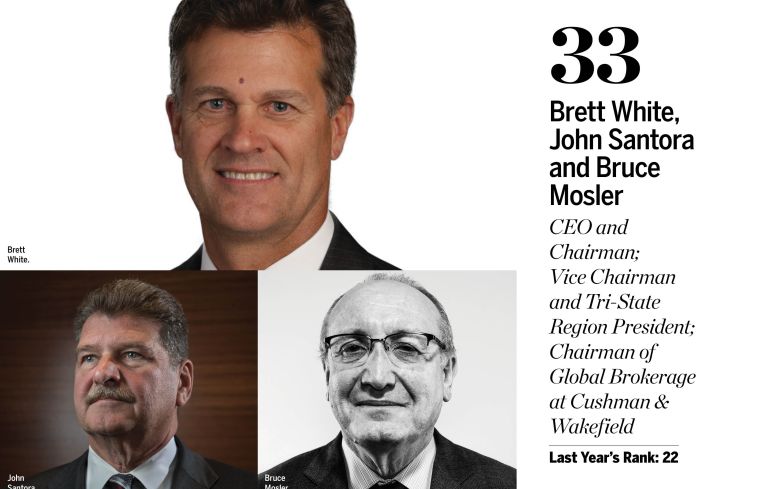

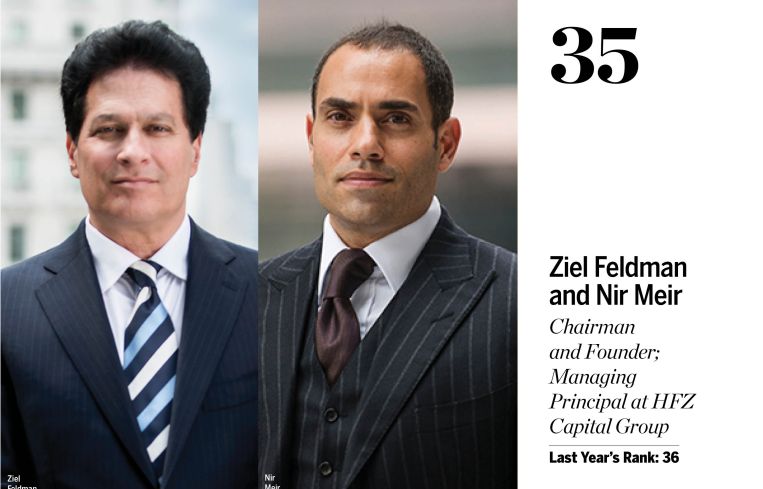
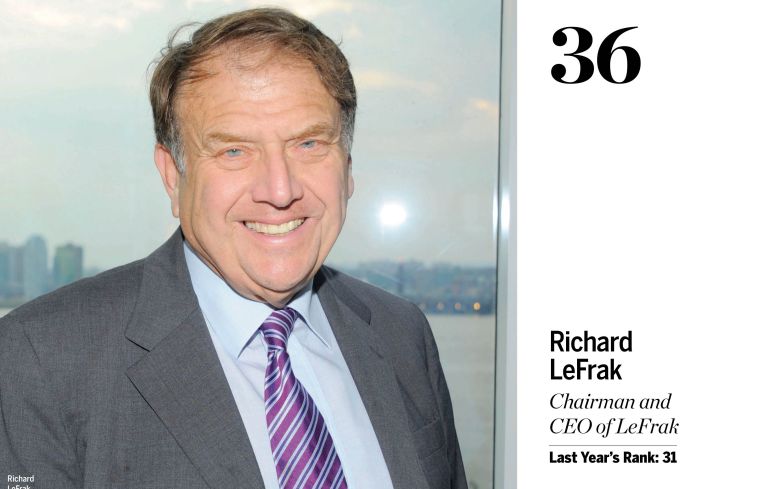
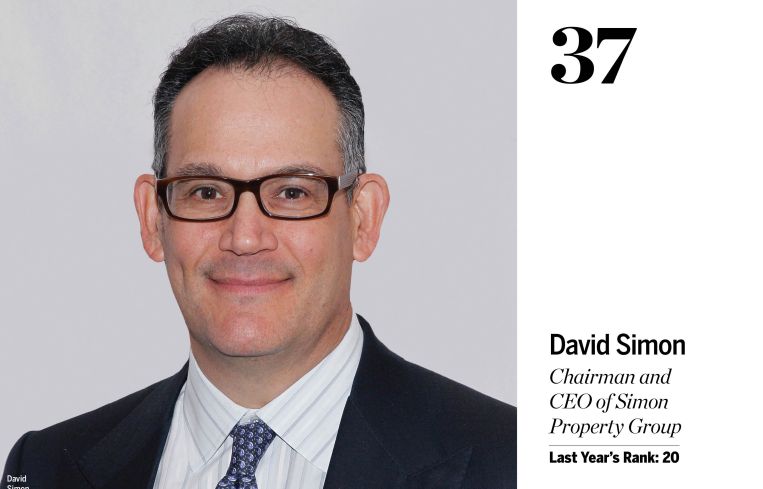
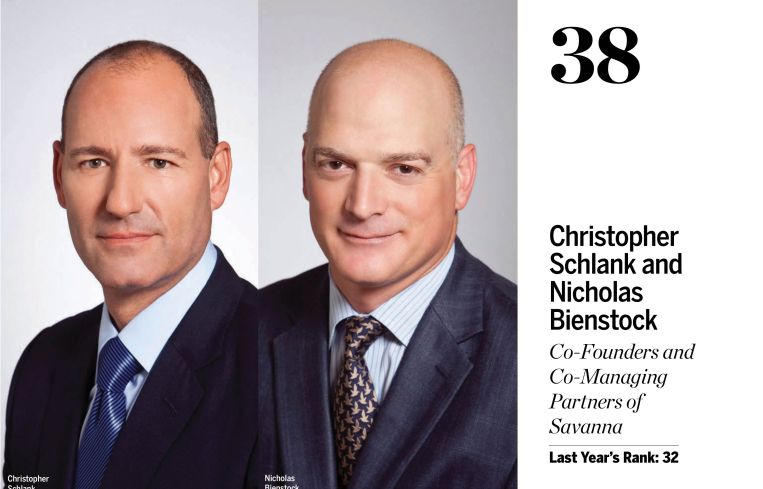

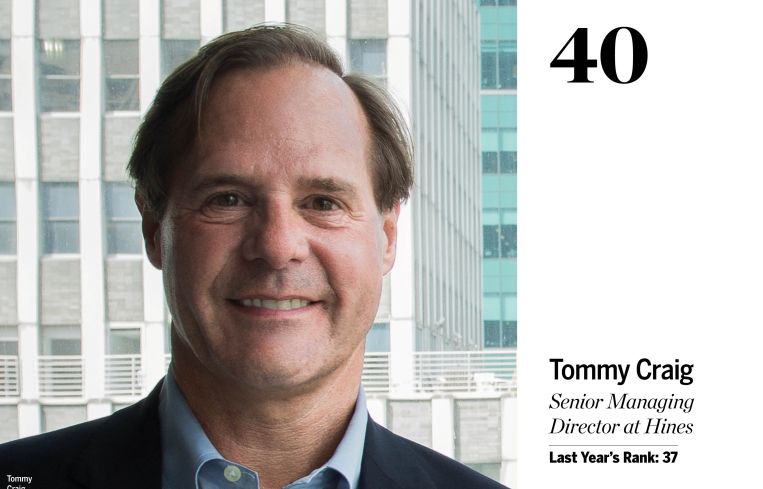




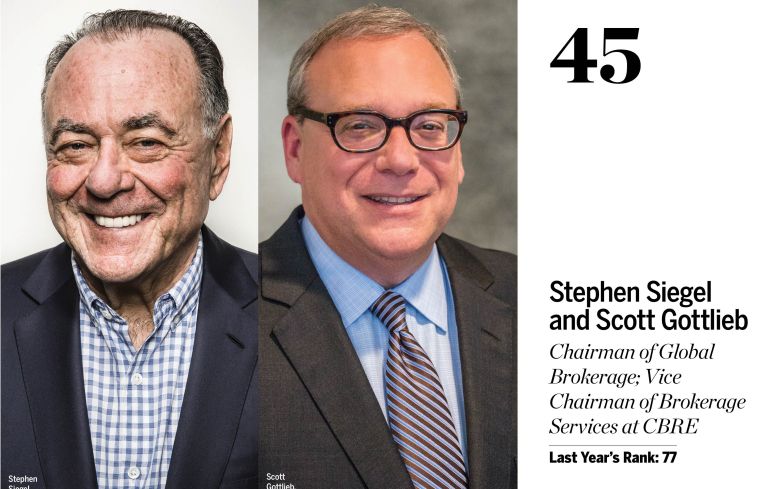

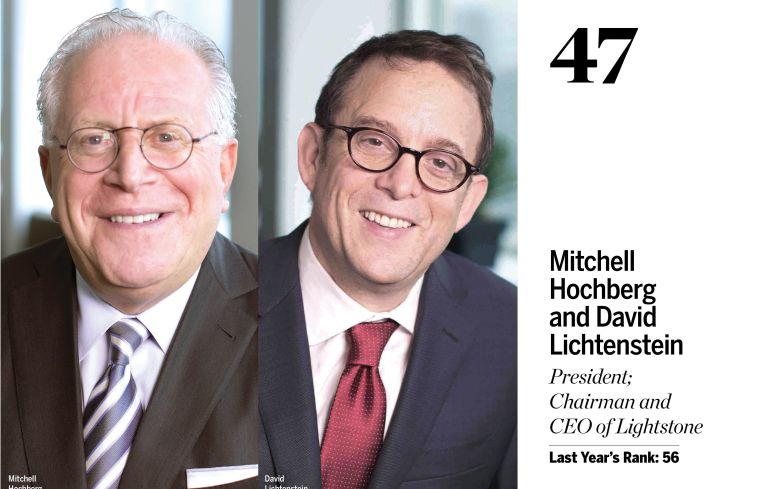
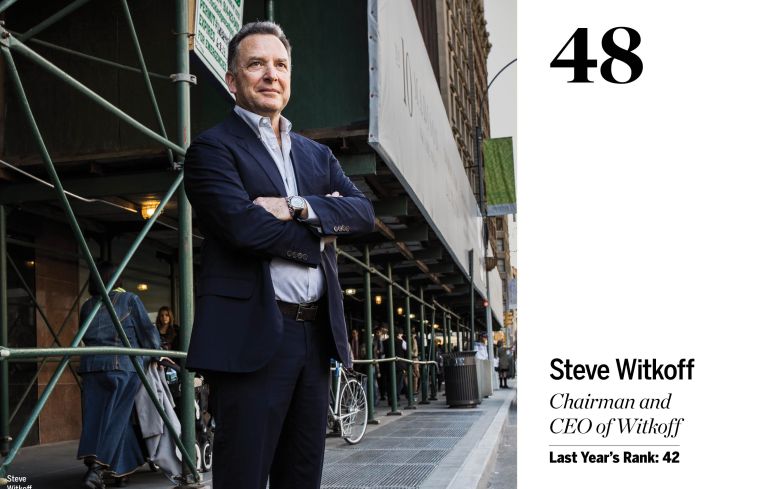



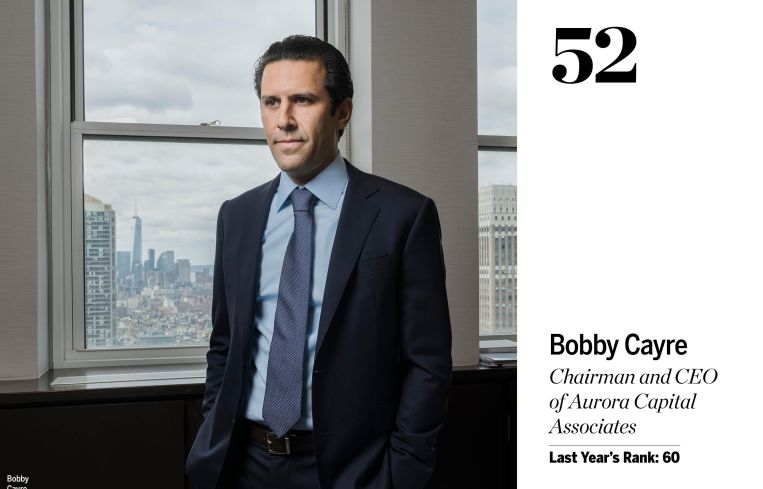
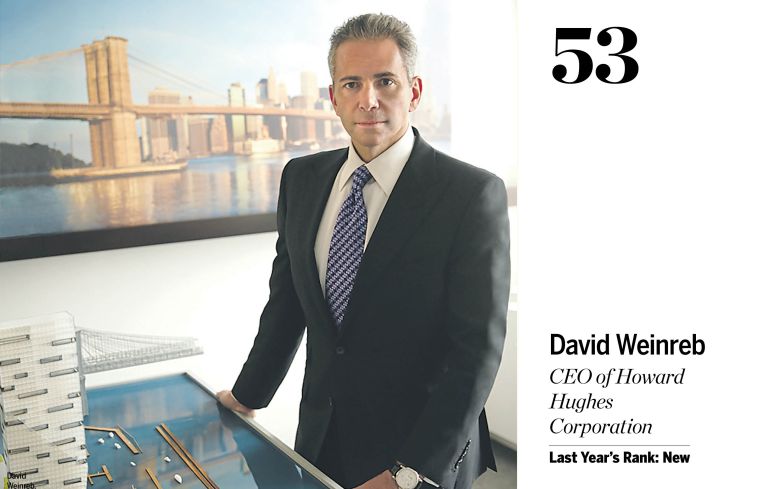

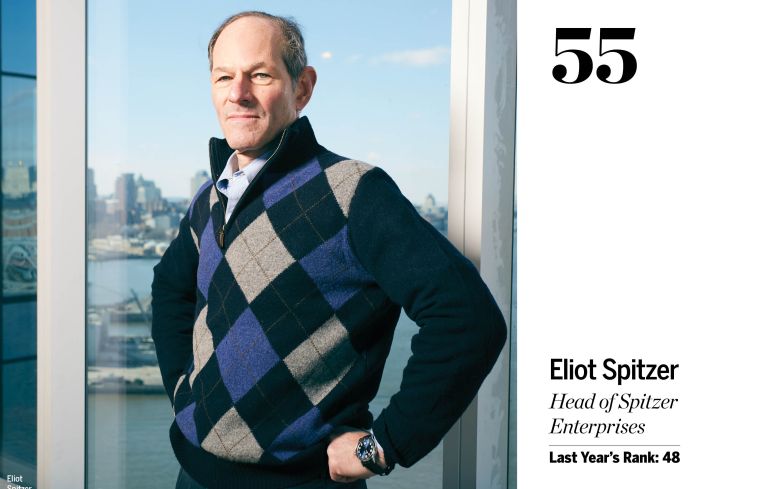
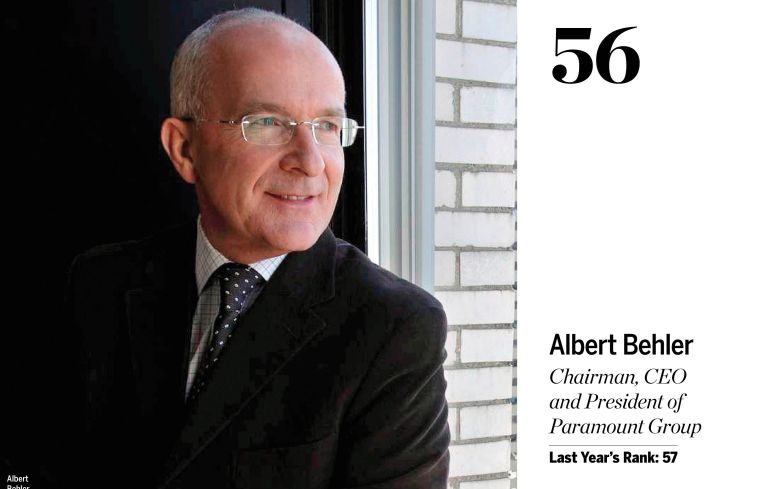
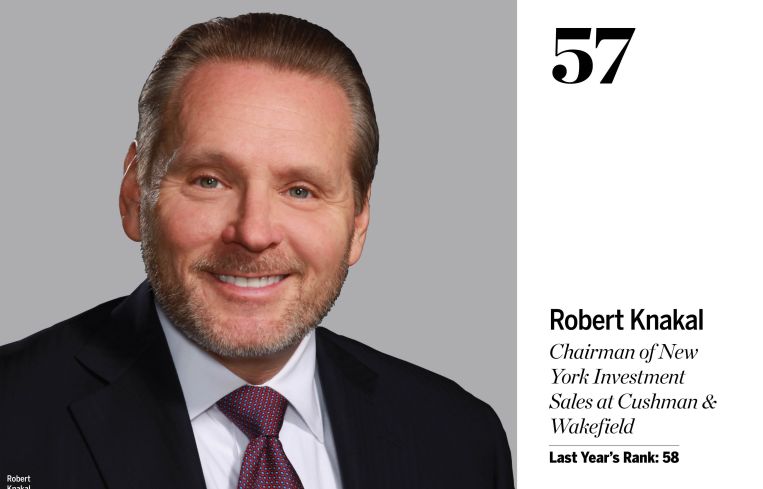

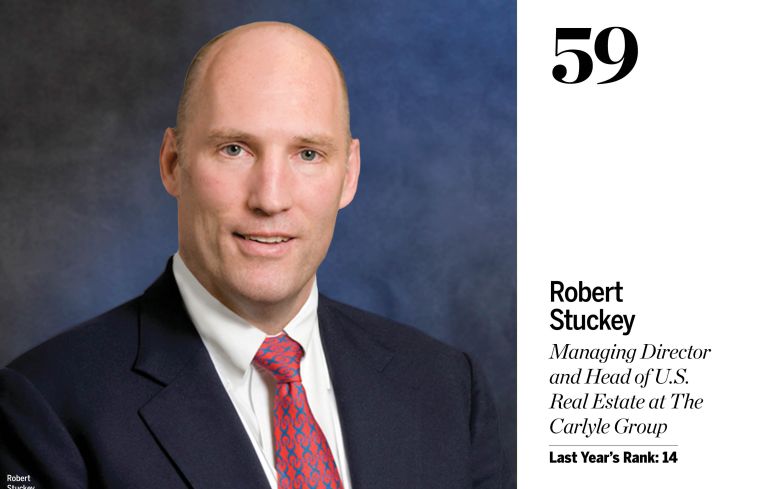
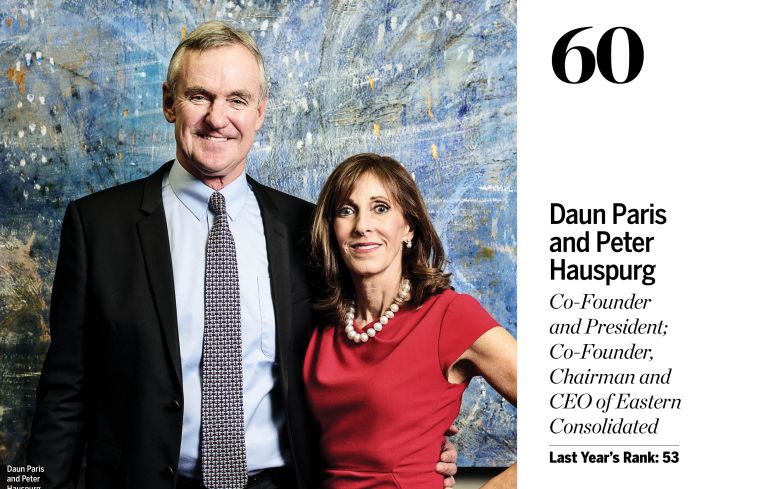

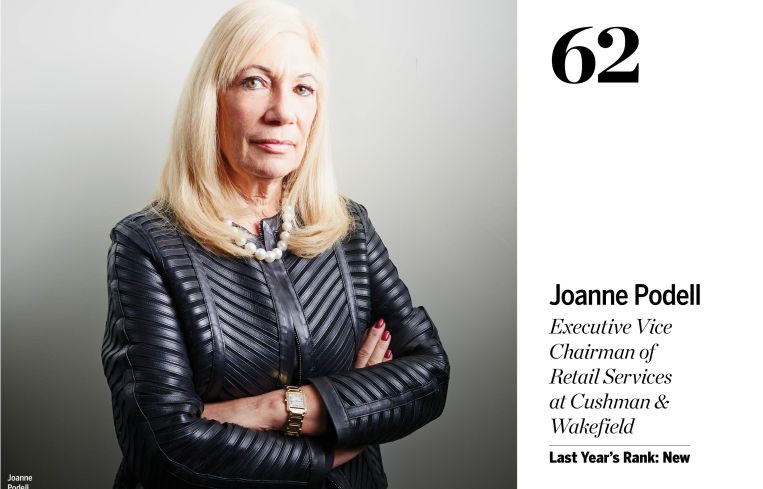
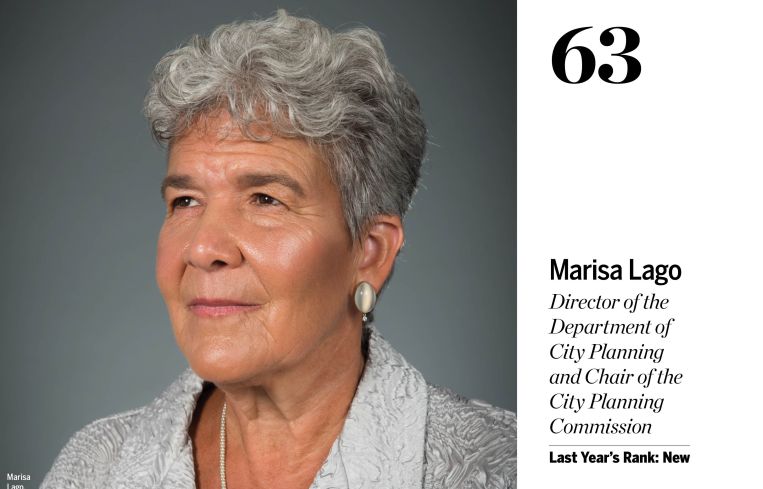

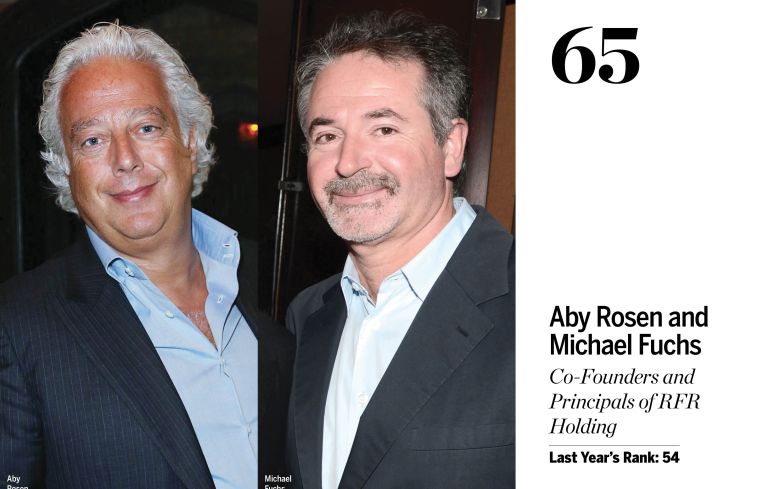
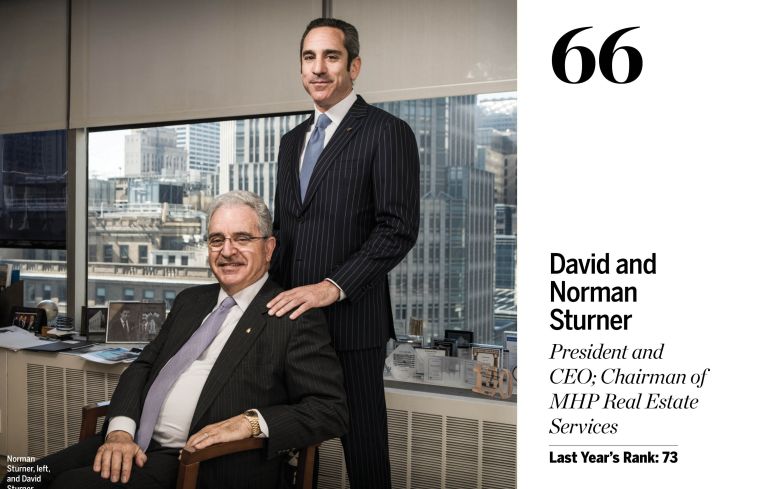
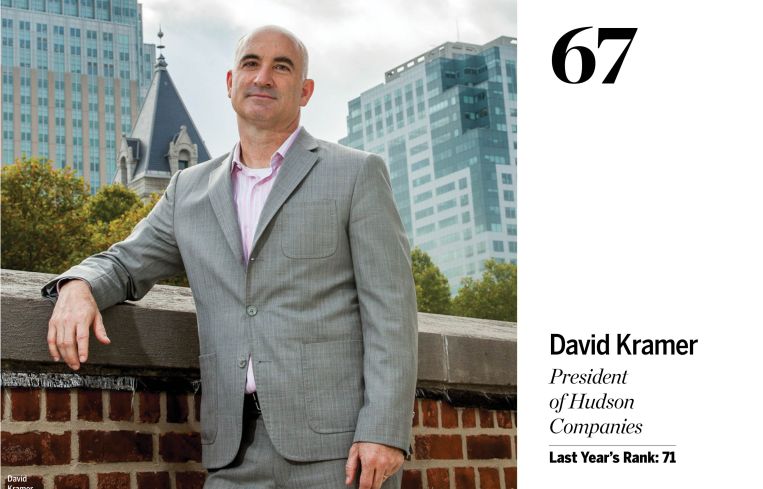

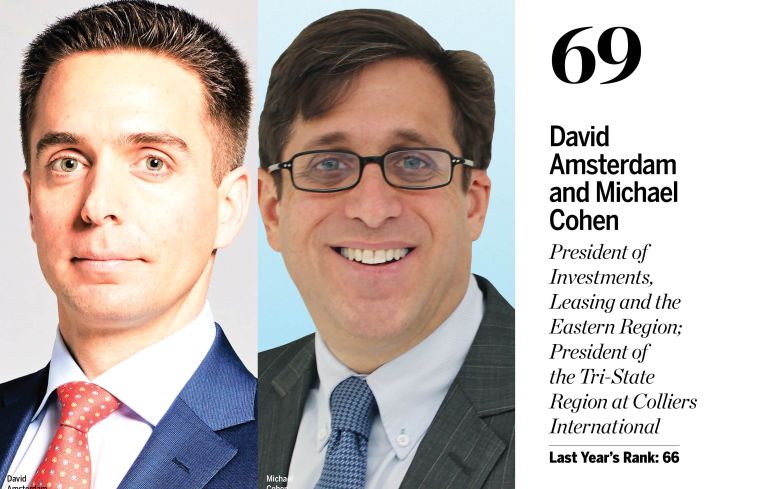



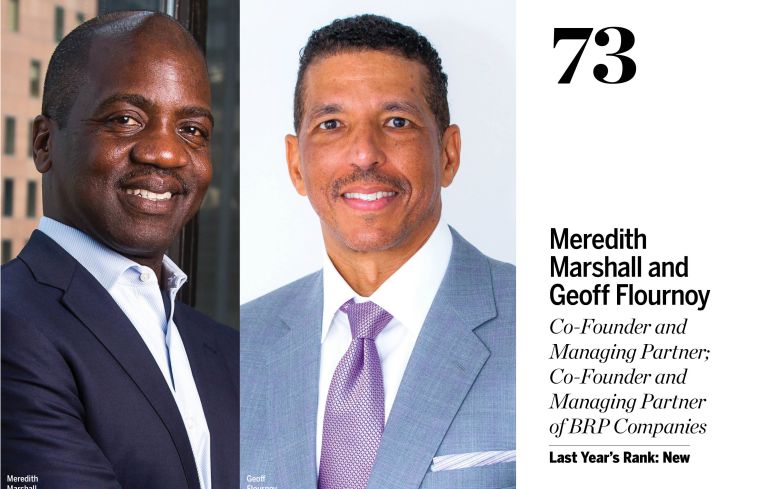
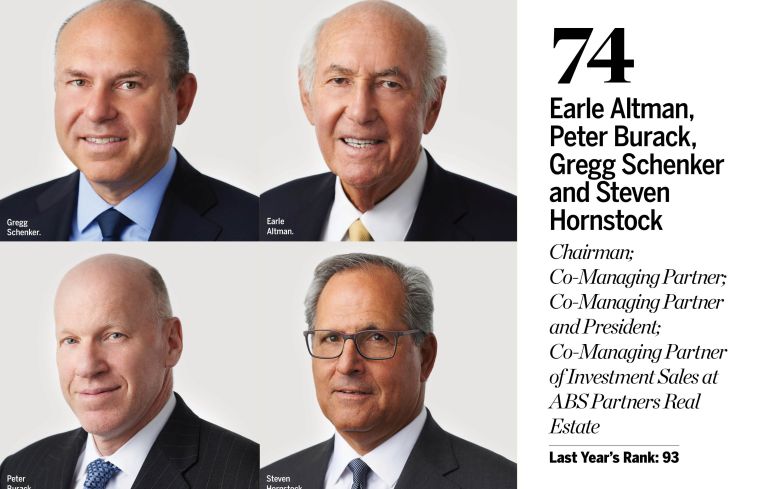
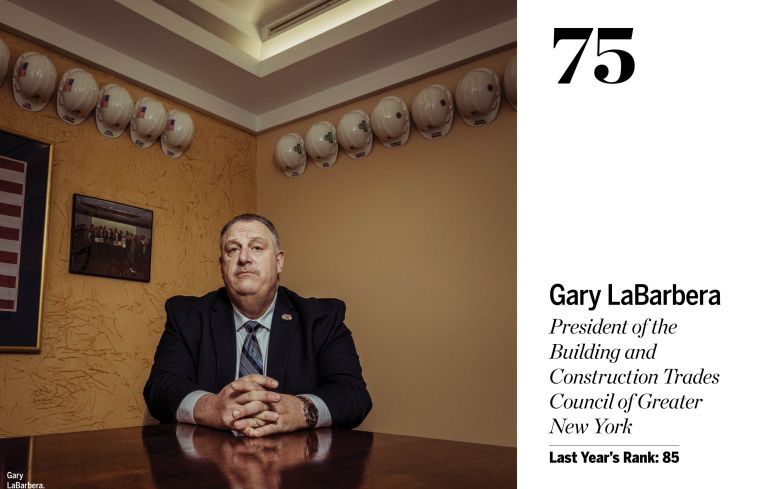
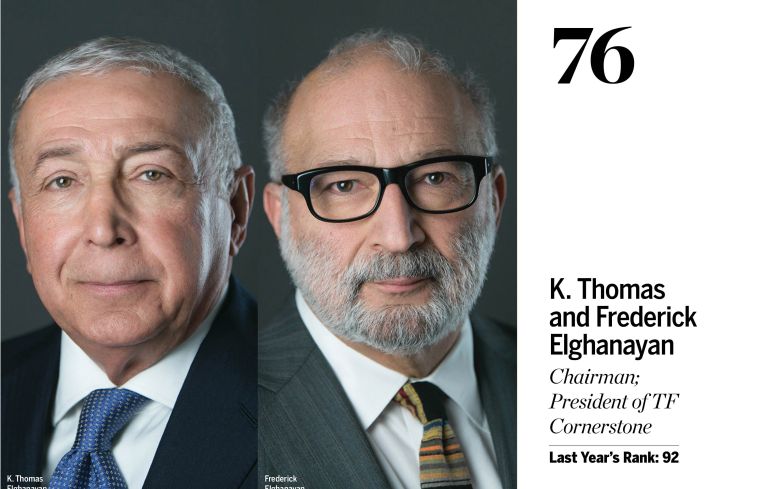

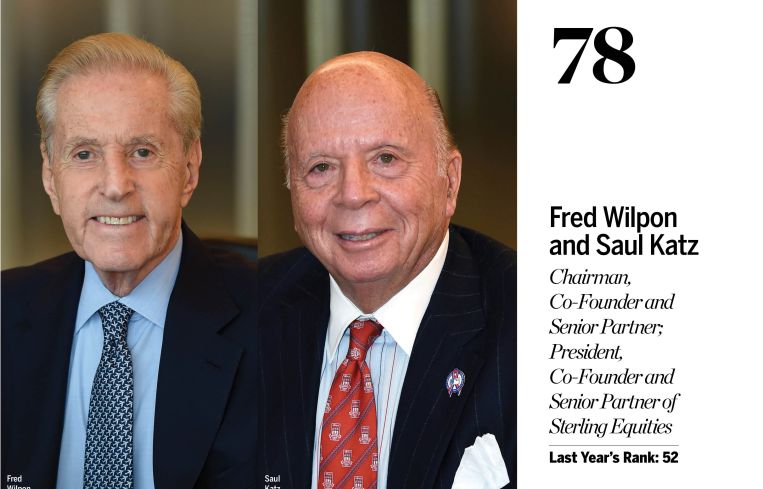



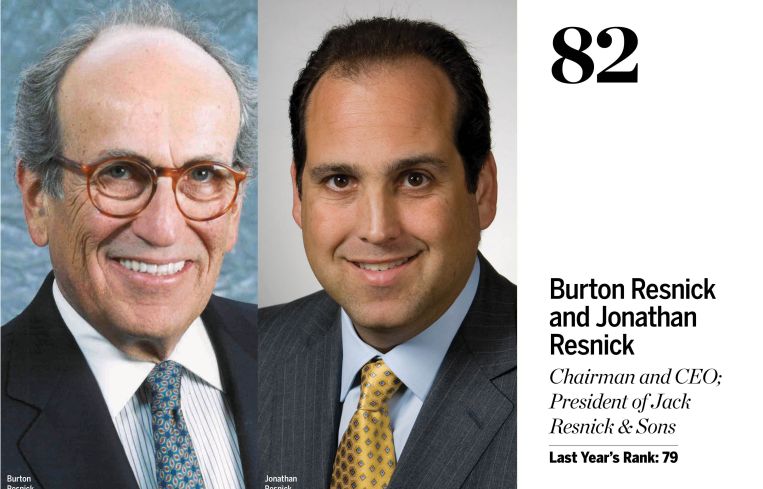




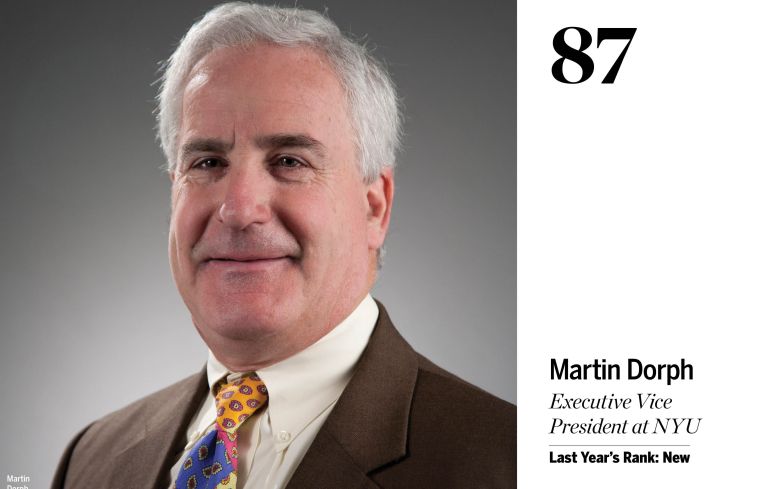



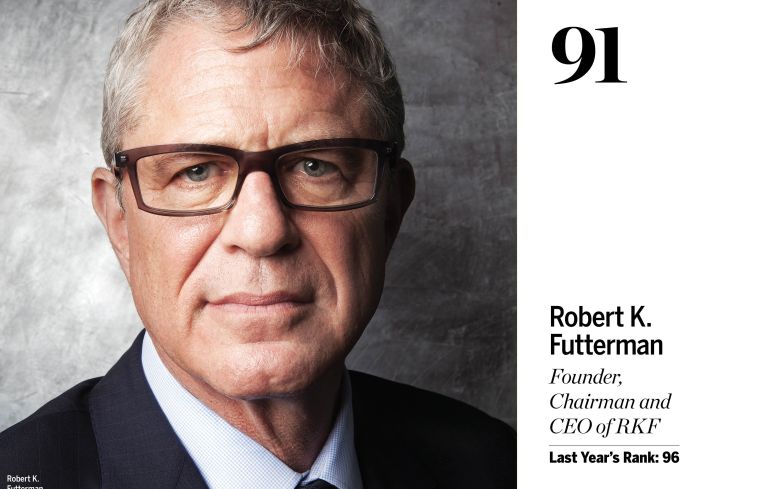
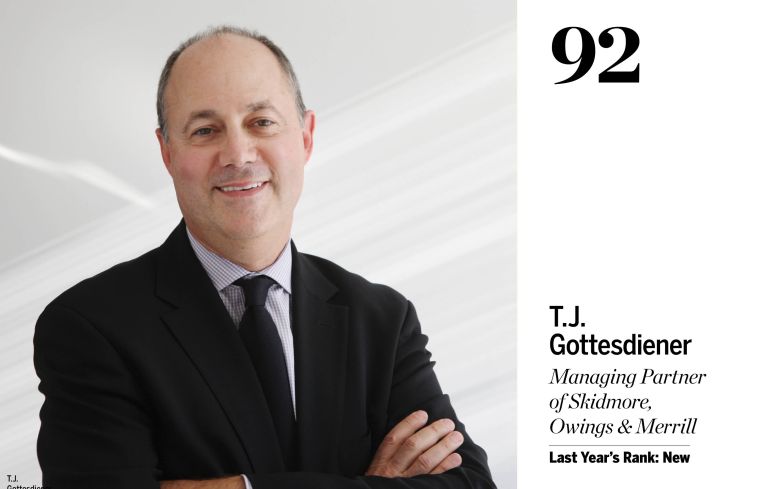
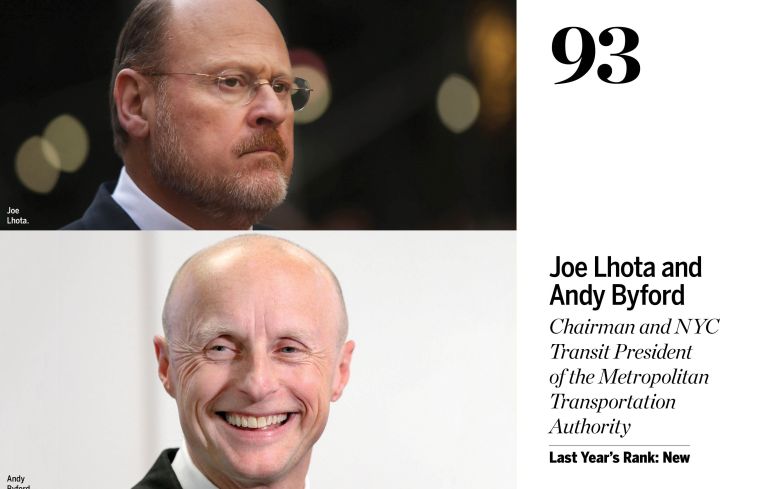
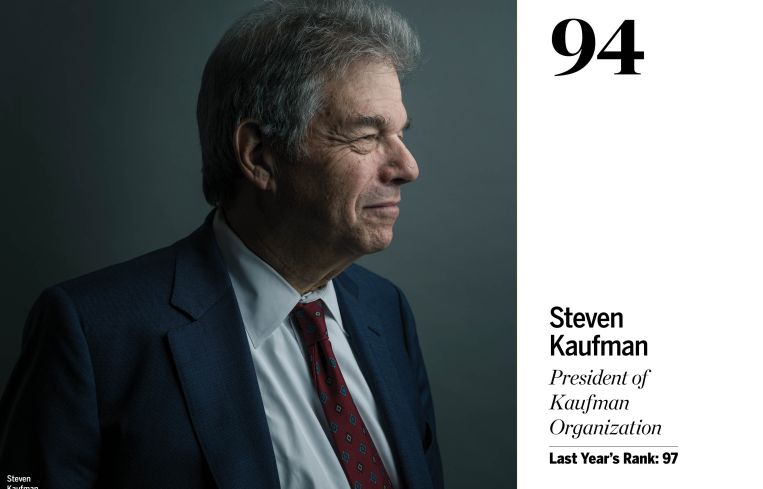


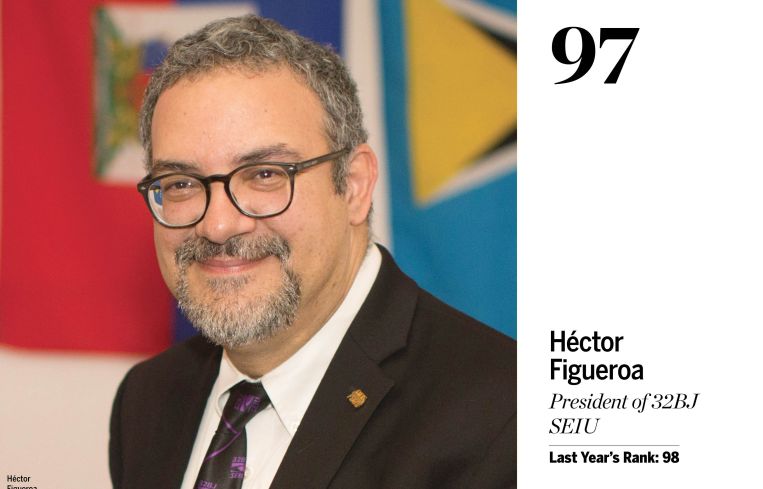
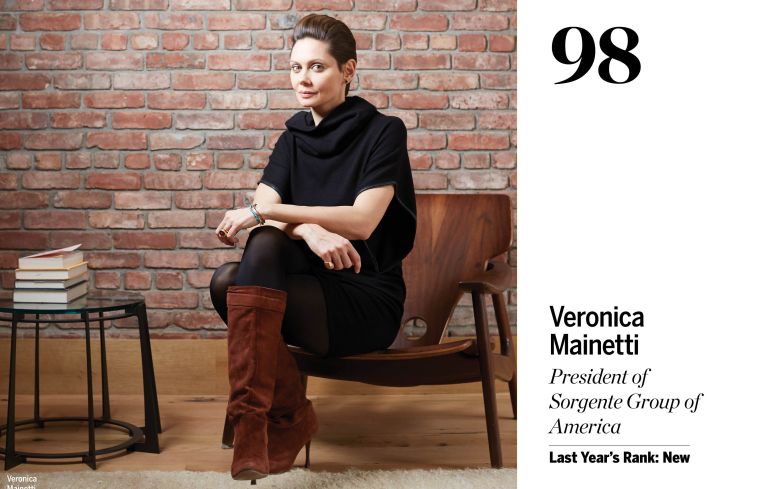
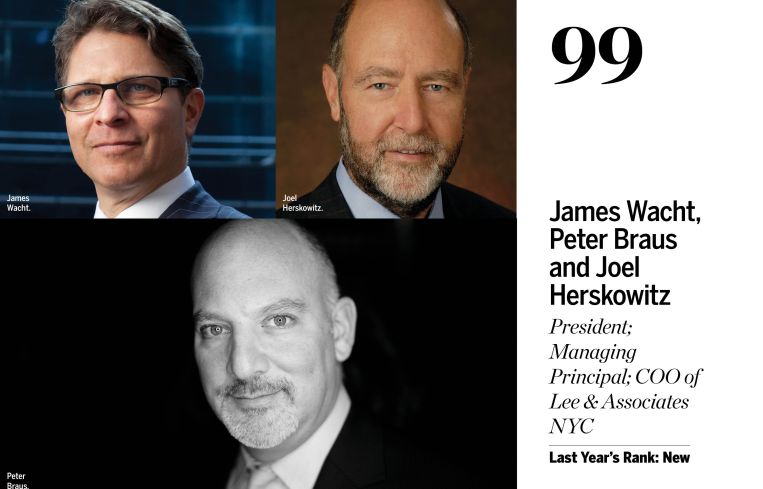

When interviewing Jeff Blau, the CEO of Related Companies, for this year’s Power 100 we asked a question Commercial Observer had never raised in the past:
Who do you think should be No. 1 on our list?
To revamp the old saw that every time a senator looks in the mirror they see a president, we imagine that every time a developer is asked his or her position in the real estate pecking order the only number they recognize is “one.” (Blau—along with Stephen Ross and Bruce Beal—got the nod himself last year.) However, if they took themselves out of the equation, who should be No. 1?
“You should pick Google,” Blau said. “They’re doing more real estate than anybody. You put Google on, everybody will say, ‘Holy shit!’ ”
Google’s $2.4 billion purchase of Chelsea Market in February was the third-largest single-building office transaction ever in New York City history—and the buy also said something even subtler about the future of the city. As Gotham jockeys to be named the new East Coast headquarters of Amazon with 19 other cities, this was a remarkable vote of confidence in this city. It said something about where the newer, techier, younger workforce wants to be.
The other thing the Google real estate purchase proved was that while many real estate players regularly say that real estate is in a holding pattern, or that we’re in “extra-innings” in an interminably long market cycle, there are players who are taking the initiative and not shying away from big things.
And that was one of the most important characteristics of those who rose in our estimation this year—they didn’t shy away from thinking big.
Brookfield Property Partners’ Ric Clark was No. 8 last year, but the company seemed unusually peckish this year; not only was it wading into multifamily with The Eugene at Manhattan West and Greenpoint Landing with the Park Tower Group in Brooklyn; not only was it leasing millions of square feet of space (like, say, EY taking 600,000 square feet at 1 Manhattan West, or Amazon taking 305,000 square feet at 5 Manhattan West); not only was it making big trades (a $2.21 billion sale of 245 Park Avenue to HNA) but after a first rebuffed attempt it managed to acquire GGP, itself one of the country’s heavyweight REITs.
Some of the heavy hitters didn’t have much room to go any higher. RXR Realty was tapped—along with Vantage Airport Group—to lead the multibillion-dollar expansion of the JetBlue terminal at John F. Kennedy Airport. Normally, this is the kind of deal that could send a developer into the top five. Unfortunately, RXR CEO and Chairman Scott Rechler was No. 4 last year, so there wasn’t a lot of room for improvement. (He’s No. 4 again.)
Silverstein Properties has always had a fairly high ranking in Power 100, but with its winning $1 billion-plus bid for the Upper West Side ABC campus it merited a spot in the top 10.
Every year publicists, landlords and brokers call Commercial Observer and ask two things: Where are they on the list? (We keep that strictly under wraps.) And what’s our methodology?
Our methodology is never going to satisfy everybody. (A “popularity contest” is how one publicist dismissed it when I tried to walk him through it.) How does one compare a landlord with a broker? It’s a difficult question. If the broker disappears from the deal, can he be replaced? Sure. But if a landlord has a great piece of real estate and nobody believes in the project or the neighborhood or the transportation, will it go empty? Sure again. Who’s more powerful? The answer is that it depends. CO’s editorial staff spent many hours wading through these questions, assigning spots on the list and trying to provide answers to questions like, “Is Google—a tech company—really a real estate powerhouse?”
Answer: Absolutely.—Max Gross
The Power 100 2018 Issue:
1. Ric Clark
Senior Managing Partner and Chairman of Brookfield Property Partners
Last Year’s Rank: 8
While investment sales slumped last year, retailers filed for bankruptcy left and right and large real estate companies slowed their transactions, Brookfield Property Partners stood out among the devastation as a hungry giant.
It made bold attempts to consume mall operator GGP, developer Forest City Realty Trust and IWG—the office space provider formerly known as Regus (although Regus-branded coworking spaces remain). And although its first offer for GGP was rebuffed, the developer’s appetite could not be sated. It bolstered an aggressive second bid and reached an agreement to gobble up the remaining 66 percent of GGP that it did not own for roughly $15 billion.
But that was just the appetizer!
In 2017, Brookfield completed about 1.8 million square feet of leasing at its 7-million-square-foot mega-development, Manhattan West. Currently, the 67-story 1 Manhattan West, the 15-story 5 Manhattan West and 13-story The Lofts building are 92.3 percent leased. In addition, Brookfield leased another 1.1 million square feet to tenants in its 8.5-million-square-foot retail and office complex Brookfield Place, 2.4-million-square-foot One Liberty Place and 2.7-million-square-foot One New York Plaza.
“Brookfield’s New York team had a really big year in 2017,” Ric Clark said. “There was just a lot that we got done last year.”
Brookfield was behind a few of the largest trades: It unloaded 245 Park Avenue, which it owned with the New York State Teachers’ Retirement System, for $2.21 billion in May 2017 to HNA Group, and then Brookfield purchased the 350,000-square-foot office building at 333 West 34th Street from New York REIT for $255 million in November.
It also sold a 49 percent stake in the 2.3-million-square-foot One Liberty Plaza for $742.4 million to Blackstone Group in December.
In March 2017, Brookfield acquired a leasehold at 1100 Avenue of the Americas with Swig Company, leased the entire 386,000-square-foot office section of the property to Bank of America and, this January, leased another 127,000 square feet to the bank in the adjacent Grace Building at 1114 Avenue of Americas (which Brookfield and Swig already owned).
By the way, Brookfield isn’t satisfied with the commercial offerings, either: It’s also craving residential properties. The company, known for its office and retail developments, entered New York City’s multifamily realm last year with the 844-unit The Eugene at Manhattan West. It has already leased 82 percent of the luxury tower.
Brookfield is also partnering with Park Tower Group for the 22-acre Greenpoint Landing mixed-use project, which will have 5,500 apartments when it’s completed. The first residential tower is set to be completed in August.
And earlier this month, Brookfield reportedly purchased a 1.3-million-square-foot site in the waterfront section of Mott Haven in the Bronx for $165 million where the company will erect a residential building.
In the past “we shied away from apartments, which has one-year leases or hotels with daily leases,” Clark said. But “the apartment sector is one of the best performing sectors in a long period of time. It’s an exceptional sector in which we took our time to educate ourselves. Now that we are educated, we are actively looking to build our local portfolio.” Bon appetite.—Liam La Guerre
2. Marc Holliday and Andrew Mathias
CEO; President of SL Green Realty Corp.
Last Year’s Rank: 2
In a previous life Marc Holliday and Andrew Mathias might have been the world’s greatest jugglers. At least, running SL Green Realty Corp. in the last year they’ve managed to keep their eye on a lot of things that they have in the air.
They’ve bought. They’ve sold. They’ve lent. They’ve leased. They’ve developed. And, true to their pedigree of being the biggest and best (SL Green is the largest landlord of commercial real estate in New York City with ownership interests in 29.5 million square feet, as per the company website) it has done so on an immense scale.
“Every department here is very busy and very engaged,” Mathias said.
On the buying front, SL Green purchased a 48.7 percent stake in One Worldwide Plaza with RXR Realty, which had an appraised value of $1.7 billion.
“It’s a prototypical asset,” Holliday said of the purchase. “Midtown, great building, great tenants, great location, high cap rate, low-per-square-foot acquisition price and room to run on the bulk of the rents.”
As for sales, there were quite a few notable ones: The company sold a 43 percent minority stake in 1515 Broadway to the German financial services company Allianz Real Estate in a deal that valued the building at $1.95 billion; it sold 600 Lexington Avenue for $305 million to an insurance company; 16 Court Street in Downtown Brooklyn to CIM Group for $171 million; and just at the beginning of the month it sold the 674,000-square-foot office condo it owned with Ivanhoé Cambridge at 1745 Broadway to Invesco for $633 million.
SL Green also put an immense amount of money out as a lender. “We do about a deal a week,” Holliday said. While the company limits its lending to 10 percent of its assets, this has still meant $1.5 billion in originations and $210 million in revenues for the company.
With a portfolio that is 96 percent leased, it’s not as if the real estate investment trust hasn’t been striking deals—like, say, powerhouse law firm Greenberg Traurig taking more than 130,000 square feet of new office space at an SL Green property.
Which brings us to the last—and most exciting—ball in SL Green’s orbit (where Greenberg Traurig is taking all that space): One Vanderbilt, the super-tall, 1.6-million-square-foot skyscraper across the street from Grand Central Terminal that SL Green is developing.
Having taken years to get off the ground and including hundreds of millions of dollars pledged in transit improvements this project has played a critical role in the passage of the Midtown East rezoning and no doubt blazed a path for J.P. Morgan Chase’s announcement earlier this year that it would demolish and rebuild its building at 270 Park Avenue.
“Obviously, the centerpiece for us is One Vanderbilt,” Mathias said. “That’s requiring an enormous amount of my time and Marc’s time. Every discipline in the firm is getting ready for that building to open up in September 2020.”—Max Gross
3. Stephen Ross, Jeff Blau and Bruce Beal
Chairman and Founder; CEO; President at Related Companies
Last Year’s Rank: 1
Jeff Blau was in a good mood on the morning he spoke to Commercial Observer for Power 100: The day before, Page Six reported that Sting rented an apartment at 520 West 28th Street—Related Companies’ property that straddles the High Line and was designed by the late Zaha Hadid.
This might seem a relatively modest thing to be happy about; after all, Related’s deals at Hudson Yards over the last 12 months have been worth billions. In May 2017, Related landed the kind of white whale landlords only dream about: BlackRock paid $1.25 billion for a 20-year, 847,000-square-foot lease at 50 Hudson Yards. (The deal was reached a few months earlier but not finalized until then.)
Still, Sting is yet another data point in the great accumulation of evidence that Related’s big bet on the Far West Side of Manhattan is paying handsome dividends. The long-ago fear that a project that far west would have a tough time competing with the more well-trod sections of the city sounds like the cries of a Cassandra. (Sting’s last apartment, it should be noted, was one he sold for $50 million at 15 Central Park West, proving he knows a thing or two about decent real estate.)
“The whole thing started with Time Warner Center,” Blau said. Time Warner Center, which opened in 2003, served as a model for a large-scale project that involved retail, hospitality and residential all under one roof. “What do you do for an encore? That’s when Hudson Yards came up,” he noted. Now, a grand project like Hudson Yards, he added, is Related’s “true core competency. Nobody else in the country that comes up [can do this]. Not at this scale.”
And duplicating this success seems to be Related’s plan. “In Chicago we have a 62-acre site right in the middle of the city [that’s] 12 million square feet,” Blau said. “It’ll be the Hudson Yards of Chicago.” In Santa Clara, Calif., Related has a 240-acre mixed-use development in the planning stage. He called it, “San Francisco’s Hudson Yards.”
And we haven’t even mentioned the Grand Avenue complex in Downtown Los Angeles, a $1 billion mixed-use complex that Frank Gehry is designing and will feature an Equinox hotel.
“In retail, it’s been nothing but remarkable,” Blau said of the company’s business during a year dogged by retail implosion.
Indeed, Cartier, Van Cleef & Arpels and Piaget and the London-based hospitality group Rhubarb all announced late last year that they were coming to Hudson Yards, and after having once struck retail gold at Time Warner Center with what has been sometimes cheekily called the most expensive food court in history counting the likes of Masa and Per Se amongst its eateries, Related is assembling a similar murderers’ row at the Shops & Restaurants at Hudson Yards, a 1-million-square-foot retail complex anchored by Neiman Marcus that will include restaurants by Thomas Keller, David Chang and José Andrés.—Max Gross
4. Scott Rechler
CEO and Chairman of RXR Realty
Last Year’s Rank: 4
Two-thousand-and-eighteen has already taken off like a supersonic jet for RXR Realty. We’re referring, of course, to the March announcement that JetBlue Airlines tapped RXR and Vantage Airport Group to lead the multibillion-dollar expansion of its terminal at John F. Kennedy International Airport.
“The big thing is JetBlue,” Scott Rechler said. But in a year when a lot of real estate professionals have been content to sit back and see what the market does, RXR has been doing “big, bold deals.”
Case in point No. 1: One Worldwide Plaza. Along with SL Green Realty Corp., RXR purchased a 48.7 percent stake in the Midtown West skyscraper, which was valued at a whopping $1.7 billion.
Case in point No. 2: RXR bought the development rights to replace Long Island University’s athletic fields at 161 Ashland Place in Brooklyn to put up a new complex that will include 476 apartments.
Case in point No. 3: It is continuing its “suburban-urban strategy”—i.e., developing thousands of units in the areas surrounding New York City with projects like Larkin Plaza, the $200 million mixed-use complex in Downtown Yonkers, which topped off this past November.
Case in point No. 4: RXR sold NewYork-Presbyterian Hospital 500,000 square feet of space at 237 Park Avenue for $250.8 million (with the sweet condition that RXR gets the property back in 30 years).
And Rechler has certainly not neglected the bread-and-butter leases that make a real estate empire hum. It might have disappointed some that Anthony Bourdain’s Singapore-inspired market bit the dust, but RXR managed to replace him with a nice, juicy Google expansion. (As far as tenants go, yes, that counts as an upgrade.)
The civically engaged (and former vice chair of the Port Authority of New York & New Jersey) Rechler has taken a very public stand on the issue of gun control in the last year.
In November, RXR lit up 230 Park Avenue for 58 nights in orange in honor of each of the victims of the massacre at a concert in Las Vegas a month earlier. Earlier this month Rechler appeared with former Secretary of Homeland Security Jeh Johnson, John Feinblatt of Everytown for Gun Safety and Linda Beigel Schulman, a mother who had lost her son in the Parkland shooting in February, at Merkin Concert Hall to advocate against gun violence.
“It’s time for business to step up,” Rechler declared to the audience.—Max Gross
5. Sundar Pichai
CEO of Google
Last Year’s Rank: New
Any company that spends $2.4 billion to acquire a property in New York City should be considered a major real estate player—especially one that does so in an all-cash transaction. Google, you are officially a serious real estate player.
The tech giant’s gargantuan deal to purchase Chelsea Market at 75 Ninth Avenue from Jamestown in March is the third-largest-ever single-building office transaction in Gotham and a show of force from Google that says, if it should so desire, it could easily compete in the real estate capital of the world. As Google’s parent company, Alphabet Inc., brought in $110.8 billion in revenue last year, $2.4 billion is child’s play.
“This purchase further solidifies our commitment to New York, and we believe the Manhattan Chelsea Market will continue to be a great home for us and vital part of the neighborhood and community,” according to a Google statement about the purchase.
Google first entered New York in 2000 with a single salesperson who worked from a Starbucks. Today, it has more than 7,000 employees in the Big Apple.
Before its big Chelsea Market buy, Google had already occupied 400,000 square feet in the 1.2-million-square-foot building. Google’s main New York offices are across the street at 111 Eighth Avenue, a building that the company purchased for $1.77 billion in 2010.
And thanks in part to Google’s presence in the Chelsea-Meatpacking area, which dates back to 2006, hordes of tech companies and brands have flocked there, making it a hot spot for the industry.
Also last year, the company expanded its lease at 85 10th Avenue by 60,000 square feet, to 240,000 square feet total. And at Pier 57, which RXR Realty is currently redeveloping, Google added 70,000 square feet of office space and 50,000 square feet of public engagement space to its 250,000-square-foot lease at the property.—Liam La Guerre
6. Steven Roth
Chairman and CEO of Vornado Realty Trust
Last Year’s Rank: 5
If you’ve kept an eye on Vornado Realty Trust over the years, you will know that Steven Roth’s designs on repositioning the firm’s expansive Penn Plaza assets are nothing new. Indeed, on earnings calls and letters to shareholders, Vornado’s head honcho has for years talked up the embedded upside within the 9 million square feet of real estate that the company owns in the area surrounding the Penn Station transit hub.
Except now there are signs that Roth’s Penn Plaza puzzle is finally starting to come together. The past 12 months saw Vornado (alongside Related Companies and Skanska) win the right to redevelop the James A. Farley Post Office Building, adjacent to Pennsylvania Station, into the new Moynihan Train Hall. In addition to reinvigorating the transit hub for Amtrak and Long Island Rail Road travelers, the project will yield 730,000 square feet of new office space and 120,000 square feet of new retail.
Meanwhile, Vornado is finally getting to work on renovating the massive 57-story, 2.5-million-square-foot 1 Penn Plaza, a $200 million undertaking expected to commence later this year that aims to boost the office tower’s asking rents by $20 per square foot and will see it rebranded as “Penn 1.”
Across the street at 2 Penn Plaza, a proposed Bjarke Ingels-helmed redesign of the building could be scrapped for a ground-up redevelopment of the property, Roth said in a recent shareholder letter, while the real estate investment trust continues to vet its long-planned 15 Penn Plaza skyscraper on the Hotel Pennsylvania site on Seventh Avenue.
Elsewhere in Manhattan, Vornado appears set to rid itself of 666 Fifth Avenue after Roth revealed a “handshake” agreement to offload its 49.5 percent interest in the office tower to co-owner Kushner Companies. And at 350 Park Avenue, the company could be the latest developer to tap into the benefits of the Midtown East rezoning, with Roth describing the property as “the best candidate on Park Avenue to next take advantage of the new zoning incentives” available under the redrawn guidelines.
There’s been much conjecture about when Roth, who is in his mid-70s, will relinquish the Vornado helm; despite undergoing heart surgery last August, he’s said he feels “fine” and has no plans to step down. For a man whom President Donald Trump counts as one of his friends in the real estate industry, it’s a lot of power to walk away from.—Rey Mashayekhi
7. Rob Speyer
President and CEO of Tishman Speyer
Last Year’s Rank: 7
Rob Speyer may have stepped down as chairman of the Real Estate Board of New York, but he still controls his family’s sprawling and active real estate business, Tishman Speyer.
“I’m proud of what we accomplished [at REBNY],” Speyer said. “Getting done the Affordable New York Housing Program and the rezoning of Midtown East are two legacy items that will leave the city and the industry in good stead for a long time to come.”
Under the leadership of Speyer, the firm manages a New York City commercial real estate portfolio spanning 16 million square feet and is developing another 4.5 million square feet of commercial projects. Tishman is also building its first two New York City-area residential developments—a 1,900-unit, three-building development called Jackson Park in Long Island City, Queens, and a 51-story, 480-unit condominium tower at 11 Hoyt Street in Downtown Brooklyn.
Jackson Park includes a 1.6-acre park and a 60,000-square-foot amenity building, both of which will open in the next month or two. The first residential building is leasing up now, and the other two will be complete this summer. Across the street, Tishman has poured concrete for 10 floors of the JACX, a 1.2-million-square-foot, two-building office and retail complex. The pair of 26-story towers is already 70 percent leased to Bloomingdale’s and WeWork, with construction expected to finish in mid-2019.
Meanwhile in Downtown Brooklyn, the Rockefeller Center-based company recently started on foundations for the Studio Gang-designed residential condominium project at 11 Hoyt Street. And it’s stacking six new stories of commercial space atop Macy’s four-story office building across the street at 422 Fulton Street.
But Tishman’s most exciting project is unquestionably The Spiral, a Bjarke Ingels-designed, 2.8-million-square-foot office tower at 66 Hudson Boulevard.
Pfizer just inked a deal for 800,000 square feet of office space at the property, which will start construction in July and finish in 2022. The structure will feature cascading, connected terraces that wrap around the building and double-height floors connected by open stairs “to provide the perfect point for informal collisions and discussions and the kind of environment companies want from their new real estate,” Speyer said.—Rebecca Baird-Remba
8. William Rudin
Co-Chairman and CEO of Rudin Management Company
Last Year’s Rank: 11
At the end of 2016, Rudin Management Company’s patriarch Jack Rudin died at age 92, so “2017 was a year of transition and moving our company forward,” said William Rudin, whose company’s portfolio includes 35 commercial and residential buildings in the city, comprising about 15 million square feet.
William’s children, Samantha and Michael Rudin, were both promoted to senior vice president from vice president last year, so they could have more responsibility and learn to run the company, the senior Rudin said.
“Watching them grow and develop and take more of a leadership role in this organization is a priority for [Rudin Management President and co-Chair] Eric [Rudin] and myself,” Rudin said. “Because in any company you need to make sure, just like Jack and Lew [Rudin, who ran the company with Jack] did with Eric and myself, that there is a smooth transition, and the next generation has the support to take over and run the company.”
The timing was also appropriate because William became the chairman-elect of the 122-year-old Real Estate Board of New York in June and would have to split his time between Rudin Management, REBNY and his efforts with the Association for a Better New York. His three-year term at the helm of the strongest real estate advocacy group in New York City started on Jan. 1, 2018.
But that doesn’t mean that Rudin is shying away from the development that has been the calling card of the family for generations. Another major highlight for Rudin Management last year was topping out its first-ever Brooklyn development in October: the 675,000-square-foot Dock 72 office building, which Rudin is building in partnership with Boston Properties and WeWork.
Finally, Rudin has been heavily investing in real estate technology companies and is becoming a major player in the property tech world.—Liam La Guerre
9. Jonathan Gray, Ken Caplan and Kathleen McCarthy
President and COO; Global Co-Heads of Real Estate at Blackstone Group
Last Year’s Rank: 3
Changes were afoot at Blackstone Group in 2017 as a trio of the firm’s leaders climbed a rung on the ladder: Jonathan Gray, the company’s global head of real estate since 2011, became its president and COO, while his longtime deputies, Kathleen McCarthy and Ken Caplan, now sit atop the real estate totem pole (hence why McCarthy and Caplan have been added to the list).
After a transition that McCarthy and Caplan described as seamless, the gargantuan private-equity firm remains laser focused on executing on the constantly refined strategies it calls “convictions.”
“You need every investment to stand on its own, but we do orient our team around things we have more conviction in,” McCarthy said.
Lately, one of the most powerful of those convictions has been investment in housing.
“We continue to like multifamily here in New York and, more broadly, across the country,” Caplan said. “We’re investing in residential globally.”
That attitude was reflected in one of the private-equity firm’s biggest deals last year, the marriage of its single-family rental business, Invitation Homes, with Starwood Capital Group’s rental homes arm. The resulting firm, which kept the I.H. name, became by far the country’s biggest single-family landlord.
Strong momentum in American e-commerce and European office markets was behind some of Blackstone’s other major moves in the last 12 months. Last June, Blackstone paid $2 billion for the office and retail holdings of Sponda, a Finnish firm that owned commercial space throughout that country.
And this March, Blackstone Real Estate Income Trust, the company’s subsidiary real estate investment trust, closed on the $1.8 billion purchase of a 22-million-square-foot nationwide warehouse and distribution network, bringing the REIT’s total assets under management to $7 billion.
Those new acquisitions will be folded into a property mix that has indisputably provided results. “Last year was our fourth year in a row of over $20 billion distributed to our investors,” McCarthy said.—Matt Grossman
10. Larry Silverstein and Marty Burger
Chairman; CEO of Silverstein Properties
Last Year’s Rank: 15
It’s safe to say that Silverstein Properties has had its hands full. Silverstein signed roughly 1.2 million square feet worth of office leases across the city last year with most of its wheeling and dealing at the World Trade Center, where it fully leased both 4 and 7 World Trade Center.
That was headlined by the company nabbing one of the city’s largest leases of 2017 when Spotify took 378,000 square feet at the top of the 72-story 4 World Trade Center last February. With the move to 4 World Trade, Spotify planned to add 1,000 jobs and keep an additional 800 more in New York. The State of New York also guaranteed Spotify an $11 million rent reduction over the course of its 15-year lease for its pledge to hire more employees and keep its workforce in the city.
Just five months later, the music-streaming giant executed a lease option to expand by an additional 100,000 square feet to occupy an additional three floors in the 2.3-million-square-foot tower, which brought the building to full occupancy.
Also last February, law firm Kramer Levin renewed its lease at Silverstein’s 1177 Avenue of the Americas—albeit resigning for slightly less space (roughly 265,000 square feet) as it planned to chop underutilized square footage and revamp its office layout, according to Marty Burger. Silverstein also locked in Macmillan Publishers in July 2017 for 261,000 square feet at the firm’s 41-story 120 Broadway.
As for Silverstein’s roughly $1 billion luxury residential development at 30 Park Place, the building was listed by PropertyShark as one of the city’s best-selling residential properties in the first quarter of 2017, with 38 condos sold at a median sale price of $5.8 million. The condos at 30 Park Place are now 85 percent sold, according to information from Silverstein. Larry Silverstein and his wife Klara are moving in there this spring.
“I have to say that the last nine months of 2017 were very slow for us in the condo market,” Burger said. “In 2018, we’ve had more sales in the first quarter than in the last nine months of 2017.”
To start 2018, the firm scooped up just over $300 million from Deutsche Bank to refinance One West End, its luxury condominium property completed in 2014 as part of the sprawling seven-building Riverside Center residential development.
But an even bigger prize awaited: In April, Silverstein signed a deal with the Walt Disney Company to acquire the American Broadcasting Company’s New York City headquarters, a multibuilding Upper West Side office portfolio along West 66th Street, as Commercial Observer first reported.
With construction on its 80-story, 2.5-million-square-foot 3 World Trade Center set to wrap in June, the company’s grip on Downtown is only getting tighter. Three World Trade Center is also ahead of schedule, with a grand opening set for June.”—Mack Burke
11. Douglas Durst and Jody Durst
Chairman; President of The Durst Organization
Last Year’s Rank: 6
Although The Durst Organization made headlines over the past year for its public fights with Mayor Bill de Blasio’s administration, the family-run real estate firm made plenty of progress building residential projects and leasing up commercial ones.
Overall, Durst is developing 5 million square feet of residential space with 3,500 units and manages 2,500 apartments and 13 million square feet of commercial property. Last year, the firm leased up all 709 apartments at the triangular, Bjarke Ingels-designed VIA 57 West. In Long Island City, Queens, it recently started excavating the former Clock Tower site at 29-55 Northern Boulevard to make way for a 63-story, 763-unit building.
On the commercial front, Durst rented 1 million square feet of office and retail space over the past year. One World Trade Center is 75 percent leased, and the developer is slowly filling Condé Nast’s vacant 817,000-square-foot office space at 4 Times Square, which is technically leased through 2019.
As for the squabble Durst stepped into with de Blasio, it was staged against the backdrop of the decaying New York City Housing Authority development at Astoria Houses, where Durst Organization had promised to upgrade the boilers as part of the work for its massive Halletts Point project across the street.
City Hall canceled $43.5 million in bond financing for Halletts Point in late January. Then the City Council launched an investigation into why the city pulled the financing in the midst of a heating crisis in public housing developments across the five boroughs. While a city spokeswoman argued that NYCHA had already set aside $20 million to repair the boilers, the Dursts and City Councilman Ritchie Torres charged that withdrawing the money would delay much-needed work on Astoria Houses’ boilers. But fisticuffs aside, the Durst cousins are eager to tackle the project.
“We’re in discussions with the city to find a way to move forward,” Douglas told Commercial Observer. The other six buildings in the planned 2,000-unit complex are stalled, but 10 Halletts Point, the first building, will open its doors with 405 rentals (including 81 affordable ones) this June.—Rebecca Baird-Remba
12. Bill de Blasio
Mayor of New York City
Last Year’s Rank: 35
Last year, it was difficult to organize a list like this without feeling like Mayor Bill de Blasio’s influence in the realm of New York City real estate was waning.
Real estate interests were at the heart of a corruption inquiry into his administration; de Blasio had seen himself relegated to the sideline while his best frenemy, Gov. Andrew Cuomo, dictated the terms of the political battle over the 421a tax abatement; hell, the mayor was even getting out-fundraised by a real estate executive, Paul Massey, who was gunning for his job.
In 2018, it’s a much brighter picture for hizzoner. Those corruption inquiries are now a distant memory, 421a has been replaced by the new Affordable New York Housing Program and de Blasio strolled to re-election this past November.
With those distractions set aside, the mayor and his administration have been able to get on with their ambitious housing policy aims; piece by piece—from East New York, Brooklyn, to East Harlem to the Jerome Avenue corridor in the Bronx—neighborhoods across the city are being rezoned to accommodate de Blasio’s Mandatory Inclusionary Housing affordable housing program.
Meanwhile, City Hall has seemingly shown more fortitude in its dealings with real estate interests, whether it’s sparring with The Durst Organization (and subsequently holding up the developer’s Halletts Point development in Astoria, Queens), hammering out a new deal with Related Companies and Sterling Equities on their long-planned redevelopment of Willets Point, or setting up a fight with the Real Estate Board of New York over de Blasio’s support of a floated “vacancy tax” on retail landlords.
It hasn’t always been an easy ride, but there’s evidence to suggest that this mayor has finally grown into his role.—Rey Mashayekhi
13. Barry Sternlicht
Chairman and CEO of Starwood Capital Group and Chairman of Starwood Property Trust
Last Year’s Rank: 12
Tallying Starwood’s titanic stature in American real estate, there’s just one head-scratching question: Where to start?
Founded in 1991 by Barry Sternlicht and Robert Faith—who left the company two years later—Starwood Capital today manages about $56 billion in real estate assets worldwide. Sternlicht, who still runs the company, oversees a sprawling empire: nearly 100,000 apartment units; the combined weight of the recently merged Starwood and Marriott hotel portfolios; a pair of its own luxury hotel brands, 1 Hotels and Baccarat; a home-building company; a mortgage servicer...The list goes on.
That’s because when scouring the market for new opportunities, Sternlicht has persistently expanded into new lines of the property business without regard for the narrowing silos of his own experience—or for reporters’ word counts. A full dossier would run pages.
“We’re all about risk and reward,” Sternlicht said. “I’m agnostic about geography and position in the capital stack.”
Starwood Capital’s unrelenting growth has benefited in the last 10 years from synergies with Starwood Property Trust, Sternlicht’s mortgage-lending arm.
“It’s been great,” Sternlicht said of the symbiosis between the two enterprises. “We cross-pollinate a lot.”
Last May, Starwood closed its $1.3 billion acquisition of Milestone Apartments REIT, a deal that added 78 properties totaling 24,000 apartments in 16 different cities to Starwood’s portfolio. It was a megadeal that was able, at least temporarily, to focus Sternlicht’s all-encompassing interests on the residential sector.
“I’m happy to have the multifamily footprint [that we do],” Sternlicht said. “We’re well positioned to be a creative player in this market.”—Matt Grossman
14. Adam Neumann and Miguel McKelvey
Co-Founder and CEO; Co-Founder and Chief Culture Officer of WeWork
Last Year’s Rank: 69
WeWork might not consider itself a real estate company, but it’s hard not to consider the coworking juggernaut a player in the space. (Consider, too, that the company has ventured into co-living with WeLive and fitness with Rise by We.)
WeWork invites a lot of divided opinions among real estate professionals. Skeptics say the company is hopelessly overvalued (its market valuation is $20 billion, Bloomberg Business reported). But the believers look at the deals the company has struck, the property it has converted, the workforce it has attracted and the imitators it has spawned and see a real estate unicorn. Last year, Commercial Observer was more dubious, assigning the company the 69th spot on the list. This year we’re taking the leap.
In 2017 alone, Chelsea-based WeWork opened 90 buildings, bringing the company to 200 locations across 64 cities worldwide, a company spokesman said. The member count is expected to double this year to 400,000, the spokesman said. The company’s revenue last year was $900 million.
WeWork’s most notable real estate deal of 2017 was purchasing the 676,000-square-foot Lord & Taylor building at 424 Fifth Avenue along with Rhône Capital for $850 million. (The deal has not yet closed.)
And it’s becoming even more global. Last August, SoftBank Group and its Vision Fund announced a $3 billion investment in WeWork and $1.4 billion toward its Asian expansion. To that end, WeWork is investing $500 million in Southeast Asia and South Korea precipitated by an acquisition of Singapore-based coworking company Spacemob.
WeWork has also launched a Chinese arm with a $500 million investment from SoftBank Group and Hony Capital and partnered with SoftBank to bring its first location to Japan. Finally, this April, WeWork said it’s buying Chinese rival Naked Hub for a reported $400 million.
WeWork, which in 2017 launched operating system Powered by We, has been on a tear snapping up companies, including Meetup, a website for creating in-person events; The Wing, a women-only club and coworking space; Fieldlens, a mobile communication system for the construction industry; coding boot camp Flatiron School; and Unomy, an Israeli market intelligence provider.
Beyond offering coworking spaces, the company is looking to manage offices for institutional tenants. Big companies like Airbnb and Amazon have signed on. Last April, IBM inked a deal for all of WeWork’s 70,000 square feet in eight floors at 88 University Place just south of Union Square.—Lauren Elkies Schram
15. Mary Ann Tighe
CEO of the New York Tri-State Region for CBRE
Last Year’s Rank: 18
Mary Ann Tighe leased 4.7 million square feet of commercial space last year, but she feels like her biggest accomplishment was helping pass the Midtown East rezoning.
When she was chairman of the Real Estate Board of New York in 2012, she asked then-City Planning Chair Amanda Burden to consider upzoning the aging office neighborhood around Grand Central Terminal. Burden and the Bloomberg administration hammered out a plan for Midtown East, but the proposal ultimately died because the community boards and the City Council felt it didn’t include enough benefits for the neighborhood.
“I think there hadn’t been as much consensus built at the community level,” Tighe said. “As a result, [then-Councilman] Dan Garodnick couldn’t turn around to his fellow councilmembers and say, ‘This is what we need.’ ”
But the new Midtown East rezoning passed the City Council last August with flying colors. And it pushes developers to buy air rights from landmarked buildings in the area—including St. Patrick’s Cathedral, where Tighe sits on the board of trustees.
“Those of us at St. Patrick’s and St. Bart’s would prefer to hold on [to our air rights] because prices will continue to rise,” she said. “What this means for the not-for-profit [landmarks] is profound. We’ve endowed these buildings that need preservation and care forever.”
Tighe also won her ninth Ingenious Deal of the Year Award from REBNY, for arranging a 580,000-square-foot lease at 498 Seventh Avenue for 1199 SEIU’s health care workers union and its benefit funds. She was once again named CBRE’s top producer of the year for 2017. Her massive transactions included 21st Century Fox’s renewal and expansion for 784,000 square feet at 1211 Avenue of the Americas and Spotify’s 378,000-square-foot office lease at 4 World Trade Center.—Rebecca Baird-Remba
16. Owen Thomas and Douglas Linde
CEO; President of Boston Properties
Last Year’s Rank: 25
It has been a relatively quiet 12 months for the nation’s largest office landlord, which owns roughly 50 million square feet of real estate in its five core markets: Boston, New York, San Francisco, Washington, D.C., and Los Angeles. Nationally, Boston Properties is continuing to focus on existing projects like the 61-story, 1.4-million-square-foot Salesforce Tower in San Francisco, which at 1,070 feet in height is the tallest building west of Chicago; this past December, the company put the 97 percent–leased building partially in service.
In New York, the real estate investment trust is looking to compete with rivals like SL Green Realty Corp. and Vornado Realty Trust not through ambitious ground-up projects (like SL Green’s One Vanderbilt) but by reinvesting in its Midtown-heavy portfolio and upgrading assets like 601 Lexington Avenue and 399 Park Avenue.
The approach appears to be paying off with tenants like law firm Kirkland Ellis reportedly signing a 120,000-square-foot expansion at 601 Lexington Avenue to take its total footprint at the building to over half a million square feet. And in February, it was reported that NYU Langone Medical Center was close to taking all 200,000 square feet of office space at 159 East 53rd Street, the renovated atrium building at the base of 601 Lexington Avenue.
Elsewhere in Midtown, Boston Properties struck a massive $2.3 billion refinancing of its prized GM Building at 767 Fifth Avenue from a syndicate of banks led by Morgan Stanley, as Commercial Observer first reported last year and subsequently secured Estée Lauder to a 220,000-square-foot renewal at the property. And across the river in Brooklyn, the REIT is nearing completion on Dock72, the 675,000-square-foot ground-up office development in the Brooklyn Navy Yard that it is building in partnership with Rudin Management Company. But that doesn’t mean that loftier undertakings aren’t on the horizon.
Earlier this month, it emerged that Boston Properties has agreed to make a $500 million equity investment in the Moinian Group’s 3 Hudson Boulevard spec office tower in Hudson Yards—a move that would see the traditionally Midtown-focused REIT quite literally buy into the hype surrounding Manhattan’s Far West Side.—Rey Mashayekhi
17. Anthony Malkin
Chairman and CEO of Empire State Realty Trust
Last Year’s Rank: 13
Empire State Realty Trust continued its mission to upgrade its aged trophy properties and, as a result, last year nabbed “better and better tenants,” said Anthony Malkin.
Those included a 10,500-square-foot full-floor lease with MSG Sports & Entertainment at 111 West 33rd Street; Universal Music Group in 26,150 square feet at 250 West 57th Street; American Society of Composers, Authors and Publishers (ASCAP) in 85,400 square feet over four floors at 250 West 57th Street; and Priceline’s Agoda website expansion to a 27,000-square-foot, full-floor office space at the Empire State Building.
“There’s a huge amount of room for us where we continue to offer tremendous value for name-brand tenants,” Malkin said. “The millennial worker of today really wants the locations and the amenities and character of these buildings.”
All those deals contributed to the leasing of a record 1.3 million square feet in 2017. Malkin touted the company’s balance sheet. “We are approximately 20 percent net debt to enterprise value, and we have a $1.1 billion line, which can be expanded to $1.75 billion. We have no money drawn against it.”
The company CEO is “excited” about the first phase of the Empire State Building observatory opening after a $150 million redevelopment. The observatory revenue grew in 2017 1.8 percent to $127.1 million from $124.8 million a year prior.
Looking ahead, the company is “most interested in merging our company with other private or public companies,” Malkin said.
“Here’s the thing—when we went public [in 2013] we didn’t call it the Malkin REIT. Before we went public, it was Malkin Properties. We didn’t do it for a reason. This is not a family business. This is a public company.”—Lauren Elkies Schram
18. Jed Walentas
CEO of Two Trees Management
Last Year’s Rank: 21
The big news for Jed Walentas in 2017 was the continued redevelopment of the Domino Sugar Factory site in Williamsburg, including the opening last summer of the project’s first residential building, the 16-story, 522-unit, SHoP Architect-designed 325 Kent.
“As the first building in the Domino ensemble of buildings, it was really important that we set a high-quality standard with the architecture, the finishes, the amenities, the retail and also how we interact with the neighborhood,” Walentas said. “With big projects like this, it’s important that the first phase goes incredibly well, and I’m infinitely pleased. We really met all of our objectives there.”
Two Trees also spent considerable time in 2017 drawing prestigious retail outlets to its Brooklyn properties, including the openings of the Apple store and Whole Foods at 300 Ashland Place in Fort Greene, the women-only club and coworking space The Wing at 1 Main Street in Dumbo and a new, as-yet-unnamed restaurant from Lilia chef Missy Robbins, which is scheduled to open this summer at 325 Kent.
The year ahead will see continued development of Domino’s 260 Kent Avenue, a COOKFOX-designed, 462,000-square-foot, 42-story mixed-use building that will include 330 rental apartments, 150,000 square feet of office space and 13,000 square feet of retail. (They also scooped up a 400,000-square-foot leasehold in Gowanus, which currently houses a Lowe’s and offers 800,000 buildable square feet.)
The Domino project will also see the opening this summer of the six-acre Domino Park. Designed by High Line architect James Corner Field Operations, the park will include bocce courts, a dog run, a skate park, a volleyball court, a Danny Meyer taco and margarita stand and a children’s play area, bringing a quarter mile of much-needed open space to Williamsburg.
“We’ve built one of the great parks in New York City,” Walentas said. “To be able to add six acres of open space to the community and the city, with this quality, this will possibly be my proudest professional moment. I couldn’t be more excited about it.”—Larry Getlen
19. Jeff Sutton
Founder and President of Wharton Properties
Last Year’s Rank: 10
Retail king Jeff Sutton is branching out into the residential world.
After decades of amassing some of Manhattan’s priciest street retail, Sutton’s Wharton Properties is co-developing a 300-unit affordable mixed-use project with BRP Companies at 90-02 168th Street in Jamaica. The developer’s first foray into Queens will include 70,000 square feet of retail spread across three buildings, and 10 percent of the units will be set aside for artists at affordable prices.
The residential division of the company, led by Sutton’s son Joseph, also acquired several small apartment buildings throughout the West Village, Washington Heights and Brooklyn’s Williamsburg and Bushwick last year.
Up in Harlem, Sutton is focused on development on West 125th Street. He opened his 160,000-square-foot retail project at 100 West 125th Street, which hosts the neighborhood’s first Whole Foods, last July. He’s also building a two-story, 23,000-square-foot retail property a couple blocks west at 288 St. Nicholas Avenue, on the corner of West 125th Street.
The mysterious and somewhat superstitious Brooklyn native, who declined to comment, also did a handful of smaller deals in his home borough, including the purchase of a single-story commercial building at 2250 Nostrand Avenue in Flatbush for $14.6 million last month.
His firm also completed $1.2 billion in refinancings for seven properties. In the largest of those transactions, Wharton and co-owner SL Green Realty Corp. refinanced the retail space at 650 Fifth Avenue with a $225 million loan from German lender Aareal Bank last October. Nike’s new flagship store in the building is under construction and set to open later this year. And last month, The Real Deal reported that Wharton is taking over SL Green’s $100 million investment in a pair of 11-story commercial buildings at 530-536 Broadway in Soho.—Rebecca Baird-Remba
20. Gary Barnett
Founder and President of Extell Development Company
Last Year’s Rank: 16
Manhattan native Gary Barnett has brought a lot of things to New York City: diamond money, technology CEO Michael Dell and now a Nordstrom. Barnett is known for quality buildings, among them the 60-story Orion at 350 West 42nd Street and the 90-story One57, where Dell was just identified as the buyer of a $100.5 million penthouse, Gotham’s priciest crib.
But Barnett is also known for his patience, assembling parcels like a collector who can wait years for a fill-in piece he covets. Earlier this year he bought 1637 First Avenue from the Hakim Organization for $16 million, acquiring air rights that will allow him to build a higher tower at 350 East 86th Street. Further south on First Avenue, near East 79th Street, Barnett is pulling together several parcels as well.
“These two projects are still in the early stages,” noted Barnett, who said that Extell is looking into mixed-use developments for both.
And in the Two Bridges area of the Lower East Side, Extell is erecting One Manhattan Square, where closings are slated for late 2018.
Barnett can be patient waiting for money, too. With volatile global markets, the financing climate is getting trickier, but he said Extell has “no trouble with financing so there is no need to consider going public.” One of 2017’s achievements was to bring in more than a billion dollars in financing for Central Park Tower, a 95-story space needle to be built at 217 West 57th Street.
In Brooklyn, he’s working on Brooklyn Point, a 68-story tower that will include more than 40,000 square feet of indoor and outdoor amenities. The project, Barnett said, “is ushering in a new era of luxury living and high design within one of Brooklyn’s most exciting burgeoning neighborhoods.”
His vision is that “in 10 years, Downtown Brooklyn will be similar to Downtown Manhattan, only with more residential than office.”—Alison Rogers
21. Blake Hutcheson and Andrew Trickett
President and CEO; Senior Managing Director of Investments at Oxford Properties Group
Last Year’s Rank: 24
Oxford Properties Group is a gigantic real estate investor, deploying the assets of OMERS, one of Canada’s largest pension funds, around the globe. Trickett, a Canadian who is based in New York City, spearheads the firm’s activity here.
The megaproject is Oxford’s partnership with the Related Companies in the development of Hudson Yards, the Far West Side parcel that Oxford notes is “the largest undeveloped single piece of property in Manhattan.”
In addition to the usual office buildings, condominiums, restaurants and shops, the firms are bringing in a medical clinic as an amenity. Announced in March, the 18,000-square-foot health center on the second floor of 55 Hudson Yards, at 11th Avenue and 34th Street, is being developed in partnership with the Mount Sinai Health System.
Further South, in January, Oxford, in partnership with the Canada Pension Plan Investment Board, acquired a part of the St. John’s Terminal site, built as the terminus of the High Line in its rail freight days. The two companies bought the portion of the site that is south of Houston Street, paying $700 million to sellers Westbrook Partners and Atlas Capital Group. Oxford will own a 52.5 percent interest in the project, and manage the development on behalf of the partnership, according to a CPPIB statement. The 3.25-acre site in the Midtown South submarket includes 600 square feet of Hudson River frontage.
Oxford Properties, since it is working in the service of retirees, has a long time horizon that can work to its advantage, but creativity counts, too. As Blake Hutcheson, the firm’s President and CEO said at a Columbia University gala honoring him last year, “By the way, there aren’t always answers. So why not throw spaghetti against the wall and try sometimes? Because we have the confidence to know that nobody else has a better idea.”—Alison Rogers
CORRECTION: Through an editing error text from Hutcheson and Trickett's 2017 Power 100 entry appeared in the print edition of Commercial Observer. This has been corrected online. CO apologizes for the error.
22. Christopher Kahl, Matt Bronfman and Michael Phillips
Chairman; CEO; President of Jamestown
Last Year’s Rank: 28
Jamestown Properties made a splash last month by selling Chelsea Market at 75 Ninth Avenue to Google for $2.4 billion.
The all-cash deal ranks as the third-largest sale of an individual building in New York City history.
The national real estate investment firm has also been busy at Industry City, its 5.3-million-square-foot industrial and office complex in Sunset Park, Brooklyn. (It owns the property with Belvedere Capital, Angelo Gordon & Co., Cammeby’s International and FBE Limited .) It refinanced the development with a $647 million loan and leased 550,000 square feet to new commercial tenants there last year. And it aims to grow: Jamestown applied for a massive rezoning last October to build 3.3 million square feet of new commercial space at Industry City.
The firm also purchased a 280,000-square-foot office property at 260 East 161st Street in the South Bronx for $115 million. The 10-story building is home to the Legal Aid Society and Montefiore Medical Center, as well as Walgreens, Starbucks and Chipotle.
In Manhattan, Jamestown secured city approvals for a new observation deck, Times Square history museum and visitor center at 1 Times Square, which it co-owns with Sherwood Equities. Work on the museum is set to begin later this year. The 25-story building was originally built in 1904 to serve as the headquarters of The New York Times, but in recent years the mostly vacant property is known for its massive billboards and for hosting the New Year’s Eve ball drop every year.
In terms of both the market and their business, Phillips felt that “there was less transaction volume in 2017 than 2016. I think it’s harder to buy things, and there were fewer things for sale. It’s been slow on that front. But I think we had a good year last year.”—Rebecca Baird-Remba
23. Peter Riguardi
Chairman and President of the Tri-State Region at JLL
Last Year’s Rank: 33
Any discussion of JLL’s Peter Riguardi and his 2017 must begin with a deal that was struck in 2016 but didn’t close until May of the following year, and that was the BlackRock deal.
Riguardi and his team brought the world’s largest asset manager to the Far West Side, landing it a home as the anchor tenant for Related Companies and Oxford Property Group’s 50 Hudson Yards. BlackRock signed a 20-year lease and the company agreed to pay $1.25 billion for 850,000 square feet.
If ever there was a moment to drop the mic, the BlackRock deal is it. However, Riguardi and his team have kept going, hitting the Far West Side, Midtown and Downtown Manhattan with additional showstoppers.
At the beginning of the year, Spotify, the music streaming service, grabbed a hefty 378,000 square feet at Silverstein Properties’ 4 World Trade Center thanks to the efforts of Riguardi and his team (consisting of Ken Siegel, Alexander Chudnoff and James Wenk). But midway through 2017 Spotify decided to take another 100,000 square feet.
A few blocks away Riguardi and his crew have been doing big deals at Fosun International’s 28 Liberty Street, including a 345,000-square-foot lease with the New York State Attorney General’s office that closed in January 2017.
Riguardi represented J.P. Morgan Chase when it took a 15-year, 305,000-square-foot lease at Brookfield Property Partners’ 5 Manhattan West on the Far West Side to house the bank’s expansive tech team.
And an even bigger monster lease was HSBC’s 548,000-square-foot renewal at PBC USA’s Midtown building at 452 Fifth Avenue.
O.K., now you can drop the mic.—Max Gross
24. Darcy Stacom and William Shanahan
Chairmen of NYC Capital Markets at CBRE
Last Year’s Rank: 23
“We had a really good success ratio last year,” Darcy Stacom said. “Last year, we were very successful in keeping the market active and getting the major transactions done.”
Highlights include the closing of 245 Park Avenue last May. HNA Group paid $2.23 billion for the building between East 46th and East 47th Streets from Brookfield Property Partners and the New York State Teachers’ Retirement System, one of the highest prices ever paid for a Manhattan office tower. Stacom and Shanahan represented the sellers.
“We brought that to market in the beginning of the year when people were uncertain how the market would act,” Stacom said. “We had a strong bidding war for that property.”
They represented NY REIT in the sale of a 48.7 percent interest in Worldwide Plaza at 825 Eighth Avenue to SL Green and RXR Realty for $840.1 million, Shanahan said. And for TH Real Estate, an affiliate of financial planning firm Nuveen, and Future Fund of Australia, they sold 685 Third Avenue to Unizo Holdings for $467.5 million.
“We’ve seen lost of strength across most property types,” Stacom said, “and much depth of bidders.”
Stacom said that if you remove deals of $50 million and below, she and Shanahan “had the No. 1 market share in the investment sales market.”
The pair is off to a very strong start this year. For example, they represented Google in its purchase of the Chelsea Market building—the former Nabisco factory at 75 Ninth Avenue—from Jamestown for $2.4 billion in March.
And they sold Aalto57—a 163-unit mixed-use property at 1065 Second Avenue—to Oxford Properties Group for $277.5 million on behalf of its developers, World Wide Group, J.P. Morgan Chase and Rose Associates, in what was the highest price ever paid per unit for a residential leasehold ($1.63 million per unit).—Lauren Elkies Schram
25. Masayoshi Son
Chairman and CEO of SoftBank Group
Last Year’s Rank: 30
In February 2017, Masayoshi Son became a powerful U.S. real estate player with SoftBank Group’s announcement of a $3.3 billion acquisition of Fortress Investment Group. (The deal closed in December.)
But apparently, that was just the beginning of power moves in the real estate industry for Japan’s richest individual, whose wealth recently clocked in at over $21 billion, according to Forbes. Last year, SoftBank invested nearly $6 billion in real estate companies via its $100 billion Vision Fund.
SoftBank, a mobile telecom and investment firm, and coworking giant WeWork joined forces in July 2017 when the companies announced a 50-50 partnership—WeWork Japan—so the Chelsea-based company could expand into the Land of the Rising Sun.
But then just a month later in August, SoftBank announced it invested $4.4 billion in WeWork, $1.4 billion of which will be used to expand the coworking provider’s efforts throughout Asia with three subsidiary companies: WeWork China, WeWork Japan and WeWork Pacific. The remaining $3 billion is for the stateside parent company. (This February, WeWork opened its first location in Japan in Tokyo’s Roppongi district. And it opened three more in Tokyo soon thereafter.)
And SoftBank poured $450 million into residential brokerage Compass in December 2017 and just two weeks later led a $120 million investment in Lemonade, a startup that provides insurance for renters and homeowners. And this January, Softbank led an $865 million round of funding in construction startup Katerra, which designs and erects buildings. And there’s a good chance that Son is not done.—Liam La Guerre
26. MaryAnne Gilmartin, Robert Lapidus and David Levinson
Co-Founder and CEO; Co-Founders of L&L MAG
Last Year’s Rank: 41
MaryAnne Gilmartin shook up the real estate world in January when she departed her longtime perch at Forest City Realty Trust for a new, joint venture called L&L MAG with L&L Holdings’ David Levinson and Robert Lapidus.
“For the last year, we worked on putting a transaction together that will allow us to build a development company and platform here in New York like no other,” said Gilmartin, who was ranked No. 67 last year. L&L MAG will aim to develop residential, hotel and office properties in New York City and elsewhere, and it will keep its eye out for opportunities like distressed properties and public-private partnerships.
In the final year of her 23 years at Forest City, Gilmartin helped restructure Pacific Park (formerly Atlantic Yards) in Prospect Heights, Brooklyn. Partner Greenland USA now controls 95 percent of the 22-acre megaproject, and Forest City has just 5 percent.
She was also involved in helping find a buyer for 461 Dean Street within Pacific Park, the 32-story modular tower that Forest City sold to Principal Global Investors for $156 million last month. It was a fitting end to her time at the company, after she spent more than a decade pushing Atlantic Yards through a byzantine public approval process.
Outside of her real estate work, Gilmartin helped craft a plan to close Rikers Island as part of the Lippman Commission, headed by Jonathan Lippmann, a former chief judge of the State of New York.
L&L had its own bang-up year, sealing huge leasing deals with Mastercard at 150 Fifth Avenue and J.P. Morgan Chase at 390 Madison Avenue. The firm is wrapping up work on the redevelopment of the 32-story 390 Madison Avenue, and it’s building a full-block, 670,000-square-foot office tower designed by Norman Foster at 425 Park Avenue. The 18-year-old outfit also formed a $500 million joint venture with J.P. Morgan Chase Asset Management with the aim of acquiring and developing $4 billion worth of property.—Rebecca Baird-Remba
27. Andrew Cuomo
Governor of New York
Last Year’s Rank: 9
Gov. Andrew Cuomo has been slowly drifting leftward with an eye toward a 2020 presidential run, but he had to kick it up another level in response to a challenge from actress Cynthia Nixon, who hopes to unseat him in the Democratic primary for the fall governor’s race.
Recently, Cuomo came out in favor of repealing vacancy decontrol, a policy that allows landlords to charge market-rate rents for a stabilized apartment if the stabilized tenants move out and the unit’s legal rent exceeds $2,500 a month. The policy position—part of a larger progressive agenda set to be unveiled later this month—is also an effort to try and force rogue Democrat State Senator Simcha Felder to caucus with the Democrats rather than the Republicans in the State Senate, the New York Daily News reported. Otherwise, the Brooklyn Dem would be blamed for blocking a liberal agenda that could finally be passed if, for the first time in many years, Democrats control New York’s senate.
While scrapping vacancy decontrol is probably a pipe dream, Cuomo has made progress on some housing policies over the past year. In April 2017, he signed into law the revamped 421a tax exemption program (called Affordable Housing New York), which requires rental developers to set aside at least a quarter of their units as affordable housing in exchange for a property tax break.
The bill also came equipped with wage requirements for larger projects in Manhattan, Brooklyn and Queens, in a nod to demands from construction labor unions. Cuomo also pushed forward with his $20 billion plan to create or preserve more than 100,000 units of affordable housing and 6,000 units of supportive housing statewide.
In another act of political theater, Cuomo recently visited various New York City Housing Authority developments, pledged $250 million to the cash-strapped agency and declared a state of emergency. He also promised to appoint an independent monitor to oversee how NYCHA spends that $250 million, along with an additional $350 million the state has committed since 2015 but not yet released.—Rebecca Baird-Remba
28. Sam Zell and David Neithercut
Chairman; President and CEO of Equity Residential
Last Year’s Rank: 17
It’s hard to believe that the country’s ninth-largest apartment manager and third-largest apartment owner—Equity Residential—was formed in Ann Arbor, Mich., first managing student housing.
Such is the case, according to the National Multifamily Housing Council. Today, the Chicago-based real estate investment trust owns 305 properties with 78,611 apartments across the country, over 10,000 of which are in New York City, according to its annual earnings report released in February.
And thanks to its 96 percent portfolio-wide occupancy level its rental revenues and average rental rates last year rose 2.2 and 2.3 percent, respectively. Those figures are down slightly from 2016 as its rental revenues and average rents each climbed 3.7 percent that year.
“In the New York market, elevated deliveries of new luxury supply both in established residential areas and newer residential areas like Long Island City [Queens] are having an impact on our ability to raise rents,” the REIT wrote in its annual earnings report.
In New York, Equity’s revenues for its currently held properties increased 0.1 percent in 2017. The company wrote in its February annual earnings report that its primary goal in 2017 was to focus on retaining existing residents in order to drive renewal rate growth, which came in at 4.6 percent for 2017. The firm also said it expects to see a slight improvement in the rate of new leases obtained in 2018, but it’s also anticipating lower occupancy and renewal rates.
For 2018, it echoed that same goal, and although the company pledged to continue to seek out quality opportunities for acquisitions, Zell may think otherwise.
When Bloomberg Daybreak: Americas asked Zell in November 2017 what he liked in real estate, he replied, “Not a lot. I’m a seller rather than a buyer. It’s a lot harder [to sell a commercial property now] than two years ago.”—Mack Burke
29. Douglas Harmon and Adam Spies
Co-Chairmen of Capital Markets at Cushman & Wakefield
Last Year’s Rank: 27
It has been a year and a half since the dynamic duo of Douglas Harmon and Adam Spies left Eastdil Secured for Cushman & Wakefield. The pair, and its team, has been going strong.
Harmon and Spies are brokering the sale of Pfizer’s Midtown office buildings on East 42nd Street to David Werner for $360 million. The pharmaceutical giant is selling 219 and 235 West 42nd Street as it finalizes a new lease (negotiated by other C&W brokers) at Tishman Speyer’s tower at 66 Hudson Boulevard called The Spiral.
In March they worked on the highly publicized deal between Google and Jamestown that is one for the books. Google, a unit of Alphabet Inc., purchased the 1.2-million-square-foot home to Chelsea Market from Jamestown for $2.4 billion—the third-highest price ever paid in a single-building transaction in New York City. Spies and Harmon were on Jamestown’s side of the deal.
The Spies-Harmon team negotiated Blackstone Group’s purchase of a 49 percent stake in One Liberty Plaza from Brookfield Property Partners, which valued the famous black steel tower at slightly over $1.5 billion.
Harmon and Spies were charged by SL Green Realty Corp., the city’s largest commercial landlord, to market a 43 percent stake in 1515 Broadway in Times Square. They successfully brokered the sale to Allianz Real Estate in a deal valued at $1.95 billion.
Among other transactions, the pair brokered the sale of the 1.6-million-square-foot former St. John’s Terminal at 550 Washington Street for $700 million between Westbrook Partners and Atlas Capital, the sellers, and Oxford Properties Group, the buyer. Oxford, with Harmon and Spies as negotiators, later brought on Canada Pension Plan as an equity partner for the office and retail portion of the mixed-use complex. All in, the implied development cost of the project is $1.4 billion.
Finally, the C&W team is representing Starrett City Associates in the sale of the Brooklyn rental complex Starrett City—the largest federally subsidized housing complex in the U.S.—for $850 million from a group of owners. That deal is slated to close soon.—Lauren Elkies Schram
30. Jimmy Kuhn, Barry Gosin and David Falk
President; CEO; President of New York Tri-State Region at Newmark Knight Frank
Last Year’s Rank: 26
Twenty-seventeen was a year of change for Newmark Knight Frank, which dropped the “Grubb” from its name to return to its pre-2012 Newmark Knight Frank moniker.
While NKF generated 18 percent revenue growth in 2017, leading to a record $1.6 billion in revenue for the company, its December IPO was a mixed bag. Initially hoping to sell 30 million shares at between $19 and $22 per share, the company shifted expectations in the days prior to the IPO, instead selling 20 million shares at $14 a stock.
The company also took a hit thanks to Hurricanes Harvey and Irma, as sister company Berkeley Point Capital, owned by Newmark parent BGC Partners, saw a 30.5 percent drop in mortgage revenue gains during the third quarter, which company executives attributed to a hurricane-related overall decline in multifamily lending, according to The Real Deal.
But the positive news was very positive. The company made several key acquisitions, including the assets of San Francisco-based real estate finance firm Regency Capital Partners; taking on Spring11, a New-York based commercial real estate due diligence, consulting and advisory service firm; six former offices of the valuations network Integra Realty Resources; and the biggest acquisition in the company’s history, Berkeley Point Financial for $875 million.
NKF also, with The Sapir Organization, completed a $70 million Series B round of financing for flexible workspace provider Knotel.
The company made numerous key hires in 2017, including Craig Robinson as CEO of global corporate services; Helene Jacobson and Stephen DuPlantis as executive vice presidents and co-leads of national valuation and advisory; and Dustin Stolly as vice chairman and co-head of capital markets debt and structured finance (who made CO’s list of the 50 most powerful people in commercial real estate finance).
And NFK’s leasing and sales were strong nationwide. NKF took home third place in Real Estate Board of New York’s Ingenious Deal of the Year Awards, for Geoffrey Newman’s securing of a series of complex air rights deals so that Bruce Eichner’s Continuum Company could develop a 64-story condominium tower at 45 East 22nd Street.—Larry Getlen
31. Ron Moelis, Lisa Gomez and David Dishy
CEO; COO; President of Development and Acquisitions at L+M Development Partners
Last Year’s Rank: 45
Few real estate firms in New York are as synonymous with affordable housing and culture as L+M Development Partners.
Founding Partner Ron Moelis and his team have had their hands in some of the most consequential projects in the de Blasio era, in which the city plans to create or preserve 300,000 units of below-market-rate housing over the next decade.
The sites that catch the company’s eye often have a partnership with an existing institution, such as a medical center or an arts organization that expands its footprint while incorporating hundreds of units of new housing stock.
That’s what drew them to working with St. Barnabas, a hospital in the Belmont section of the Bronx, to convert two vacant parcels of adjacent land to 314 units of housing with a new medical clinic onsite. The clinic includes a teaching kitchen that will help patients learn about nutrition and how they can live a healthy lifestyle.
“In a way we think of it as a demonstration project,” Lisa Gomez said. “This is in a very poor neighborhood with high emergency needs, and we hope safe and secure housing can decrease emergency room usage.”
L+M is also working with the Universal Hip Hop Museum on one of the largest city-owned parcels in the South Bronx to build 1,045 units of housing, a new multiplex theater, park space and a permanent home for the museum.
And the company is helping the National Black Theater redevelop its home at 2031 Fifth Avenue between East 125th and East 126th Streets into a state-of-the-art venue with a 30,000-square-foot theater space below 240 units of housing.
“We want to get to the intersection of where people live, work and play as an underpinning of urban development,” Gomez said.—Aaron Short
32. John Banks
President of the Real Estate Board of New York
Last Year’s Rank: 40
The Real Estate Board of New York backed two efforts last year that were game-changers for the real estate industry.
One was the passage of Affordable New York, the replacement program for the expired 421a tax break—which Commercial Observer covered in its write-up on Banks in last year’s Power 100.The other was the rollout of REBNY’s Residential Listing Service (RLS). According to REBNY, more than 100 consumer-facing websites are receiving a listing feed from the RLS, including Homes.com and The New York Times.
John Banks said that 95 percent of REBNY members’ listings are on the RLS, far above the 80 percent it was using as the benchmark for success.
REBNY, which has a new chairman in Rudin Management Company CEO William Rudin, has been upping its tech game. Last March the 122-year-old organization launched a tech committee, and as CO reported this month, REBNY is hosting a global proptech contest—the organization’s second real estate technology contest, following its “hackathon” event last year.
In 2017, REBNY got heavily involved in the Building Skills New York program, which makes entry-level job placements for city residents on construction sites. Working with other development and affordable housing partners, Building Skills hired a new executive director, Banks became the organization’s chairman, and the program increased the number of job placements it made from 41 in 2016 to 125 in 2017. Banks noted that the increase came even “in an environment when there’s 4 percent unemployment in New York City.” The goal for this year is 250 placements, he added.
REBNY also turned over 35 boxes of archived historical materials to the LaGuardia and Wagner Archives at the City University of New York’s LaGuardia Community College in Long Island City, Queens, last September.
Banks said that is an “example of something the public might not know, but it’s a big deal for us to preserve the records maintained since [REBNY’s] inception.”—Lauren Elkies Schram
33. Brett White, John Santora and Bruce Mosler
CEO and Chairman; Vice Chairman and Tri-State Region President; Chairman of Global Brokerage at Cushman & Wakefield
Last Year’s Rank: 22
Cushman & Wakefield, which celebrated its 100th birthday last year, has grown to more than 45,000 employees in more than 70 countries and is currently led by CEO and Chairman Brett White.
John Santora oversees the tri-state region as president and vice chairman, and Chairman of Global Brokerage Bruce Mosler (who was the CEO and president of C&W until 2010) is a leading force in many of the company’s top leasing deals.
Together, the three men are keeping the C&W machine purring. Earlier this month, C&W’s brokerage team handled an 800,000-square-foot lease for Pfizer’s new headquarters at Tishman Speyer’s 2.8-million-square-foot 66 Hudson Boulevard office development in Hudson Yards.
Concurrently, its capital markets team sold Pfizer’s Midtown headquarters buildings at 219 and 235 East 42nd Street for $360 million to real estate investor David Werner.
“The way our teams are [working] together, that’s what makes us proud,” Santora said. In March, C&W completed the $2.4 billion sale of Chelsea Market at 75 Ninth Avenue to Google. The company also handled the sale of a 43 percent stake in 1515 Broadway, valued at $838.5 million, to Allianz Real Estate in November 2017 as well as the $742.4 million sale of a 49 percent interest in One Liberty Plaza to Blackstone Group a month later.
In terms of leasing, Mosler’s team was behind EY’s lease at Brookfield Property Partners’ 1 Manhattan West, which now totals 707,900 square feet after the tenant expanded its initial footprint. And other C&W brokers (together with a team from CBRE) worked on 1199SEIU Healthcare Workers East and Retirement Fund’s 580,000-square-foot lease at 498 Seventh Avenue, which earned the brokerages first place in the Real Estate Board of New York’s Ingenious Deal of the Year Awards.
“[Last year was an] incredible year from a leasing perspective. It was one of the biggest in recent years,” Santora said. “These were all monster deals in any given year. [And] we saw at the second half of [2017], our capital markets team really started to ramp up.”
At some point in the future, C&W will become a public company. In preparation for that, Santora has brought in a lot of talent in the past few years.
But the early part of 2018 has been rough from a personnel standpoint with a number of noteworthy departures. James Nelson, a vice chairman in the capital markets division, jumped ship for Avison Young in January while the company parted ways with Executive Vice Chairman Peter Hennessy (under acrimonious terms) in March. Most recently, Paul Massey, the president of New York investment sales and former mayoral candidate, resigned in April.—Liam La Guerre
34. Yoel Goldman
Founder of All Year Management
Last Year’s Rank: New
You may not be able to find a photo of Yoel Goldman, a member of Brooklyn’s insular Satmar Hasidic Jewish community and a notoriously private man who shies away from any press whatsoever. But that doesn’t mean you can’t see his work; you only have to look as far as Williamsburg, Brooklyn’s ever-developing skyline, where you’ll find the ivory-hued, 22-story William Vale hotel, towering over all that surrounds it.
Whether he liked it or not, the William Vale’s opening in 2016 announced Goldman as a Brooklyn real estate player to be reckoned with (indeed, for someone so publicity shy, it’s curious that he’d develop such a conspicuous structure in arguably the borough’s most high-profile neighborhood).
While his firm, All Year Management, has spent the past decade quietly amassing an enviable portfolio—comprised mostly of Brooklyn multifamily assets and valued in the billions—it is now pivoting toward more ambitious ground-up developments that seek to transform (or at the very least, kick off the transformation of) entire neighborhoods.
No project is loftier than what Goldman is presently building on the Rheingold Brewery site in Bushwick, Brooklyn: a 911-unit mixed-use residential complex featuring a cutting-edge design by architect Eran Chen’s ODA New York (a frequent collaborator). Alongside Rabsky Group’s adjacent, 392-unit residential project on the Rheingold site, it is a development of virtually unprecedented scale in Bushwick—one that could alter the already-gentrifying neighborhood’s composition to a dramatic extent.
But Goldman’s ambitions don’t end there. All Year is finishing up work on The Azure, its new 28-story, 150-unit rental building at 436 Albee Square in Downtown Brooklyn, which launched leasing earlier this year and also features a design by ODA. And in Gowanus, All Year partnered with Kevin Maloney’s Property Markets Group and the Hakim Organization last year to acquire a huge development site for $50 million—a parcel that could very well reap yet another paradigm-shifting Brooklyn project.—Rey Mashayekhi
35. Ziel Feldman and Nir Meir
Chairman and Founder; Managing Principal at HFZ Capital Group
Last Year’s Rank: 36
One might assume that Ziel Feldman would have his hands full with the enormous condominium and hotel complex his firm is undertaking next to the High Line in Chelsea—the two-towered, Bjarke Ingels-designed behemoth known as The Eleventh. But that would be a mistake; in fact, the HFZ Capital Group honcho and his partner, Nir Meir, have big projects in the works all over the city.
Besides The Eleventh, perhaps the most notable project HFZ has in the works is a new spec office building at 3 West 29th Street—the former site of the historic, now-demolished Bancroft Bank Building, where the firm had previously drawn up plans for a new residential development. Renderings for the office tower (also designed by Ingels) recently leaked, revealing a roughly 60-story glass tower equipped with outdoor terraces on virtually every floor.
Feldman described the NoMad project—which will be residential-heavy HFZ’s sole office property in New York City—as “the tallest, nicest [office] building in all of Midtown South.” The building will span around 700,000 square feet, with floor plates ranging from 12,000 to 15,000 square feet that are smaller than those found at most new office developments. But that limited scale is meant to work to the boutique building’s advantage, Feldman said—as are its column-free space, floor-to-ceiling windows and amenities including restaurants, gyms and spas.
This March, the firm capitalized on its condo conversion of The Belnord, the historic rental building on the Upper West Side, by selling a stake in the project to Westbrook Partners for around $650 million. Feldman said sales for the new Belnord condos should launch “within the month” with HFZ targeting a $1.35 billion sellout at the property.
And he admitted, per recent reports, that HFZ is currently at work on an Upper East Side assemblage after acquiring a commercial building at 1135 Lexington Avenue for $22.5 million earlier this year; the company hopes to build a luxury condo building on the site.—Rey Mashayekhi
36. Richard LeFrak
Chairman and CEO of LeFrak
Last Year’s Rank: 31
The view from Richard LeFrak’s office window, as he sees it, might look something like Saul Steinberg’s famous 1976 New Yorker cover: west-oriented but Big Apple-centric from Manhattan’s Ninth Avenue.
Although it’s firmly rooted in New York City, LeFrak’s 100-year-old eponymous family firm has increasingly been looking towards the sunset lately—with New Jersey in the foreground and the west coast right behind it.
At its Newport development in Jersey City, N.J., the LeFrak Company celebrated the opening of its newest building there, The Ellipse, in the summer of 2017. The building features 381 units on 41 stories.
And last month, capacity at the development expended more yet when two new residential buildings, 75 Park Lane and Shore House, were completed by Strategic Capital, to which LeFrak had sold Newport plots.
“If you asked me 30 years ago would I ever imagine that Jersey City would turn into what it turned into, I couldn’t have imagined it,” LeFrak said.
That’s partially because a transformation of the New York City office market has made Newport’s location—directly across the Hudson River from Manhattan’s Houston Street—much more convenient to where many commuters work.
“You’ve had this great shift in the office market south and west [in Manhattan],” LeFrak said. “Between Downtown Manhattan and Hudson Yards, it’s been an amazing geographical shift which...bodes very well for Jersey City. If you work in Hudson Yards, you can take a ferry across from Hoboken,” which is just north of Jersey City.
Of course, LeFrak maintains extensive holdings in all corners of New York City—including the Corona, Queens residential complex that has borne the family name since 1962, LeFrak City. That doesn’t mean the firm is afraid of new concepts: LeFrak has joined other investors in buying into the co-living asset manager Common. And the firm’s marquee Manhattan office holdings include 40 West 57th Street, which hosts tenants like Duquesne Fund Services and Tocqueville Asset Management.
Farther afield, LeFrak was part of a joint venture that last year spent $141 million on an apartment development in Seattle, a market where he sees immensely favorable demographics. “In Seattle, you’ve got Microsoft, Amazon and Starbucks and a very attractive labor pool,” he said. “Young people want to live there.”
Swinging southward, LeFrak emphasized that he is also “a big believer in Miami”—and he’d better be, given his investment in the 183-acre SoLe Mia residential community, which will feature nearly 4,500 apartments when it opens for tenants.—Matt Grossman
37. David Simon
Chairman and CEO of Simon Property Group
Last Year’s Rank: 20
Malls across the country are struggling and the slump has not spared Simon Property Group, even if it’s making it through better than a lot of its competitors.
The Indianapolis-based retail behemoth’s approach has been to invest in premium outlets in urban centers, such as Phipps Plaza in Atlanta, which will welcome a luxury hotel, office tower and fitness facility, while refurbishing its existing properties across the country.
The Class-A mall operator announced plans to upgrade a section of Pennsylvania’s King of Prussia Mall, the largest shopping center in the country, three years after spending $150 million to redevelop another section. And the company is set to open an outlet mall in Denver in the fall and several premium stores in the Edmonton International Airport in Canada next month.
Still, Simon has seen its stock price slip and let malls in Massachusetts and Missouri fall into foreclosure over the past year even as it has opened five new shopping centers and kept occupancy of its existing store spaces at 96 percent.
Luxury shopping centers that contain enticing restaurants, gyms and regular concerts are getting customers off the Internet and into its stores, said Les Morris, a spokesman for Simon Property Group.
“The experience of going to the property and not only shopping but also dining is a big component of what we do,” he said. “We’re adding food halls and entertainment uses at some of our larger properties and in some cases even residential and office space.”
Shoppers in Nashville, Tenn., for instance can visit a Madame Tussauds wax museum featuring country music stars.
Just don’t fawn over Taylor Swift too much. She’s not going to come to life no matter how hard you wish.—Aaron Short
38. Christopher Schlank and Nicholas Bienstock
Co-Founders and Co-Managing Partners of Savanna
Last Year’s Rank: 32
Even though investment sales dropped noticeably last year, Savanna continued to be aggressive as it purchased or went into contract to acquire more than $1 billion worth of commercial properties in New York City.
“While we have done deals up and down the Northeast corridor, New York is our focus,” Christopher Schlank said. “We don’t care about ups and downs because the ups are better than the downs. We think [New York] is a really strong, amazing market, and we are here to stay.”
In July 2017, Savanna closed a $126 million deal for 31 West 27th Street, a 144,000-square-foot property, from Westbrook Partners. The company also acquired the 300,000-square-foot 19 West 44th Street, also known as the Berkeley Building, for $195 million from Germany investment manager Deka Immobilien in October. And Savanna is under contract to buy 5 Bryant Park, also known as 1065 Avenue of the Americas, from Blackstone Group for $640 million.
Founded in 1992, the company now has 33 employees and more than 6 million square feet of assets under management. Last year wasn’t only about buying. Savanna sold its 20,619-square-foot commercial condominium at 10 Madison Square West to TH Real Estate for $97.5 million.
And together with the Silvermintz family, Savanna completed construction of the ground-up, 166,000-square-foot building at 540 West 26th Street. It leased 73,000 square feet to Jay-Z’s entertainment company Roc Nation and more than 85,000 square feet to Avenues: The World School. Now Savanna is selling the West 26th Street property.
“We built it spec and we ended up getting two great tenants,” Schlank said. “Our goal for next year, I think, is to keep on doing what we are doing. And to be happy.”—Liam La Guerre
39. Mitchell Steir and Michael Colacino
Chairman and CEO; President of Savills Studley
Last Year’s Rank: 34
In a year that saw the commercial real estate market shift in tenants’ favor, Savills Studley, the largest tenant brokerage firm in the U.S., represented some of the city’s more notable tenants in significant deals.
The firm’s more prominent transactions in 2017 include bringing Japanese bank Mizuho into 411,000 square feet at 1271 Avenue of the Americas; renewing the law firm Wachtell, Lipton, Rosen & Katz’s 249,000 square feet at 51 West 52nd Street; and arranging for Kirkland & Ellis to add 120,000 square feet to its current 400,000-square-foot headquarters at 601 Lexington Avenue.
“Our tenant transaction business has grown steadily year-over-year both here in New York and around the country,” Steir said in an email. “Our revenues tripled in Atlanta; we remain the dominant player in D.C. and Southern California and a major force in Northern California [ specifically San Francisco and Silicon Valley], Chicago, Houston and New York.”
The company has enabled this growth with aggressive, strategic recruiting, taking on top brokerage teams in Chicago, Denver, Los Angeles, Dallas, Toronto and Washington, D.C. This is part of the company’s global strategy from creation in its current form in 2014, since which time the company has grown its international deal flow sevenfold. All of this bodes extremely well for Savills Studley in 2018.
“We’re expecting 10 percent topline growth in our business overall for 2018,” Steir said. “Our strategy of sticking to our knitting—of remaining a broker-managed, tenant-focused firm—continues to deliver results.”—Larry Getlen
40. Tommy Craig
Senior Managing Director at Hines
Last Year’s Rank: 37
Twenty-seventeen kept Tommy Craig busy in New York City with a full slate of development work. Sixty-year-old family firm Hines, where Craig has worked for more than two decades, kicked off its sixth major ground-up project in Midtown, the Sunrise senior housing facility at 139 East 56th Street (developed alongside partner Welltower).
If Midtown seems like an unusual fit for a retirement home, chalk up the project to Hines’ progressive view of how neighborhoods are evolving.
“The old idea of the city is single-use zoning districts,” Craig said. “Now, everyone wants to be in a mixed-use district. The blur between [neighborhoods] has become a distinction without a difference.”
That same thinking could underlie one of Hines’ biggest projects today, the so-called MoMa Tower at 53 West 53rd Street. Hines acknowledged that Manhattan’s high-end luxury market is slack right now, but eventually, he believes, demand will grow to meet supply.
“Some of these new projects built in Midtown are extraordinary,” Craig said. “At the same time, it’s an open secret that that market is oversupplied. The sale of units has taken more time, and there’s nothing newsworthy about that. That’s been the case at 53 West 53rd Street.”
On the other hand, a solid Manhattan office market has made prospects look much stronger for the firm’s other marquee Midtown project: One Vanderbilt, the 1,401-foot-tall tower Hines is building with SL Green Realty Corp. adjacent to Grand Central Terminal. When the building is complete in 2020, Hines hopes it will signal Midtown’s continued relevance.
“[Law firm] Greenburg Traurig announced a major lease [at One Vanderbilt] at the end of last year, and there are some more active prospects, too,” Craig said. “The fact that J.P. Morgan [Chase] has announced a major product a few blocks away says a lot about Grand Central and the preeminence of that location.”—Matt Grossman
41. Jeffrey Gural
Chairman of GFP Real Estate
Last Year’s Rank: 26
While owning close to 11 million square feet of real estate in New York can keep one more than busy, Jeffrey Gural’s 2017 found him dealing with more elemental matters. Gural retired from the chairmanship of his family firm, Newmark Knight Frank, becoming chairman emeritus, and renamed his Newmark Holdings firm GFP Real Estate. (On last year’s list, Gural was ranked with the Newmark Knight Frank crew.)
The name change was intended to clarify the distinction between the two firms as NKF embarked on its IPO.
“Once Newmark went public, I thought it would be confusing for people because a lot of people always thought Newmark owned the buildings,” Gural said. “Newmark never owned anything. It was always a management, leasing and consulting company.”
Of course, this is just one event of many for GFP in 2017, a year that saw revenue for the company reach $354 million, a 6 percent increase over the previous year.
One of GFP’s significant 2017 projects was the repositioning of the 14-story, 270,000-square-foot Film Center Building at 630 Ninth Avenue between West 44th and West 45th Streets. The building’s modernization included the addition of 25,000 square feet of new space, thanks to the reclaiming of obsolete film vaults.
“When my father [late Newmark Chairman Aaron Gural] acquired the building [in 1979], it had three vaults,” Gural said. “No one stores film anymore, so we embarked on a program to take out all the vaults, slab over them and make it part of the rentable area.”
The company’s challenges for 2018 will include preparing for the development of the 965,000-square-foot 7 Hanover Square, which GFP announced the purchase of in January for $310 million. For Gural, then, 2018 will be split between tackling big projects and continuing to maintain the company’s massive portfolio, which, outside of repositioning projects, remains leased at almost a 99 percent rate.
“We try to be good landlords and benefit from the fact that people know when they deal with family-owned businesses, it’s different than dealing with public companies,” he said. “There are a lot of tenants out there who like that when they have a problem, they can call the owner of the building.”—Larry Getlen
42. Hu Gang
President and CEO of Greenland USA
Last Year’s Rank: New
This year started with a bang for Greenland USA as the developer announced it was increasing its ownership interest in the $5 billion Pacific Park project in Brooklyn (to 95 percent from 70 percent) as part of the restructuring of Greenland Forest City Partners, its joint venture development partnership with Forest City. With the increase, Greenland now has primary responsibility for developing the 22-acre, 15-building project—which is being constructed on a site adjacent to Barclays Center in Prospect Heights—while Forest City now only has a 5 percent ownership stake.
“We are incredibly proud of the transformative projects we have built with our partners at Forest City,” Hu Gang said in an announcement at the time of the restructuring. “Pacific Park is a true landmark development in the heart of Brooklyn, N.Y., and this restructuring allows Greenland to meet all of the goals it set forth when we entered the New York market and deliver a world-class project that will make all of Brooklyn proud.”
When complete, Pacific Park (formerly Atlantic Yards) will include 6,430 homes, 2,250 units of which will be affordable, as well as office space, retail, community facilities and eight acres of publicly accessible open space.
On the West Coast, Greenland has been keeping busy with its $1 billion Metropolis complex under development in Downtown Los Angeles. Metropolis comprises three residential towers ranging between 38 and 56 stories and a Hotel Indigo, while amenities at the luxury development include parks, pools, yoga studios and dog parks.
Metropolis appears to be one project in which Greenland is decreasing ownership, however. The Real Deal reported that Greenland put the 350-room Hotel Indigo up for sale for $250 million in February, and it’s also seeking a buyer for Metropolis Tower 3, a 56-story, 736-unit condominium building that is under construction at the complex.—Cathy Cunningham
43. Joseph Moinian
Founder and CEO of The Moinian Group
Last Year’s Rank: 64
Joseph Moinian described 2017 as “a banner year” for his eponymous family-led development firm, and it’s hard to disagree. Last fall, the company announced that its massive 71-story, 1,175-unit Sky luxury rental tower at 605 West 42nd Street, at the corner of 11th Avenue, was 100 percent leased only 18 months after leasing launched—a feat all the more impressive given the project’s sheer scale as the single-largest rental building in the country.
In 2018, Moinian is hoping to maintain that momentum—particularly on the Far West Side, which it has adopted as its market of choice. Earlier this year, the firm unveiled Oskar, its new 14-story, 118-unit rental project just around the corner from Sky. The building—named after former Moinian executive Oskar Brecher, who passed away in 2016—is expected to commence leasing later this year with Moinian noting that Oskar tenants will receive access to Sky’s bountiful amenities.
Further down on the West Side, the company is putting the pieces together on perhaps its most ambitious undertaking to date—the 57-story, 2-million-square-foot office tower known as 3 Hudson Boulevard. While he wouldn’t be drawn on recent reports that Boston Properties is set to take a significant equity stake in the project, Moinian waxed optimistically about the development, on which the developer has started foundation work despite having yet to secure construction financing or an anchor tenant.
“We know that we have the best site,” he said, citing 3 Hudson Boulevard’s location at West 34th Street and 11th Avenue, just north of Related Companies’ Hudson Yards mega-development. “Rome wasn’t built in a day. We’re putting everything together to make sure the building goes vertical.”
Elsewhere across the business, Moinian lauded the performance of the firm’s lending arm, Moinian Capital Partners, which launched early last year, noted its foray into the realm of proptech via Currency M, its real estate technology investment arm, and cited a nearly 95 percent occupancy rate across its office portfolio at the end of last year—a number he expects to creep upward as the year goes on.
“If feels like half of what I had vacant on Dec. 31, I have either leased or am about to lease before the end of April,” Moinian said.—Rey Mashayekhi
44. Joseph Sitt
President and CEO of Thor Equities
Last Year’s Rank: 39
Joseph Sitt’s focus on New York City appears to have waned as the luxury retail market took a hit, but his interest in national and international markets has increased.
Sitt declined to comment, but his spokesman emphasized that Thor Equities is focusing on national and international business in Latin America—particularly Mexico—and Europe.
“Thor is currently the most active developer in Mexico and Belize with 15 projects encompassing more than 11 million square feet (over 20 million square feet total including projects not yet announced),” the spokesman said in an email. To bolster the Mexican real estate projects, Thor Urbana, a division of Thor Equities, this year raised approximately $130 million on the Mexican stock exchange.
Thor brought on board an acquisitions expert from Mitsui Fudosan America, Jeff Menard, this February. Meanwhile, at home in New York City in the past year, Sitt only acquired one property—the James New York at 27 Grand Street and the corner of Thompson Street in Soho—for $66.3 million.
In 2017, Thor sold off a number of assets, like a retail condominium (along with Premier Equities) at 412 West 14th Street for $87 million, for almost five times the purchase price. The firm sold its interest in three Upper West Side rental buildings in a deal valued at $190 million, a stake in the five-story 875 Washington Street for a total building value of $130 million and a commercial townhouse at 36 East 61st Street for $32 million, among other deals.
Last summer, Thor, which owns the site of the 9/11 Tribute Museum, celebrated the official opening of the museum in an expanded new location at 92 Greenwich Street, and the reopening of The Coney Art Walls (a project by Thor and curator Jeffrey Deitch) for the third consecutive summer. With summer approaching, Brooklyn residents can expect new Instagrammable murals to appear soon at 3050 Stillwell Avenue.—Lauren Elkies Schram
45. Stephen Siegel and Scott Gottlieb
Chairman of Global Brokerage; Vice Chairman of Brokerage Services at CBRE
Last Year’s Rank: 77
Stephen Siegel and Scott Gottlieb are responsible for negotiating some of the city’s biggest office leases last year.
Siegel was on the team representing MAC Cosmetics, an Estée Lauder subsidiary, in 86,000 square feet at One Soho Square. He also represented Ann Inc. in its renewal of a 351,865-square-foot lease at 7 Times Square.
Gottlieb was one of the representatives for the New York State Attorney General’s office in securing a 345,000-square-foot lease at 28 Liberty Street. He also worked to expand and extend New York State Department of Financial Services’ space to 265,021 square feet at 1 State Street.
“It was a robust year, and we were both extremely busy doing large complex transactions,” Gottlieb said of the partners, who have been working together for 15 years.
Their current activity on the tenant representation side is north of 1 million square feet, and on the building agency side is approximately 6 million square feet.
Current assignments include marketing 800,000 square feet at Olayan America and Chesfield America’s 550 Madison Avenue, formerly the headquarters of Sony Corporation of America, and 700,000 square feet of office space at Cove Property’s Hudson Commons mixed-use property at 441 Ninth Avenue.—Lauren Elkies Schram
46. Kenneth Bernstein and Christopher Conlon
President and CEO; Executive Vice President and COO of Acadia Realty Trust
Last Year’s Rank: 62
Armed with the knowledge that tenants have “an aversion to institutional landlords and long-term conventional deals,” Christopher Conlon said that Acadia Realty Trust is dedicating a great deal of time to “finding a way to be relevant and attractive to young brands.”
Since those brands are the way of the future, Conlon expects Acadia to continue thinking about its positioning. He knows it’s an uphill battle for an institutional landlord, like Acadia, but the company is open to nonconventional deal-making. Plus, once some of those tenants learn that Acadia is on some of the cooler streets and in some of the most desirable areas of the country like Soho in Manhattan and Armitage Avenue in Chicago, “we become more relevant to them,” Conlon said.
The company is having success with its strategy. In its eight properties spanning two blocks along Armitage Avenue, for example, Acadia has tenants including Bonobos and Warby Parker with Allbirds, Outdoor Voices and Everlane slated to bow.
“There is no doubt that the retailing and retail real estate industries are going through a transition,” Kenneth Bernstein said. “But, it is becoming clearer every day that bricks-and-mortar real estate will remain a critical part of the retailing equation. As it relates to Acadia, our unique, high-quality portfolio, together with our significant dry powder, keep us well positioned as this evolution occurs.”
All told, Acadia has $4.5 billion in real estate under management in its core and fund, nationally. The company has not purchased or shed any assets from its core business. The fund sold a five-story building at 201 East 67th Street to Feil Organization for $27 million at the end of last year. On the buy side, the fund spent $250 million in 2017, Conlon said, with a lot more expected in 2018.
Bernstein and Conlon are both active members of the International Council of Shopping Centers with the former finishing up his tenure as chairman of ICSC and the latter serving as the chair of ICSC’s New York Deal Making conference.
“We’re heavily invested,” Conlon said of their work with ICSC. He added about him and Bernstein, “we collaborate on everything.”—Lauren Elkies Schram
47. Mitchell Hochberg and David Lichtenstein
President; Chairman and CEO of Lightstone
Last Year’s Rank: 56
It would be difficult to say that the American hospitality industry is thriving if you look at the rates: tourism rates, occupancy rates and average daily room rates have all been static or declining nationally.
But the rates haven’t rattled Lightstone in the slightest. Lightstone opened a Moxy hotel at 485 Seventh Avenue, just south of Times Square, late last year and proceeded to beat its budgets in December and this January. And Lightstone is on a Moxy kick, having broken ground on a Moxy in the East Village and another in Chelsea, with the latter slated to open later this year.
“The focus for us [in the last year] was clearly on the development side,” Mitchell Hochberg said.
This extends well beyond Gotham.
“In Miami we expect to break ground in South Beach in the second quarter of the year [on a hotel],” Hochberg said, and Lightstone is working on another three hotels, which should consist of a whopping 1,100 keys in Downtown Los Angeles, across the street from the Staples Center.
But Lightstone isn’t all about hotels, and it doesn’t seem to be easing up in the multifamily rental and residential condominium arenas, either. It completed the leasing of its rental 365 Bond Street in the Gowanus section of Brooklyn and began leasing at ARC, a 428-unit rental at 30-02 39th Avenue in Long Island City, Queens. (In the last three months of 2017, Lightstone managed to get half the units rented.)
Next month the company is planning on opening two sales offices for the condo units at 130 William Street in the Financial District and 40 East End Avenue on the Upper East Side.—Max Gross
48. Steve Witkoff
Chairman and CEO of Witkoff
Last Year’s Rank: 42
There’s an old joke that real estate dynasties are “shirtsleeves to shirtsleeves in three generations.” Steve Witkoff certainly embodies the first part of that story—a former attorney who tossed his neckties and began investing in small apartment buildings in Upper Manhattan, plastering and fixing pipes to keep his investments going.
Then he built the snowball: A variety of financial partnerships led to larger and larger investments in such marquee properties as the News Building, the Woolworth Building and the Fontainebleau Las Vegas.
Now the former associate at the law firm of Dreyer & Traub (where a client of his was, among others, future president of the United States, Donald J. Trump) runs an eponymous firm that has developed billions of dollars worth of real estate. Witkoff can afford all the jackets he wants, but he shows no signs of slowing down.
In February, Witkoff and Marriott International announced The Drew Las Vegas, a redevelopment of the mothballed Fontainebleau, which stands on the North End of the Las Vegas Strip. The new resort will debut in 2020 with nearly 4,000 rooms under the JW Marriott, Edition and The Drew flags and more than 500,000 square feet of meeting and convention space.
In West Hollywood, a partnership of Witkoff and New Valley is developing an Edition-branded hotel-residence project, which started with strong sales at the beginning of January. That two-towered project is set to open in the fourth quarter of this year.
In New York City, meanwhile, Witkoff, together with Ian Schrager, unveiled a hotel-condominium at 215 Chrystie Street last June. The 11 luxury half-floor and full-floor residences on the top of the 28-story building sold out, while the Public-branded hotel offers a Jean-Georges Vongerichten restaurant and 367 rooms.
The firm also sold more than 70 percent of the units at 111 Murray, a 64-story Tribeca luxury tower, being developed in partnership with New Valley and Fisher Brothers. The Kohn Pedersen Fox 64-story condo, which offers amenities such as a private-jet concierge service, has shown one recorded closing of a four-bedroom at nearly $2,500 a square foot, with the remaining apartments asking $2,700 to $4,700 a square foot.—Alison Rogers
49. Simon Dushinsky and Isaac Rabinowitz
Co-Founders and Principals of Rabsky Group
Last Year’s Rank: New
The duo behind Rabsky Group is as influential in Brooklyn real estate as it is camera shy. Like their fellow Brooklyn Hasidic Jewish community member Yoel Goldman of All Year Management, Simon Dushinsky and Isaac Rabinowitz made their way onto this list not through the powers of marketing and branding but through business acumen and deal-making prowess.
Similarly to All Year, Rabsky is reshaping its home borough through a cadre of mostly residential projects. On one of its largest, the 392-unit 10 Montieth Street on the Rheingold Brewery site in Bushwick, it is virtually working hand in hand with All Year, which is building its own 911-unit development virtually next door at 123 Melrose Street (the two firms are even using the same architect, Eran Chen’s ODA New York).
But the Rheingold project is just one of several major moves Rabsky has made throughout Brooklyn in recent years, with the past 12 months proving particularly active. This January, the firm reportedly entered contract to acquire the Brooklyn Hospital’s Maynard Building in Fort Greene for roughly $100 million, with plans to upzone the site potentially yielding it around 700,000 square feet of residential development rights.
Last year, Rabsky signed a contract on a nearly three-acre vacant development site along the Williamsburg waterfront from Consolidated Edison for a reported $50 million. It also followed up on the $158 million acquisition of 625 Fulton Street in Downtown Brooklyn (which it bought from Forest City Realty Trust in early 2016) by agreeing to purchase an adjacent site at 633 Fulton Street for $68 million—setting the stage for a new ground-up development spanning up to 770,000 square feet.
And then there are Rabsky’s sprawling plans for an eight-building, 1-million-square-foot residential development holding more than 1,100 units on the former Pfizer site in South Williamsburg’s Broadway Triangle. While the contentious project has faced opposition from the surrounding community, the City Council approved a rezoning last year enabling the project to go ahead. This March, however, activists succeeded in obtaining a court-ordered temporary restraining order on the site—raising further questions about the development’s future.—Rey Mashayekhi
50. Jeffrey Feil and Jay Anderson
CEO; COO of Feil Organization
Last Year’s Rank: 46
Last May, Feil Organization, which owns, develops and manages over 26 million square feet of office, retail and industrial properties, saw the resolution of a long-running family dispute.
As reported by The Real Deal, the battle for control over the company’s $7 billion portfolio came down to Jeffrey Feil remaining as the firm’s head with the ability to name a successor. That successor, however, will need to answer to a board controlled by other members of the Feil family.
In other ways, too, 2017 was a busy year for the firm, which spent considerable resources on redeveloping its properties. That included $15 million on renovations to 261 Fifth Avenue at East 29th Street, including a new lobby and facade, high-speed elevators and modernized corridors. It also spent $18 million to redevelop 4 Park Avenue between East 33rd and East 34th Streets, and $24 million on its Lakeside Shopping Center in New Orleans.
On the leasing front, Feil has maintained a 93 to 94 percent occupancy rate across its portfolio. At 570 Lexington Avenue at the corner of East 51st Street, it arranged for Cornell University to take more than 70,000 square feet across four floors and for Urbanspace to take 11,400 square feet for a three-story, 19-vendor food hall.
Feil also signed marketing analytics firm ComScore to a 39,710-square-foot lease and real estate firm Douglaston Development to a 9,686-square-foot deal, both for 10 years on the sixth floor of 7 Penn Plaza (also known as 370 Seventh Avenue) between West 30th and West 31st Streets. The firm also arranged for design firm Pentagram to take 23,906 square feet at 250 Park Avenue between East 46th and East 47th Streets; the company will occupy the 12-story building’s top two floors.
Feil had a busy year on the acquisitions front, including purchasing the 23,000-square-foot 1151 Third Avenue at the corner of East 67th Street; the 27,000-square-foot 818 Howard Avenue in New Orleans; and a 92,000-square-foot, seven-story loft office building at 730 North Franklin Street in Chicago, which it bought for $23.3 million. The latter property is home to the satirical publication The Onion.—Larry Getlen
51. Stanley, Isaac, Haim and Richard Chera
Principals of Crown Acquisitions
Last Year’s Rank: 43
What would New York look like without its retail royal family, Stanley, Isaac, Haim and Richard Chera?
It would be hard to imagine. Crown Acquisitions has developed billions of dollars of commercial assets and has had a hand in some of the city’s most iconic properties, including the St. Regis, Herald Center and 666 Fifth Avenue.
Crown has moved quietly in the Trump era, teaming up with Wynn Resorts to own and operate luxury shops at the Wynn Las Vegas hotel last February while acquiring smaller properties in New York City, including a 12-unit residential and commercial building at 601 West 181st Street for $12.5 million last May.
Crown is also investing in its existing properties. The firm scored a $1 billion refinancing for the Olympic Tower office building at 641 Fifth Avenue in Midtown, which will also cover the buildings that house luxury flagships of Cartier and Versace next door to each other.
Perhaps most importantly, the Chera family has remained close friends and supporters of President Donald Trump and his fellow real estate scion son-in-law Jared Kushner. Stanley and Frieda Chera are staunch Trump supporters having given $100,000 to the Trump Victory Fund, a joint presidential and Republican Party campaign account, thanks to a party they attended with the president at Le Cirque in September 2017.—Aaron Short
52. Bobby Cayre
Chairman and CEO of Aurora Capital Associates
Last Year’s Rank: 60
For years, the Meatpacking District has been more of a “meet market” than a “meat market,” and if Bobby Cayre has anything to say about it, the glamorous pull of the area will only continue. “Meatpacking is the future of Manhattan,” Cayre said.
Last year, Cayre’s firm partnered with William Gottlieb Real Estate for one of the biggest retail leasing deals of the year, leasing a 50,000-square-foot “motor studio” at 40 10th Avenue to Hyundai luxury brand Genesis. The base of the Solar Carve tower includes a restaurant, an event space, an automobile marketing center and a 9,000-square-foot terrace—one of the largest terraces in the area—in a deal approaching $12 million per year.
In addition, earlier this month the partnership got a go-ahead to work on two nearby properties, 60-68 Gansevoort Street and 70-74 Gansevoort Street, when a court lifted a stay against demolition and construction that had been in place for a year and a half while preservationists sued to block development of the properties. The ruling clears the way for the growth of Gansevoort Row, an “experiential retail” concept anchored by Hermès and a revived, supersized Pastis restaurant.
Next month, Aurora will present to Landmarks Preservation Commission about 404-409 West 13th Street, a building where it inked a ground lease with an option to buy, and wants to restore the facade, windows and marquee, as well as get approval for a rooftop addition.
While Cayre has a vision for Downtown, it’s not all about Westworld—in Soho the firm signed a nearly $4 million per annum lease with T.J. Maxx at 483 Broadway for 30,000 square feet spread across the ground floor as well as lower and subcellar levels.—Alison Rogers
53. David Weinreb
CEO of Howard Hughes Corporation
Last Year’s Rank: New
Howard Hughes Corporation made “significant advancements in 2017” in building out the area by the South Street Seaport and establishing over 400,000 square feet of leisure, culinary and retail establishments.
Howard Hughes is “bringing our Seaport vision to life, specifically with our announcement of ESPN coming to the Seaport,” CEO David Weinreb said, referring to the sports network’s new 19,000-square-foot broadcast production facility at the Seaport’s Pier 17. “They’re live now, since April 1.”
The year ahead will also see the opening of new restaurants in the area from Jean-Georges Vongerichten and David Chang, plus the only U.S. location of the experimental Italian concept store 10 Corso Como.
Weinreb is also excited about the Aug. 1 launch of the concert series on the Pier 17 rooftop, a venue with a 60,000-square-foot performance space designed by architect Achim Menges, and with capacity for 3,600 people standing, or 2,400 sitting. The venue’s inaugural lineup will be announced on May 7.
The Seaport is just one of the company’s all encompassing projects. Ward Village in Honolulu, a 60-acre coastal community, was named Master Planned Community of the Year for 2017 by the National Association of Homebuilders and Best Planned Community in the U.S. by Architectural Digest. The company is also having great success with communities in Nevada, Texas and Maryland.
But for Weinreb, 2018 will be about the amazing experiences his company is helping deliver to New York City.
“Twenty-eighteen is the year of the Seaport,” he said. “Our journey to transform the storied neighborhood is entering a new chapter. The Seaport’s time as one of the city’s best kept secrets is coming to an end.”—Larry Getlen
54. Charles Bendit and Paul Pariser
Co-CEOs of Taconic Investment Partners
Last Year’s Rank: 59
“It takes two to make a thing go right,” advised Rob Base and DJ E-Z Rock in their immortal 1988 hit It Takes Two—and Taconic Investment Partners seems to have taken this nugget of wisdom to heart, teaming up with some powerful players on some pretty high-profile projects recently.
Only last month it closed a $260 million acquisition loan for its mixed-use project at 202 Broome Street along with its Delancey Street Associates partners L+M Development, Goldman Sachs and BFC Partners. The loan—provided by Square Mile Capital Management—is backed by a property that will become the seventh of nine separate sites that make up the quartet’s $1.3 billion Essex Crossing development.
A former parking lot, 202 Broome Street will rise 14 stories when completed. Its upper nine floors will host 83 residential condominium units, while floors two through five will include 175,000 square feet of office space.
In total, Essex Crossing comprises 1.9 million square feet and will include 1,000 new residences, 450,000 square feet of retail and 400,000 square feet of office space.
“What was once a parking lot will be transformed into a dynamic place to live, work, shop and play right at the heart of Essex Crossing,” Charles Bendit told Commercial Observer last month.
Taconic also joined forces with National Real Estate Advisors last month to gain control of the 99-year ground lease at health care workers union 1199SEIU’s Time Square headquarters. The joint venture plans to build a 35-story $250 million rental tower at the site, which comprises the union’s office building at 310 West 43rd Street and a parking lot at 311 West 42nd Street.
The project is a hop, skip and a jump from Taconic’s 392-unit luxury rental building at 525 West 52nd Street in Hell’s Kitchen, developed in partnership with Mitsui Fudosan America, which started leasing in June last year and is already 70 percent occupied, according to an article in Crain’s New York Business.—Cathy Cunningham
55. Eliot Spitzer
Head of Spitzer Enterprises
Last Year’s Rank: 48
Eliot Spitzer has a new horizon to gaze upon when he starts his day—the Manhattan skyline. A Trumpesque imbroglio abruptly halted his political career a decade ago, but the former governor has firmly reinvented himself as a real estate mogul after taking over his family business, Spitzer Enterprises.
He jettisoned one of the family’s crown jewels, the Crown Building and sold off condominium units at the Corinthian four years ago to construct a new 857-unit residential complex in Brooklyn and team up with Related Companies to build a 1.4-million-square-foot apartment and office megalith on adjacent Hudson Yards sites spanning West 35th Street to West 36th Streets and 10th to 11th Avenues.
That bet could pay off later this year when Spitzer unveils the first of three luxury towers in South Williamsburg. The other two will open in early 2019.
He has been spending several days a week at his 420 Kent Avenue site bounding between floors to check on the building’s wiring, floor-to-ceiling windows, terraced balconies and “expensive curtain walls” which he touted to the Commercial Observer earlier this year. Well, it’s all expensive—the project costs $700 million.
But Spitzer is in good company on the Williamsburg waterfront. His neighbor to the north is Jed Walentas, whose Two Trees Management is transforming the defunct 11-acre Domino Sugar refinery site into rentals. To the south is the Rudin family, which topped out a new office tower at the Brooklyn Navy Yard.
The future of Kent Avenue excites Spitzer. He envisions a booming residential and commercial corridor with waterfront esplanades, ferry docks and a new streetcar that could make the once-derelict area one of the most desirable locations in the city to live.
In an era when real estate tycoons wade into politics, Spitzer has found happiness going in the other direction.—Aaron Short
56. Albert Behler
Chairman, CEO and President of Paramount Group
Last Year’s Rank: 57
“[Last year] was another strong year for our business,” Albert Behler said. “Market velocity, especially in Manhattan, was strong, and our ability to source, negotiate and close deals resulted in a year in which we significantly exceeded our leasing expectations.” In total, Paramount Group leased approximately 1.3 million square feet at rents 13 percent higher than prior in-place rents, including a lease with MongoDB for 106,000 square feet at 1633 Broadway.
“The MongoDB lease stands out for a number of reasons,” Behler said. “It’s another example of the appeal of our properties and demonstrates our ability to cater to smart, creative and growing tenants in the technology industry. With this lease, TAMI tenants now comprise nearly 40 percent of the building’s tenant roster.”
Heading into the year, a focal point of Paramount’s was to increase the occupancy rates at two of its Midtown properties: 1633 Broadway and 1301 Avenue of the Americas. Done and done: The landlord upped 1633 Broadway’s occupancy to 95.4 percent from 86.3 percent and 1301 Avenue of the Americas to 97.9 percent from 93.7 percent. “We are confident that this leasing success will continue in 2018 and beyond,” Behler said.
On the capital allocation front, Paramount recycled capital from a long-term leased and stabilized building and redeployed it into a more accretive opportunity where the company could add value. It sold Waterview, a Class-A office building just outside of Washington, D.C., for $460 million—a record price for a single office property trade in the Washington suburbs—and redeployed the capital from the sale into the acquisition of One Front Street in San Francisco.
As for 2018, “We are optimistic by the outlook ahead and the opportunities to drive continued strong operations and financial performance,” Behler said. “We believe the changes to the tax code will serve as a good tailwind for our tenants moving forward, which we anticipate will have a positive impact for us.”
Behler added that he is also seeing financial services tenants take more space, which should translate into additional rental growth for the company. “We have a very positive outlook on the New York market in particular, which is where the majority of our properties are located. We expect to capitalize on the demand for well-located, high-quality office space in Midtown,” he said.—Cathy Cunningham
57. Robert Knakal
Chairman of New York Investment Sales at Cushman & Wakefield
Last Year’s Rank: 58
In a slowed New York investment sales market, it was business as usual for Robert Knakal and his crew at Cushman & Wakefield in 2017.
Knakal brokered the sale of 67 properties—up from 53 last year—totaling roughly 5 million square feet and having a value of $1.3 billion. While the aggregate dollar volume of his transactions was down from $2 billion in 2016, he was still very active at a time when New York’s investment sales market dampened considerably.
Knakal characterized most of his 2017 sales as “meat and potatoes” type deals. But one notable transaction was the sale of a chunk of Blackstone and Fairstead Capital’s 24-building Caiola multifamily portfolio—eight rental properties with a combined 219 apartments— on the Upper East Side for $165 million.
Knakal expects that 2018 will be a transitional year. “I don’t think too many have spoken about this,” he said. “They have said that we’re late in the cycle, but I disagree. In 2017, that was the first year that value was down across the board in Manhattan as all property types saw a drop in value. It’s forecasted that 2018 would be a year volume would increase and prices bottom out, but if so, they’re going to bottom out at 10 percent below where we were at the peak of the market, and that’s not so bad.”
Knakal said things are better now than in the aftermath of the financial crisis and the savings-and-loan crisis.
“We saw a [roughly] 38 percent drop from 2007 to 2010,” Knakal said. “In the early 1990s, during the [savings-and-loan crisis] values fell over 50 percent. [What we’ve seen now] has been a relatively mild correction. I think this year is going to be very much like 1993 and 2010, which were transitional years coming out of those corrections. Just in the first quarter this year, dollar volume of sales is up significantly. It’s an interesting time. [This year] is a transitional year, but in 2019, I see blue skies ahead.”—Mack Burke
58. Sam Chang
CEO and President of McSam Hotel Group
Last Year’s Rank: New
Hotel maverick Sam Chang shows no signs of slowing down, and for that reason, he has returned to the Power 100 list after a year off.
In 2017 alone, he said his McSam Hotel Group had “way over $1 billion” in hotels under construction in Manhattan alone.
Chang did a string of deals throughout 2017. The year started with Chang’s $95 million purchase of the 289-key Club Quarters Hotel Wall Street at 52 William Street in the Financial District. The company is spending about $3 million to upgrade the property, a job that commenced this past November and is slated for completion this month. That deal came a few months after Chang bought two Club Quarters sites in Midtown.
A month later, Chang opened a hotel in his favored Garment District—DoubleTree by Hilton at 350 West 40th Street. This property marks his second-only one with a full-service restaurant. And it’s not the last. In April, he picked up 292 Fifth Avenue between West 30th and West 31st Streets for $42.4 million. At the site he is building a four-star hotel with a 5,000-square-foot restaurant, he said.
Known for developing budget hotels, Chang said he’s going higher end these days because he has to “grow up.” He added, “I gotta build something nicer.”
McSam Hotel Group started construction last August on a TownePlace Suites and Springhill Suites combination hotel at 140 West 28th Street. He scored a $121 million construction loan for the Chelsea hotel at the tail end of 2017. The $250 million project will have 530 rooms.
Chang ended the year buying three sites from Gary Barnett’s Extell Development Company on West 24th Street for $76 million. Construction commenced recently and the yet-unbranded hotel will rise 45 stories and contain 500 guest rooms.—Lauren Elkies Schram
59. Robert Stuckey
Managing Director and Head of U.S. Real Estate at The Carlyle Group
Last Year’s Rank: 14
As one of the largest private equity firms in the world, The Carlyle Group has long been ever-present in the city’s commercial real estate investment market. But as Robert Stuckey himself acknowledged, Carlyle has been more selective in recent years—with one eye on an investment cycle that has, by many accounts, long since stretched into extra innings.
“We’re later in the cycle, so we’re [being] more vigilant,” Stuckey said. That includes reducing its exposure in New York, which now constitutes “a smaller share of our overall [national real estate] portfolio than it has in the past.”
Recent New York deals that Carlyle has been involved in include a $100 million investment in around 5,400 self-storage units located across the outer boroughs, and its partnership with event space company The Glasshouses on a new 75,000-square-foot venue at 660 12th Avenue in Hell’s Kitchen—the latter to be housed in a new five-story commercial addition being constructed above a two-story FedEx distribution center.
“We think the city has a shortage of purpose-built meeting and convention space,” Stuckey said of the Glasshouses partnership. “Weddings, bar mitzvahs and birthdays are going to occur whether we have a recession or not.”
Elsewhere in the city, Stuckey said Carlyle has sold all but six of the 31 units at its new residential condominium project at 250 West 81st Street on the Upper West Side, built in partnership with developer Alchemy Properties. Units are selling at just under $3,000 per square foot, with the building slated for delivery early next year.—Rey Mashayekhi
60. Daun Paris and Peter Hauspurg
Co-Founder and President; Co-Founder, Chairman and CEO of Eastern Consolidated
Last Year’s Rank: 53
Peter Hauspurg and Daun Paris co-founded Eastern Consolidated in 1981. Three-and-a-half decades later they lead a team of 130 brokers and staff. Last year the firm closed 60 investment sales deals valued at $800 million, and arranged more than $1.3 billion in 35 financing deals, a 77 percent increase over the previous year.
“Last year’s slowdown in investment sales in New York City reflects a turning market, recalibrating from historical, and unsustainable, highs,” said Hauspurg. “There tends to be a lull in sales activity as buyers and sellers adjust their expectations. But several significant transactions have already closed this year, and there’s increased optimism that more are on the horizon. Eastern has started 2018 strong, with the total dollar volume of our investment sales up 45 percent year-over-year, and over $1 billion of financing deals in our pipeline.”
In one significant deal, Eastern’s investment sales group arranged a $100 million sale to the Rockefeller Group for a ground-up, 170,000-square-foot, condominium development and three contiguous buildings at 30-36 East 29th Street.
The retail team, established in 2014, has found its niche in restaurants and unique neighborhood businesses that remain unaffected by e-commerce, Hauspurg said. Despite a challenging retail environment, the group negotiated 129 deals in 2017 totaling 311,435 square feet—a 7 percent increase from 2016.
“The retail market is already beginning to reinvent itself with longer-term leases being signed with creative tenants, entertainment and restaurants leading the way,” he said. “The retail Armageddon is vastly overblown.”
Paris added, “Eastern’s platform has enabled tremendous cross-pollination and growth between sales and retail leasing, which continued to average over two leases a week for the second consecutive year,” citing Wanyoo Café at 4 St. Mark’s Place as an example. Eastern’s investment sales division sold the building and the new owner hired Eastern broker James Famularo to lease the retail space.
And the firm’s capital advisory division secured a $215 million construction loan for the development of a 228,000-square-foot, 27-story luxury residential condo building at 537 Greenwich Street.
As to continuing the momentum, Hauspurg said. “Eastern has been at the forefront of real estate cycles and this is simply another cycle—riding different cycles. We’re uniquely suited because of a deep bench of talented brokers.”—Sara Pepitone
61. Joseph Chetrit
Co-Founder of Chetrit Group
Last Year’s Rank: 61
The evasive Chetrit Group head continues to marshal his family firm with deals both big and small, from Manhattan to the outer boroughs. While Chetrit Group continues to have its fingers in countless pies across the city, recent years—including this past one—have perhaps most been characterized by a patient approach that has seen the company willing to scupper more grand designs in favor of cashing out and taking its chips home.
In early April this year, it emerged that Chetrit and Keith Rubenstein’s Somerset Partners were walking away from their ambitious residential development plans in the South Bronx—where they had drawn up a seven-building, 1,300-unit project—after agreeing to sell their sites to Brookfield Property Partners for a reported $165 million.
The deal was at least the second time Chetrit has backed out of a major New York City real estate play in recent years, following its 2016 sale of the former Sony Building at 550 Madison Avenue (where it had planned a condominium conversion) to Saudi firm Olayan Group for $1.4 billion.
But that doesn’t mean the firm isn’t up to all sorts of activities across the city’s real estate scene—one only has to follow the money. Chetrit has scored several big financings over the past year: sealing a $170 million construction loan for a mixed-use hotel and retail development on West 34th Street last fall; a $550 million refinancing for a pair of Upper East Side residential towers; a $380 million refi for its Gramercy Square residential redevelopment of the former Cabrini Medical Center; and, outside of New York, a $218 million loan on a sprawling multifamily portfolio comprising 56 properties in five states.
And that’s before we even get to the big enchilada: 9 DeKalb Avenue in Downtown Brooklyn, where Chetrit and JDS Development want to build a Billionaires’ Row-worthy 73-story condo tower. Work began last year on the skyscraper, which will easily be the tallest building in the outer boroughs—and the first to surpass the 1,000-foot mark.—Rey Mashayekhi
62. Joanne Podell
Executive Vice Chairman of Retail Services at Cushman & Wakefield
Last Year’s Rank: New
The 65,624-square-foot Nike lease in 2016 may have been Joanne Podell’s biggest-ever deal (and she won the Real Estate Board of New York’s Most Ingenious Deal of the Year Award for it in January 2017) but last year she closed more transactions than the year prior.
She noted that she did “a lot of deals despite the fact the market has been challenging.” Indeed, she did 22 retail deals in 2017 compared with 17 in 2016, she said, although the square footage was pretty similar.
Tenant-side deals included extending Ann Taylor’s lease term at 7 Times Square, where the retailer has 11,240 square feet. She also extended the lease for NikeiD Bespoke, a by-appointment Nike footwear design experience, at 21 Mercer Street, where it occupies 4,250 square feet.
Podell, the only executive vice chairman in retail at C&W, said she and her team “did something cool,” bringing Germany-based fine writing instruments company Lamy to the U.S., with a lease at 452 West Broadway. The 2,000-square-foot three-level store (occupying the entire building) will open soon.
“You would think the pen business was ebbing,” Podell said. “This pen company somehow is able to get the millennials to buy them because they’re so beautiful.”
On the landlord side, she closed Target’s 43,019-square-foot deal at 112 West 34th Street for Empire State Realty Trust, and she said she was on the team that worked to expand T.J. Maxx’s space by 28,000 square feet to 47,000 square feet at ESRT’s 250 West 57th Street.
The headline for 2017, Podell said, would be: “Continued commitment to New York by existing tenants through expansion and new tenants entering the market.” She added: “It’s a very positive thing.”
And this year, she assured, “will be better than last year by a lot.”—Lauren Elkies Schram
63. Marisa Lago
Director of the Department of City Planning and Chair of the City Planning Commission
Last Year’s Rank: New
When Marisa Lago was appointed in January 2017, she took over from Carl Weisbrod, who had run the planning agency since Bill de Blasio became mayor in early 2014. The two even worked together at the New York City Economic Development Corporation in the 1980s, when she served as general counsel to Weisbrod, who was the agency’s first president.
In her 15 months as New York City’s top planning official, Lago has championed four major neighborhood rezonings and shepherded through dozens of affordable housing projects. She joined the Department of City Planning just as it launched the public review process for the Midtown East rezoning, which paved the way for new office towers and redevelopment of old ones across 78 blocks of the neighborhood.
The City Council approved the rezoning last August, after years of wrangling over the price of landmark air rights in a battle that pitted planners against the real estate industry and landmark property owners.
A month later, the council resoundingly passed the Far Rockaway rezoning, along with the commitment of $288 million in city funding for new green space, schools, affordable housing and infrastructure improvements for the long-neglected southeastern Queens neighborhood.
Next up was East Harlem, one of the largest and most contentious rezonings of the de Blasio administration so far. The new zoning, approved at the end of November, covers 96 blocks of the neighborhood and is expected to produce 2,700 units of affordable housing over the next decade.
Finally, last month the council pushed through the Jerome Avenue rezoning, which promises to transform 95 blocks of the south and central Bronx. Although the new zoning may displace many of Jerome’s auto shops, planners predict that the new land use framework will give rise to 4,600 new apartments, of which 1,150 would be permanently affordable.
“More than just a rezoning, the Jerome Avenue Neighborhood Plan represents the goals and visions for an active, safe, healthy and vibrant corridor that serves the community,” Lago said when the City Planning Commission voted on the plan. “The land use actions on which we’re voting will transform the corridor by broadening permitted uses, allowing housing, and most importantly affordable housing, schools and other community facilities where none are permitted today under the outdated zoning.”—Rebecca Baird-Remba
64. Daniel Moore
CEO and President of Rockefeller Group
Last Year’s Rank: New
The next chapter for Rockefeller Group has fallen on Daniel Moore’s shoulders.
Moore rose to the president and CEO role earlier this month, replacing co-leaders Tetsuya Matsuda and Daniel Rashin. The 45-year-old Wharton School of the University of Pennsylvania graduate is tasked with overseeing Rockefeller’s 6-million-square-foot New York City portfolio and its 8.5 million square feet of office, residential and industrial buildings elsewhere in the country.
This includes making sure Rockefeller’s 2.1-million-square-foot office tower 1271 Avenue of the Americas in Midtown, which the landlord has been rebuilding with a $600 million renovation, is leased up this year. Last year, Rockefeller signed Mizuho Bank and Major League Baseball, a total of 700,000 square feet, to leases in the building.
“1271 had its coming out party in late 2017 last year,” Moore said. “The reactions from the tenant market has been positive in both the leases signed and the activity that we have going on right now.”
Moore has a lot to oversee in the new development departments as well: Rockefeller recently announced a new 46-story condominium development at 30 West 29th Street in NoMad, where condos will be priced around $3 million and below. And Rockefeller became a development partner on a 437,000-square-foot office project called Boro Tower with The Meridian Group in Washington, D.C.
Finally, Rockefeller Group is building industrial properties across the country: a 1.5-million-square-foot project in Inland Empire in Southern California, and a more than 2-million-square-foot development in Northern New Jersey.—Liam La Guerre
65. Aby Rosen and Michael Fuchs
Co-Founders and Principals of RFR Holding
Last Year’s Rank: 54
Childhood friends Aby Rosen and Michael Fuchs have spent much of their careers acquiring and managing some of Manhattan’s most prestigious office spaces.
But in the past year, their company, RFR Holding, has sold and refinanced properties while dealing with some unexpected bumps in the market.
In December, Rosen canceled plans to demolish a building at 67 Vestry Street and build a new condominium, instead selling the site to another developer. The company refinanced its office building at 285 Madison Avenue for the second time in a year in 2017, with loans totaling $485 million.
And RFR has fought off a foreclosure filling at Lever House, the landmarked office space at 390 Park Avenue that is the company’s crown jewel. “We are in conversation with the lender and working on a resolution,” a spokesman for RFR said.
Rosen was even lumped into a critical New York Times story about Gov. Andrew Cuomo rewarding loyal campaign donors with influential positions on state boards and commissions. But Rosen and RFR are plowing ahead undeterred.
RFR’s Midtown condo project at 100 East 53rd Street looks to be a sound investment. RFR secured a $140 million loan to overhaul its 18-story Paramount Hotel project in Times Square. And just this month RFR bought a $7.6 million condo in a competitor’s building at a 9.5 percent discount, according to reports. Not a bad deal at all.—Aaron Short
66. David and Norman Sturner
President and CEO; Chairman of MHP Real Estate Services
Last Year’s Rank: 73
“Our 47-year track record of excellent returns and performance made us a very attractive purchase. What made them attractive was their ability to source capital,” said David Sturner about MHP’s recent merger with Miami-based real estate investment and management firm Banyan Street Capital.
The conversation between the two firms began last June when MHP was out raising its sixth general partner fund. “We were hesitant at first, but we’d [had interest] many times in the past because we have a terrific brand,” Sturner said. “We raised our first five funds ourselves and it stopped our transaction flow, so we thought if we can find a strategic partner that has broad-based fund capacity, that would be a great fit.”
MHP sold Banyan Street Capital 60 percent of the company. In return, it was paid “handsomely,” Sturner said, and MHP now has the opportunity to deploy Banyan’s capital—which also suits Banyan nicely. “They had a big desire to come into Manhattan,” Sturner said. “We provided them with access, they provided us with strategic capital. It’s about as equal a trade as there is.” Although MHP didn’t acquire any properties in 2017, it had its hands full closing transactions that were already underway and prepping for a busy 2018.
Celebrations were surely in order when the firm sealed a deal with the Department of Investigations to lease 276,000 square feet at MHP’s 180 Maiden Lane after a year of negotiations and delays. “That was one of the toughest, longest transactions that we’d been through,” Sturner said.
Over the last two years, the firm leased out 650,000 square feet of the building’s 850,000 square feet of available space.
MHP and Soho Properties also moved forward with their Margaritaville hotel development at 560 Seventh Avenue. Construction is expected to begin in June and the hotel will be open for business in 2020. Cheers to that!
Lastly, in a slight personnel switch-up, Norman Sturner (formerly MHP’s president and CEO) is now the company’s chairman, and will provide senior leadership and direct the “overall synergies” of the company, Sturner said. David Sturner is now president and CEO role (formerly principal and COO) and will continue to head up the day-to-day operations of the firm.—Cathy Cunningham
67. David Kramer
President of Hudson Companies
Last Year’s Rank: 71
David Kramer has a knack for spotting sites with potential in neighborhoods that are about to take off while adding a needed civic benefit once he’s finished building.
Take the southeast Bronx where Kramer’s Hudson Companies rezoned two derelict eyesores for hundreds of units of affordable housing.
Hudson and a team of developers will raze a former Hunts Point juvenile jail that closed in 2011 to make way for a housing complex comprising 740 below-market-rate units. The $300 million project also includes a public plaza, an arts center and about 50,000 square feet of commercial space.
Kramer was “very enthused” about how quickly the project went through the city’s land use review process.
“Usually communities are very anxious about change and they don’t want a two-story building replaced by a 30-story building, but in this case you’re taking down this hulking structure,” he said.
Several blocks to the west in Melrose is La Central, a five-building housing and retail complex Hudson is developing with its partners. The three-building complex features 992 units of below-market-rate housing, a 50,000-square-foot YMCA, a television studio for BronxNet, a public skate park and 30,000 square feet of community space. The Bronx’s time for investment and development has come, Kramer said.
“It’s satisfying we can provide affordable housing to poor people in need, tackle an excruciatingly complex project and put a shovel in the ground and build,” he added.
Then there’s the Brooklyn Public Library. The library and the city put out a request for proposal (RFP) to give its aging Brooklyn Heights branch a facelift while allowing for condominium units to be built on top of what Kramer calls the “best location in Brooklyn.”
Hudson won the RFP and has been working on Clinton Street in what will be a library, a laboratory space and a parking lot. The $450 million project will rise 38 stories by the end of the year. The company plans to open a sales office in September.
“I’m only making a half-billion bet,” Kramer said. “I hope there’s demand.”—Aaron Short
68. Ken, Steven and Winston Fisher
Partners of Fisher Brothers
Last Year’s Rank: 65
For more than a century the Fisher family has ruled Manhattan’s skyline, building office towers and residential condominiums up and down the island.
Fisher Brothers partners, Winston Fisher, Kenneth Fisher, and Steven Fisher—who are cousins, not brothers—are continuing their family’s legacy by reinvesting in all of their existing office properties at a cost of $165 million.
The firm is renovating its home at 299 Park Avenue to modernize its lobby and illuminate its plaza later this year. And it is installing a new amenity center and refurbished plaza at 1345 Avenue of the Americas after redesigning the building’s lobby and entrance earlier this year. Meanwhile, construction is nearly complete at 111 Murray Street, where Fisher Brothers is opening a 58-story 157-unit residential condominium tower designed by Kohn Pedersen Fox Associates later this spring.
But the family is keeping its eyes on Midtown, where new opportunities could be emerging thanks to the city’s recent Midtown East rezoning.
“We’re bullish on Midtown—it still has great transportation which does matter and there’s some innovation that is coming to Midtown, which is exciting to see,” Winston said. “[J.P. Morgan] Chase is building a brand new building and there’s an energy that is going to be injected into the Midtown corridor.”
The Fishers have also been looking at investing in retail opportunities outside of real estate, recently backing a food cart business for the city’s popular chain restaurants.
“We think there’s an interesting way to build better food carts and upgrade them in order to give brands like Nathan’s and Le Pain Quotidien a chance to come into New York and work with local vendors,” Fisher added.—Aaron Short
69. David Amsterdam and Michael Cohen
President of Investments, Leasing and the Eastern Region; President of the Tri-State Region at Colliers International
Last Year’s Rank: 66
The Toronto-based Colliers International has conquered the tri-state commercial market like native Torontonian Drake has conquered pop music.
The brokerage has expanded its presence in New York, closing 15 deals of over 50,000 square feet each in 2017 and is set to double that number this year, according to company representatives.
Much of that is due to the teamwork of Michael Cohen (not to be confused with the president’s attorney who recently had his office, home, hotel room and safety deposit box raided—different guy) and David Amsterdam, who joined the firm earlier this year.
“I think the firm is gaining traction,” Amsterdam said. “We’re hiring on the investment sales side and those guys are extremely active right now, and the debt side of the business is growing tremendously.”
Last year, Colliers brokers had a hand in several transactions over 100,000 square feet at 787 Seventh Avenue, 120 Broadway and 1301 Avenue of the Americas— working with tenants Sidley, Macmillan and Arent Fox, respectively.
But Amsterdam recognizes that commercial tenants are looking at office space in neighborhoods outside of the heart of Midtown so Colliers is taking a broader review of real estate.
“As you look at larger deals, the geographic parameters that tenants want—they don’t apply anymore,” he said. “Tenants are looking to expand to Hudson Yards, Downtown Manhattan and Brooklyn, which is creating efficiencies and openings for other tenants to look.”
Clients are taking longer to make decisions, sometimes as long as nine to 12 months.
Just don’t be surprised to see Colliers have a presence in Eastern Queens in the near future. “I think Flushing is very active right now, especially in the middle-market investment sales area. It is an international crowd,” Amsterdam added. “Investors are seeking more yield and they’re finding it in Queens. They can’t find it in the West Village.”—Aaron Short
70. Rick Cotton
Executive Director of Port Authority of New York & New Jersey
Last Year’s Rank: New
New York’s airports are among the worst in the country for delays, the city’s long-neglected Midtown bus terminal needs a $10 billion facelift and the president of the United States is personally blocking a new Hudson River rail tunnel for seemingly political reasons. Those are just some of the issues that the Port Authority of New York & New Jersey is contending with.
So it’s good thing Rick Cotton isn’t afraid of a few challenges.
The governor’s man at the Port Authority has some of the region’s largest redevelopment projects in his portfolio thanks to a $32 billion capital plan approved last year.
He is overseeing the $8 billion overhaul of LaGuardia Airport that includes rebuilding multiple terminals, a new seven-story parking garage, and an AirTrain to Willets Point that should make hailing a cab by walking onto the shoulder of the Grand Central Parkway a thing of the past.
A $10 billion upgrade for John F. Kennedy International Airport is also in the works, featuring a revamped layout that interconnects its terminals, centralizes parking lots, provides new traffic lanes on the Van Wyck Expressway and improves security.
And if that weren’t enough, Newark Airport is getting a new terminal, too. But wait! There’s more.
As the region’s stakeholders debate how to spend billions rehabilitating the aforementioned bus terminal, Port Authority officials are pushing the construction of two new floors on the station to expand capacity. There’s already $3.5 billion in the Port Authority’s 10-year capital plan to fix the station, which is becoming more popular as commuters prefer to take the bus to work instead of relying on oft-delayed train lines.
And the authority is tackling smaller ticket items too, including taking the first step to replace Staten Island’s 89-year-old Outerbridge Crossing.
Cotton and his team aren’t forgetting about the people behind the transportation hubs either. Nearly 40,000 airport workers could see their pay climb to $19 an hour by 2023 if the Port Authority board approves the executive director’s proposal in June.—Aaron Short
71. Josh Zegen, Brian Shatz and Adam Tantleff
Managing Principal and Co-Founder; Managing Principal and Co-Founder; Managing Principal of Investor Relations at Madison Realty Capital
Last Year’s Rank: New
Last year was a record year for Madison Realty Capital’s (MRC) debt business with $1.5 billion in originations. It was also a record year for MRC in terms of deal sizes, with the firm providing larger loans than ever before and helping to fill a “huge void in the construction lending market,” Josh Zegen said.
In July, the company provided a $270 million construction loan to All Year Management for its 1-million-square-foot mixed-use project at the former Rheingold Brewery site in Bushwick, Brooklyn; in August, it provided a $300 million construction loan to Ceruzzi Properties for a 72-story mixed-use project at 138 East 50th Street; and in September it closed a $297 million loan for the construction of Fortis Property Group’s River Park, a three-building mixed-use development at the former site of the Long Island College Hospital medical campus in Cobble Hill, Brooklyn.
MRC was also busy providing much smaller loans, too (for example, a $31.5 million loan for 744 Bedford Avenue in Williamsburg, Brooklyn). “We’re able to service small deals as well as very large deals all within our own balance sheet, which is a huge advantage,” Zegen said. “We’re providing customization and certainty of execution.”
With its 13-year history, MRC is one of the more seasoned of the now-many alternative lenders in the market. “We’re really the gray hair in the market,” Zegen said with a laugh. And that experience goes a long way on the hairier deals. “On value-add transactions it’s hard to have a partner who doesn’t know what they’re doing. People want a smart lender who’s nimble, can service its loans and can act on the fly when needed. That’s what we’ve been able to produce for our borrowers, and what makes us unique.”
The company kept busy on the equity side, too. In July 2017, MRC partnered with Artemis Real Estate Partners to acquire two adjacent industrial properties at 184-10 and 184-60 Jamaica Avenue in Jamaica, Queens for $78 million. The plan is to reposition and upgrade the buildings.
“We really like the industrial sector,” Zegen said. “We saw a major opportunity there earlier than most, because we were lending on projects and, as an owner, we were converting industrial to office. We realized that we were pushing out industrial tenants but there was such a lack of industrial space out there [for them to move to] as more and more has been taken out of the system.”
Most recently, MRC filed plans to build a two-tower residential project at 69-02 Queens Boulevard. If approved, the half-million-square-foot, 561-unit project will be one of the largest new residential developments to come to Woodside, Queens in decades.
And while MRC may be one of the most active real estate investment firms in the Big Apple, it’s also about to go bi-coastal and open a Los Angeles office where there’s “a real need for our kind of capital,” Zegen said. Hello, Hollywood!—Cathy Cunningham
72. Toby Moskovits
CEO and Founder of Heritage Equity Partners
Last Year’s Rank: New
Toby Moskovits likes to say that she got into the real estate market when everyone else was jumping ship, during the Great Recession in 2008.
After spending several years working for venture capital firms, she ended up as a managing partner of private equity and venture capital investments at Cammeby’s International Group in 2005. She founded Heritage Equity Partners three years later, focusing first on advising wealthy families on investment and later transitioning to development.
“We utilized pretty nontraditional techniques to help get projects funded when the banks were shutting down,” she said. “I had to buy properties that people didn’t want.”
Now Moskovits is wrapping up work on a half-million-square-foot office, retail and light manufacturing development at 25 Kent Avenue. The eight-story structure between North 12th and North 13th Streets in Williamsburg, Brooklyn, is getting its final floors and facade, and it’s expected to be complete in early fall.
While 25 Kent is her biggest project, she has a number of commercial developments underway in North Brooklyn. Last year she opened the Williamsburg Hotel, a faux-industrial brick building at the corner of North 10th Street and Wythe Avenue with 150 rooms and a soon-to-be-complete rooftop water tower bar and restaurant.
Over in East Williamsburg, Heritage is developing a 144-room hotel at 232 Seigel Street, two blocks from the Morgan Avenue L stop, and leasing up a 100,000-square-foot warehouse-to-office conversion at 215 Moore Street. Two tenants, mapping startup Carto and Latin-focused media company Remezcla, have taken space there so far.
As for where she’s looking to invest next, she said, “I love East Williamsburg and Bushwick. There’s a great mix of commercial and residential buildings. I love what’s happening at Industry City in Sunset Park.”
Moskovits also expects to finish work on her first ground-up residential project, a 194-unit rental building at 564 St Johns Place in Crown Heights, next month. Overall, she estimates that she’s completed 2 million square feet of commercial and residential projects in the last decade.—Rebecca Baird-Remba
73. Meredith Marshall and Geoff Flournoy
Co-Founder and Managing Partner; Co-Founder and Managing Partner of BRP Companies
Last Year’s Rank: New
BRP Companies focuses on a mix of affordable and market-rate apartments and condominium projects—and its model is taking off. The developer, which now has more than 3 million square feet under development and more than 70 employees, is working around the city on a variety of projects.
“I think we are most proud of the success we’ve had across the spectrum,” Meredith Marshall said. “What we do is low-income, moderate-income and market-rate housing and we have had success in all of those sectors.”
In Jamaica, Queens, the company is building about 2 million square feet of mixed-use developments. It started construction last year on The Crossing at Jamaica Station, a 669-unit project at 93-01 Sutphin Boulevard, which will be 773,000 square feet.
The company announced another mixed-use project called Archer Towers in the neighborhood. That one is currently in the design phase, but it will comprise between 800 and 1,000 apartments, retail space and the company is in discussions for an office tenant to occupy 100,000 square feet.
And BRP and Jeff Sutton’s Wharton Properties won a request for proposals to redevelop the Greater Jamaica Development Corp.’s parking lot at 90-02 168th Street. The developers are planning a 500,000-square-foot property with 300 apartments and 70,000 square feet of retail.
In addition, BRP sold out its 115 condos in Aurum in Harlem last year and is going to start marketing the 134-condo project, The Renny, in central Harlem later this year.
In the Bronx, BRP and partners The Kretchmer Companies and The Hudson Companies began construction of the 1.2-million-square-foot La Central, a roughly 1,000-unit, mixed-income housing project in the Melrose section of the borough.
Finally, in New Rochelle, N.Y., BRP is planning a 172-unit apartment building with 90 percent market-rate units at 10 Commerce Drive, and the developer is in contract to buy a development site that will allow another apartment building with 300 or more units.—Liam La Guerre
74. Earle Altman, Peter Burack, Gregg Schenker and Steven Hornstock
Chairman; Co-Managing Partner; Co-Managing Partner and President; Co-Managing Partner of Investment Sales at ABS Partners Real Estate
Last Year’s Rank: 93
While ABS Partners Real Estate certainly had a productive and profitable year in 2017, Gregg Schenker considers it a year the company spent hedging its bets.
“Twenty-seventeen was more of a defensive year for us, in the sense that we were looking for ways to be protective given the uncertainty coming out of Washington concerning things like the tax code,” Schenker said. “We took steps to stay as fully rented as possible, even in cases where we had to be more flexible than we would otherwise be.”
In this defensive mode, ABS renewed a lease with the School of Visual Arts for its 90,000-square-foot, 10-story building at 380 Second Avenue through 2031. Additional leases in the same building were renewed for New York University, bringing the property to 100 percent occupancy.
“We were faced with some significant turnover there,” Schenker said. “It was a couple years out, and we proactively dealt with the turnover. We renewed [SVA] a couple years before their lease was up, then we renewed a couple of leases in the building with NYU to fortify that.”
The company also saw completion of its 38-story, 272-unit apartment building The Forge, at 44-28 Purves Street in Long Island City, Queens, a project the firm worked on with partners Brause Realty and Gotham Organization, and began leasing at The Breeze, a three-story, approximately 100,000-square-foot office and retail complex at 315 Meserole in East Williamsburg, Brooklyn, ABS is handling with partners The Hudson Companies.
One of the company’s many other ventures included the development of a capital markets business, a joint venture with the Altman Warwick Group called ABS AW. With all of this activity and more on the horizon, Schenker looks forward to a productive, and hopefully nondefensive 2018.
“We have a vertically integrated company that provides a host of services for the properties not only that we have, but that our clients have,” Schenker said. “We provide construction management, leasing, property management and capital markets with ABS AW. We’ve been doing a significant volume of capital markets work, and we hope to continue to expand the service business as well.”—Larry Getlen
75. Gary LaBarbera
President of the Building and Construction Trades Council of Greater New York
Last Year’s Rank: 85
Gary LaBarbera knows that his patience is an asset and leads to getting what his members ultimately want.
The head of the Building and Construction Trades Council of Greater New York held negotiations over the 421a tax abatement that developers used to build affordable housing for a year and a half until the real estate industry agreed on a prevailing wage component for construction workers.
And LaBarbera lobbied public officials relentlessly for two years to finally get a construction safety bill through the City Council last year after 30 worker fatalities over a 24-month period. Thousands of his members, comprised of electrical workers, carpenters and teamsters from 15 different trade unions, rallied at City Hall, demanding legislation to boost safety training for both unionized and non-unionized construction workers to 40 hours. The council passed the measure unanimously in September. LaBarbera called it a “historic accomplishment.”
“I’ve been doing this as a union leader for 25 years and very rarely do you see unanimous votes,” he said. “It really was a testament to the hard work and influence that the building trades council has that is really going to save lives.”
LaBarbera noted that most of the sites where construction-related accidents and fatalities occurred did not use unionized workers.
“This wasn’t really about construction unions this was really about a fight to protect nonunion workers,” he said. “They were out there. That really shows commitment and dedication.”
Building and Construction Trade Council of Greater New York’s latest skirmish is as fundamental as construction safety. Workers have been picketing at Hudson Yards over Related Companies’ use of nonunion workers. Both parties have filed lawsuits and Related has vowed not to negotiate with LaBarbera, who is digging in.
“This movement has grown into something that will affect the future of the industry,” he said. “Union workers are standing up and advocating for good wage standards, safety and protections on development projects in the city. The industry should be watching this.”—Aaron Short
76. K. Thomas and Frederick Elghanayan
Chairman; President of TF Cornerstone
Last Year’s Rank: 92
TF Cornerstone appears to be on target with its development and leasing over the last 12 months.
This month, the 40-plus-year-old firm launched leasing at its 44-story, 1,028-unit luxury rental building at 606 West 57th Street. TF Cornerstone filed permits to build a 1,200-unit apartment building as part of the Hunters Point South development in Long Island City, Queens, 66 percent of which will be affordable. The firm also opened and leased up the 714-unit residential development 33 Bond Street in Downtown Brooklyn.
On the leasing front, TF Cornerstone—which has a 10-million-square-foot portfolio of residential buildings, office spaces and retail locations throughout New York City and Washington, D.C.—signed a deal with Chelsea Piers to bring a 52,000-square-foot facility to the base of 33 Bond Street. That outpost should be opening imminently, as per a TF Cornerstone spokeswoman.
And Target announced three new New York City deals for its new small-format stores, including one at TF Cornerstone’s The Fairfax at 201 East 69th Street. That store will be the discount retailer’s first outpost in the neighborhood.
“With its wide assortment of products and quick shopping experience, the new Target will become a valuable resource for not only residents of The Fairfax but the entire Upper East Side community,” Steve Gonzalez, the director of retail leasing at TF Cornerstone, said in a statement at the time of lease signing.
And last year, New York City Economic Development Corporation announced TF Cornerstone in partnership with two nonprofits won the city’s bid to transform two sites in Long Island City into an industrial and innovation-focused mixed-use project. The project’s public review period is expected to commence this fall.—Lauren Elkies Schram
77. Joseph Stavrach
President and CEO of Triangle Assets
Last Year’s Rank: New
The Stavrach family has capitalized as Dumbo, Brooklyn’s popularity has soared.
Last year, Triangle Assets secured a $150 million bridge loan to smooth over its 10-story office conversion project at 10 Jay Street, a building the family-run firm has owned since 1991. The sports advertising agency Translation is already expanding its presence there and Triangle hopes to have the building ready for occupancy in about a month.
It helps that Dumbo is becoming one of the most coveted neighborhoods in the entire region to both live and work.
“A lot of the Wall Street guys who were living Downtown with a family are moving to Dumbo because the schools are so good,” said Benjamin Stavrach, Triangle’s leasing and property director and son of Joseph. “Brooklyn Bridge Park is great for families and the tree-lined streets make it feel like the Upper West Side.”
The close-knit Stavrach family believes that their hands-on approach in their buildings has attracted discriminating clients.
“We’re not investors who sit back and wait for checks to come in,” Stavrach added. “We have our own construction management team and leasing team so we’re able to cut our costs, and my father’s ability to identify really good assets has been our success.”
The Stavraches have been scouring the region for deals. They have been looking at the Upper West Side for residential properties and Midtown East and Red Hook, Brooklyn for office development. Red Hook remains a reach but timing is key.
“While it is the waterfront and a beautiful historical area, transportation to Red Hook is so difficult,” Stavrach said. “If you buy in now on something cheap enough and hold it over the next 10 years, by then the city for sure will have more ferry stops.”—Aaron Short
78. Fred Wilpon and Saul Katz
Chairman, Co-Founder and Senior Partner; President, Co-Founder and Senior Partner of Sterling Equities
Last Year’s Rank: 52
Almost two months before their New York Mets got off to a hot start in 2018, Fred Wilpon and Saul Katz were way ahead of them.
In February 2018, Sterling Equities and the Wilpon family—and development partner Related Companies—got its first major “W” with its proposed redevelopment of the $4 billion, 23-acre Willets Point site near Citi Field, after years of challenges and state-level litigation over the fate of the area.
That month, Mayor Bill de Blasio gave the green light on a plan to allow the development duo to build 1,100 affordable apartments, open space and retail on six acres at Willets Point Boulevard and Roosevelt Avenue, as first reported by the The New York Times. As for the site’s remaining 17 acres, which used to be home to 225 auto shops before the city began demolishing them several years ago, de Blasio will create a taskforce with Queens Borough President Melinda Katz and local City Councilman Francisco Moya to find a solution.
In a setback in June, the New York Court of Appeals ruled that the development proposal—to transform the former site of Shea Stadium into a sprawling site of commercial and residential space—needed approval from the state legislature to move forward.
Outside of the battle for Willets Point, Sterling paid $13 million to scoop up a 15,000-square-foot commercial condominium, containing two retail units, at the Morris Adjmi-designed 465 Pacific Street in Boerum Hill, Brooklyn in August 2017. The commercial units has frontage along Atlantic Avenue as well as Pacific and Nevin Streets.—Mack Burke
79. Henry Elghanayan and Justin Elghanayan
Principals of Rockrose Development Corporation
Last Year’s Rank: 84
Father-and-son duo Henry and Justin Elghanayan, the principals of Rockrose Development Corporation, have been grinding away at brand-spanking new residential towers in Long Island City’s Court Square area and getting closer to completing their goal of 2,600 units in the Queens neighborhood.
Last April the company completed a 51-story skyscraper at 43-25 Hunter Street with 974 apartments called the Hayden. It is 97 percent leased and features 18,000 square feet of amenities, such as basketball court, fitness center, billiard room, solarium and yoga studio.
The company is now building a 54-story building with 790 rental units at the former Eagle Electric Factory site at 43-22 Queens Street in Long Island City. It will have 15,000 square feet of amenities, including fitness center, entertainment lounge, rooftop barbecue and media screening room.
And while its latest project isn’t as tall as the others, Rockrose is currently designing an 18-story residential building at 43-12 Hunter Street, which will house 130 units. In addition to constructing the residential buildings, Rockrose has brought a variety of new stores and restaurants to the retail-scant neighborhood, including Chinese noodle restaurant Xi’an Foods, pharmacy City Chemist, bookstore Book Culture and Japanese eatery Sapps.
But looking forward, the Elghanayans are starting to think about buying property in other parts of Gotham.
“I’m trying not to buy more [in LIC], because I feel that we are over concentrated, but people keep offering me things to buy,” Justin said. “I think we want to expand into new areas.” He said Rockrose is looking around Brooklyn for new opportunities, and is designing a new residential project in Manhattan—which the firm isn’t ready to announce yet.
Outside of the Big Apple, Rockrose and Spitzer Enterprises are completing the redevelopment of two older office buildings into one modern 800,000-square-foot property called Alexander Court, at 2001 K Street Northwest in Washington, D.C. The property is already 70 percent leased and tenants will start moving in shortly.—Liam La Guerre
80. Francis Greenburger
Founder, Chairman and CEO of Time Equities
Last Year’s Rank: 70
Time Equities sold about 70 percent of the luxury condominium units in its 191-unit 50 West Street and completed construction of the 65-story tower last year. Those sales totalled about $450 million, so the developer paid off its construction loan and preferred equity partners, Francis Greenburger said.
Then in November 2017, Time Equities decided to take the remaining 58 units that hadn’t yet sold off the market and rent them, since the luxury condo market had become tight. But Time Equities has had no problem with leasing—so far 34 of those units, including the pricey $62,000-a-month penthouse duplex with more than 9,000 square feet and 360-degree views of New York City—have been snapped up. And once they get a taste of the good life, some renters feel ready to deepen their commitment.
“Several people that have rent apartments there have shown interest in buying,” Greenburger said. “We are content to rent them and we are also content to sell them.”
In addition to that project, the company’s other new development in New York City is a seven-unit condo at 34 Prince Street and a townhouse at 38 Prince Street. The company received temporary certificates of occupancy last year and now is able to sell the apartments—which range from $7 million to $12 million—and the 9,000-square-foot townhouse, asking $23.5 million. One contract has already been signed for a condo unit and another is about to be signed.
Also last year, Time Equities redesigned its Helmut Jahn-designed 74-story condo in Chicago at 1000 S. Michigan Avenue. It also opened a sales office for the 380-unit condo. Time Equities is hoping to get significant presales by the end of this year, so it can obtain financing for the $300 million skyscraper.
Time Equities added 1.6 million square feet to its portfolio last year with 1.4 million square feet under contract. All told, the firm has 29.7 million square feet of property internationally (31.1 million square feet including what is in contract) and its portfolio is valued a more than $5 billion.—Liam La Guerre
81. Arthur Mirante and A. Mitti Liebersohn
Principal and Tri-State President; President and Managing Director of New York City Operations at Avison Young
Last Year’s Rank: 72
Like the god that it shares its name with, Thor Equities knows strength, and it clearly saw it in Avison Young when it tapped the brokerage to oversee the leasing of Thor’s office portfolio last summer.
But Thor head Joseph Sitt is hardly the only real estate heavy to notice what this 130-person firm has been up to. Avison Young has been leasing RXR Realty’s 530 Fifth Avenue and the firm has been representing Kamber Management’s Tower 45.
And on the tenant rep side, Avison Young has been scoring great successes: In November 2017, Commercial Observer reported that Avison Young represented Comcast when the company took 100,000 square feet at 1407 Broadway; the month before CO reported that Avison Young represented Lewis Brisbois Bisgaard & Smith in a 100,000-square-foot deal at 77 Water Street.
“We’re starting to play in that arena—that 100,000-square-foot-plus arena,” A. Mitti Liebersohn said.
Looking ahead, one of the big things in Avison Young’s future will be an expansion into investment sales, which began when James Nelson was hired away from Cushman & Wakefield to lead the effort this February.
“Truthfully, the biggest deal was James,” Liebersohn said. “That took up most of my waking time in 2017.”
Since Nelson started he has assembled a team of 30, which includes 22 new hires for Avison Young. Liebersohn is ever cheerful and optimistic: “As we continue to grow and our market share continues to expand rapidly I’ve been talking to people in recruiting who are saying, ‘Jesus, where did you guys come from?’ ”—Max Gross
82. Burton Resnick and Jonathan Resnick
Chairman and CEO; President of Jack Resnick & Sons
Last Year’s Rank: 79
Twenty-seventeen was a “stay the course” year for Jack Resnick & Sons, as the company, coming into its 90th year of existence in 2018, continued building on its approximately 6 million square feet of commercial office and retail space in Manhattan.
The company entered the second phase of its $65 million transformation of 315 Hudson Street, where it’s turning the 10-story, 500,000-square-foot property into a new hub for finance, technology, advertising and media companies. Having already secured tenants, including the learning community Galvanize and Bed, Bath & Beyond, the firm completed the building’s lobby renovation, which includes a new glass entry and concierge desk, new security turnstiles and a contemporary art exhibition.
The company will also be converting the building’s rooftop into a 10,000-square-foot landscaped green roof with indoor and outdoor space for tenants. Resnick is also completing a major facade replacement at its own headquarters at 110 East 59th Street with the inclusion of a high-performance aluminum rain-screen designed by MdeAS Architects and Vidaris.
Significant 2017 transactions for the firm included the August announcement of several leases and renewals at the company’s 305,675-square-foot, 25-story 485 Madison Avenue between East 51st and East 52nd Streets.
Italian oil giant Eni SpA renewed its 15,736 square feet of office space on the building’s sixth floor for five years, and new tenants Raymond Weil and the Brazilian-American Chamber of Commerce took 5,739 and 3,983 square feet of space on the building’s fourth floor, respectively. And in December, Westside Market took an 8,000-square-foot ground-floor retail space at Resnick’s Chelsea Seventh residential condominium building at 170 West 23rd Street between Avenue of the Americas and Seventh Avenue.—Larry Getlen
83. Michael Shah
Founder and Managing Partner of Delshah Capital
Last Year’s Rank: New
It’s been a good couple of years for Michael Shah, who has steadily grown his firm over the past decade from a virtually one-man “deal shop,” as Shah himself recently put it to Commercial Observer, to a more organized company pursuing various real estate investments across the five boroughs.
Assisting that transformation has been the addition of Charlie Oshman, who founded successful proptech startup Reonomy, as Delshah Capital’s COO, as well as the roughly $180 million in funds that the company has raised through debt issuances on the Israeli bond market.
That capital—secured at the relatively cheap borrowing costs that have increasingly attracted U.S. real estate firms to Tel Aviv—has helped Delshah chase more ambitious projects, including its residential conversion of five former medical buildings in Morningside Heights that it acquired from Mount Sinai St. Luke’s Hospital in 2016. In addition to Israeli bond market proceeds, the company secured a $130 million construction loan from Square Mile Capital Management for the project earlier this year.
Elsewhere, Delshah added to its holdings on the Lower East Side by acquiring a six-story walkup building at 138 Ludlow Street for $19 million in January and is closing in on a construction loan to finance its new rental development at 22 Chapel Street in Downtown Brooklyn—the firm’s first ground-up project in Kings County.
Delshah is also looking to ramp up its exposure in the non-performing debt space by acquiring mortgage notes on distressed properties. The company bought roughly $40 million worth of notes across four separate deals over the past year, Shah said, including several backing distressed Manhattan retail properties and one backing a walkup rental building at 97 Second Avenue in the East Village.
The 97 Second Avenue deal had the effect of irritating the building’s former owner, real estate investor Raphael Toledano, who allegedly said he would “bury” Shah for the business maneuver, according to bankruptcy court filings. But Shah said he paid Toledano no mind: “Before we did the deal, we had analyzed the litigation risk and knew how a bankruptcy would end, and it played out exactly how we planned.”—Rey Mashayekhi
84. Stephen Meringoff and Leslie Himmel
Co-Managing Partners of Himmel + Meringoff Properties
Last Year’s Rank: 80
Leslie Himmel and Stephen Meringoff, who lead Himmel + Meringoff Properties, the firm they created in 1985, operate a $2 billion commercial property portfolio. In 2017, while five of their 20 properties were under renovation, 250,000 square feet of leases were completed, 80 percent of which were renewals. The firm boasts a 98 percent occupancy rate.
“High occupancy and high renewal is the secret to success in commercial real estate,” said Meringoff, who is also the chairman of the firm’s property management company, Meringoff Properties. Satisfying tenant needs is a priority. “We check in. ‘What do you need?’ We get in their faces,” he added, laughing.
“It was a great year for signing leases and financing,” Himmel said. Her focus is the acquisition and financing of properties for strategic repositioning (“Renovation, Repositioning and Retenanting,” is a mantra Himmel refers to as “the three R’s”). “We chose not to sell. It was not a great year for buying. I’m good with three of four things.”
Last June, 21-07 41st Avenue, a $25 million, 127,000-square-foot office-industrial building in Long Island City, Queens, joined the portfolio. Looking ahead, said Himmel, who noted the LIC deal is “an emerging property type in an emerging neighborhood,” the firm is well positioned to take advantage of strategic opportunities.
In 2017, it completed a three-year, $750 million refinancing of its properties program, locking in low rates with long maturities in anticipation of a market correction: higher interest rates and more selling. “We’ve been patient. We have the cash and the wherewithal and the team.”—Sara Pepitone
85. Arthur Zeckendorf and William Zeckendorf
Co-Chairman of Zeckendorf Development and Terra Holdings
Last Year’s Rank: 83
In 1946 William Zeckendorf, Sr. assembled the land on which the United Nations was built.
Six decades later his grandsons Arthur W. Zeckendorf II and William Lie Zeckendorf, the owners, founders and co-chairmen of Zeckendorf Development, bought the site across the street: the corner of First Avenue and East 46th Street. Last year the building on it, luxury condominium 50 United Nations Plaza, was in the final stages of sales.
The development at 50 U.N. Plaza is the first residential tower in the U.S. designed by Foster + Partners, a lauded global design firm headquartered in London, but it’s hardly a first for the Zeckendorfs. Their condominium, 15 Central Park West, on the corner of West 61st Street, set the standard for extreme luxury development, not to mention sales figures, when it was completed in 2008 (it’s been reported Sting recently sold his 5,500-square-foot duplex there for $50 million).
The Zeckendorf brothers are also co-chairmen of Terra Holdings, the parent company of Brown Harris Stevens and Halstead Property in New York.
Last year was the start of the sales at 520 Park Avenue, the firm’s third project with Robert A.M. Stern Architects (RAMSA). The luxury residential tower is made up of 35 full-floor and duplex residences and more than 15,000 square feet of amenities. Average cost per residence is $40 million.
The Zeckendorfs, respecting tenant privacy, won’t confirm, but its reported sales there for a single apartment have exceeded $70 million. Construction, which began in 2015, is expected to be complete this year.—Sara Pepitone
86. David Firestein, Chase Welles and Jacqueline Klinger
Partners at SCG Retail
Last Year’s Rank: 94
David Firestein and Chase Welles started working together 20 years ago, when Welles joined SCG Retail, a division of Atlanta-based The Shopping Center Group, to handle all real estate transactions for Costco in the five boroughs.
Jacqueline Klinger joined them in 2001. Last year the team leased a couple hundred thousand square feet of retail space in New York City, including 70,000 square feet with ABC Carpet and Home in Brooklyn’s Industry City, the biggest deal of their year, and represented Whole Foods in a 60,000-square-foot lease at 5 Manhattan West.
“There’s lots of ink and press on vacancies,” Firestein said, “but the market does not just go in one direction. Retailers change, and that’s a good thing. There are new players and traditional players with new concepts. The best tenants now weren’t even around when I started.”
He’s behind all of the 235 Starbucks in Manhattan and 65 elsewhere (he also has a SBUX license plate) from the first in 1994, when he had to “get people to believe it,” to the 21,000-square-foot Roastery expected to open at 61 Ninth Avenue in October. The deal closed in 2017 after more than a year of searching for the right space for the unique shop, the third of its kind in the world and the only one planned for the East Coast.
Welles predicts stabilizing rents in 2018 will encourage local and regional retailers to enter the market, repopulating retail with toys, books, fun food and more. “We’re in a transition,” Firestein agreed. “It’s what makes it fun. You’re not always right, but you have to figure out where it’s all going.”—Sara Pepitone
87. Martin Dorph
Executive Vice President at NYU
Last Year’s Rank: New
If we’re looking strictly at who owns what, few barons of real estate could ever hope to compete with New York University.
NYU owns 13 million square feet (44 commercial tenants occupy NYU-owned properties) and leases another 2 million square feet in New York City.
“In the near term,” Martin Dorph said, “this 15 million square feet will be trending to 16 million. We make constant investment and reinvestment in our physical plant as we are constantly looking to improve the quality of the spaces in which our students and faculty work, attend classes, undertake research and live, with capital spend averaging $300 million per year. We remain open to opportunities to find new and better spaces.”
Last year the university closed 12 new and renewal leases, both as landlord and tenant, totaling more than 180,000 square feet. Payments exceeded $32 million. Twenty-seventeen also saw the start of redevelopment at 181 Mercer Street. The plan is to transform the former athletics facility into NYU’s largest building, a 735,000-square-foot multi-use space with classrooms, athletics, performance spaces and housing.
Dorph, who has been responsible for commercial real estate since 2007, said construction volumes will grow in 2018 as major capital projects move into the next phase of development. In 2017, he added, “NYU aggregated $766 million in proceeds to fund construction on key capital projects, and refinance prior debt tied to its real estate portfolio.—Sara Pepitone
88. Richard Coles and Gary Tischler
Co-Founders and Managing Partners at Vanbarton Group
Last Year’s Rank: 86
Richard Coles and Gary Tischler, who have worked together for more than 20 years, founded Vanbarton Group in 2015. They co-lead their firm and its New York and San Francisco offices as managing principals.
Coles said Vanbarton, which specializes in debt and equity investing, went into 2017 with a light footprint and came out with two of the year’s largest transactions in New York City: the acquisition of the 25-story 990 Avenue of the Americas in Midtown for $320 million and the sale of the 24-story, converted office-to-residential 180 Water Street for $450 million to Metro Loft Management, Vanbarton’s development partner. “One was a complete value-add opportunity [990 Avenue of the Americas], and one was the culmination of a four-year repositioning assignment [180 Water Street].”
Last year the firm also saw the start of construction at 13-17 Laight Street, the 130,000-square-foot former home to Tribeca Cinemas. Expected to be complete in 2010, the $150 million development will have office and retail space. Vanbarton is leasing now and is in discussion with multiple consumer-focused technology firms, said Coles, for the entire building.
Vanbarton’s 2017 accomplishments, including the $25 million preferred equity financing of 331 Park Avenue South, bode well for the year ahead.
“We’re incredibly well capitalized for 2018 with in excess of half a billion dollars,” Coles said. He’s looking forward to tactically investing on behalf of the firm’s six active funds. —Sara Pepitone
89. Joe Cayre
Founder and Chairman of Midtown Equities
Last Year’s Rank: 90
Midtown Equities’ bet on luxury on the Lower East Side has paid off with the company selling 155 Attorney Street, where it developed 37 high-end rentals over seven stories, for nearly $40 million to the Schwalbe family. The firm had purchased the site, at that time a warehouse, for $15 million in 2013, and created a boutique building with a rooftop terrace with 360-degree views.
“We sold it to very nice people; we hope they’ll do very well with it and get a nice return on their money,” Joe Cayre said.
That might sound avuncular for a real estate developer, but it’s not atypical. Discussing the firm’s Empire Stores project in Dumbo, Brooklyn, which is operating on a lease from controlling entity Brooklyn Bridge Park Corporation, Cayre is on point.
He mentioned its development (“we beat out three fierce competitors to be able to sign a 99-year land lease, and spent hundreds of millions of dollars renovating”); its restaurants (crowd-pleasers Cecconi’s and Sugarcane among them); an award that the project won (the Urban Land Institute New York’s Excellence in Development); and its quality (“spectacular”).
The latest news for the mixed-use project, whose seven buildings started life warehousing tobacco and coffee, is mouth-watering. Midtown Equities brought in Time Out Market New York, which will run a 21,000-square-foot, two-story food hall at 55 Water Street. The hall, which will house 20 yet-to-be-named restaurants, will provide views of Brooklyn Bridge Park and the East River.
Cayre, who is the “C” in residential brokerage Core Group Marketing, continues to own a 20 percent stake in the company, which is marketing Five One Five, a Soo Chan-designed condominium in West Chelsea, among its other flagship projects.—Alison Rogers
90. Donald Capoccia, Joseph Ferrara and Brandon Baron
Principals at BFC Partners
Last Year’s Rank: 82
BFC Partners remains one of New York City’s most prolific affordable housing developers. The firm headed by Joseph Ferrara, Donald Capoccia and Brandon Baron now has projects underway in each of the five boroughs.
Empire Outlets, its one-million-square-foot retail and hotel project on the North Shore of Staten Island, is set to open this fall. BFC plans to close on construction financing later this year for its first Queens project, a 19-story, 200-unit supportive housing project for victims of domestic abuse at 153-21 Jamaica Avenue in Jamaica, Queens. Up in the South Bronx, the 200-person firm is developing the last piece of Melrose Commons, the multi-building affordable project in the Melrose section of the borough. Co-developed with local nonprofit WHEDco, the 426,000-square-foot building at 443 East 162nd Street will include apartments for families earning between 30 and 90 percent of the area median income and the Bronx Music Hall, a 14,000-square-foot performance and cultural center.
The firm is not above the fray: Out of all its projects, BFC may have faced the most criticism last year for the wildly controversial redevelopment of the Bedford Union Armory in Crown Heights. After nearly two years of contentious public meetings, the developer successfully won public approvals to convert the century-old property into a recreation center and 400 rentals, 250 of which will rent for below-market rates.
Finally, there’s Essex Crossing, the 2-million-square-foot office, retail and residential megaproject that will bring 1,000 units of housing to the Lower East Side. The first market-rate rental building in Essex Crossing, known as The Rollins, is leasing up its 170 units at 145 Clinton Street, and construction is underway on the complex’s second senior affordable building at 140 Essex Street.
Overall, BFC is developing 4.1 million square feet of residential space and 2 million square feet of commercial space. That’s 3,836 residential units, of which 3,172 are affordable. The developer thinks its diversity of projects and affordable housing will protect it even if the economy goes south again.
“We’ve positioned our company to make ourselves kind of recession proof with the amount of affordable housing we have in our pipeline,” Ferrara said. “When people think of BFC, they think affordable housing, but we’re also building a major tourist attraction for New York City with retail and lifestyle tenants [at Empire Outlets].”—Rebecca Baird-Remba
91. Robert K. Futterman
Founder, Chairman and CEO of RKF
Last Year’s Rank: 96
In 2017 RKF completed 1.13 million square feet in transactions. “We’ve continued to outperform our own expectations year over year,” Robert K. Futterman said. “It’s times like these when firms like ours are the most valuable to both tenants and landlords, as we apply our expertise toward helping them succeed, often in ways neither expected.”
The evolving retail sector is on the top of his mind.
“Retailers are operating differently with less debt—a necessity—and less inventory,” he said.
He cited the Lionsgate Entertainment project at 11 Times Square—a 45,000-square-foot virtual-reality game center-to-be—as an example of evolution: the intersection of intellectual property and retail and brands creating experiences beyond sales. RKF represented the landlord, SJP Properties, and worked on this deal extensively for many months, Futterman said, bringing in the venue operator as well as Lionsgate. (Of course, that was nothing as far as “evolving” retail is concerned—in Brooklyn RKF brought the axe-throwing entertainment concept Kick Axe a 7,000-square-foot space at 622 Degraw Street.)
Food has been seen as weathering the retail apocalypse better than a lot of others, and RKF is certainly no stranger to the big restaurant lease: This February RKF represented both Howard Hughes Corporation and chef Andrew Carmellini’s Noho Hospitality Group in an 11,000-square-foot lease at Pier 17. RKF also brought outposts of ritzy Italian restaurant Sant Ambroeus (7,000 square feet) and David Chang’s fast-casual Fuku (672 square feet) to Brookfield Place at 230 Vesey Street.
Today’s landlords, Futterman said, face new expectations from tenants, like greater contributions toward buildouts. And retailers, balancing digital and brick-and-mortar operations, expect to spend less for physical locations.
For the past few months, there have been murmurings that Newmark Knight Frank has been interested in acquiring RKF, but that has not been confirmed. (Futterman declined to comment.)
Regardless, Futterman expects expanded downward pressure on retail rents in the coming year.
“There will be more rolling up of sleeves and sharpening of pencils,” he said. And RKF is ready: “We’ve guided landlords in reconceiving their properties to draw brands valued by office workers on the floors above the street. We’ve helped those brands find their way in the hotly competitive New York market. As a firm, we are more necessary than ever, with our experts guiding retailers and property owners, shifting retail currents.”—Sara Pepitone
92. T.J. Gottesdiener
Managing Partner of Skidmore, Owings & Merrill
Last Year’s Rank: New
Manhattan West, Hudson Yards, the Moynihan Train Hall, you name it—global architecture firm Skidmore, Owings & Merrill, probably has a hand in designing it. The company is actively working on 34.7 million square feet of projects in New York City.
Widely known as SOM, the firm has designed the master plan and three new towers of Manhattan West, comprising 5 million square feet. It is doing the 1.1-million-square-foot residential building 35 Hudson Yards and the new 483,000-square-foot Moynihan Train Hall as well as the 800,000-square-foot office and retail conversion of the Farley Post Office. And while it’s not on the West Side of Midtown, SOM is also working on the interior renovation of the legendary 625-foot tall Waldorf Astoria.
“That necklace [of projects] across the middle of the island is pretty unique,” said T.J. Gottesdiener, the managing partner in charge of the firm’s nearly 400-employee New York office. “A lot of [SOM employees] are tried and true New Yorkers. We want more than anything to shape our city and make it better. We look at it as an opportunity to improve this urban fabric, and we take that responsibility very seriously.”
Besides the Midtown projects, SOM’s touch can be found at the new interiors of Citigroup’s headquarters at 388 and 390 Greenwich Street in Tribeca, which total 2.6 million square feet. And Barnard College’s new 128,000-square-foot Milstein Center library.
In addition, the company is doing the renovation and expansion of Fosun International’s 28 Liberty Street office building in the Financial District. Approximately 200,000 square feet of the 2.3-million-square-foot building that is below grade will be converted to a mall. The 60-story skyscraper that defined Lower Manhattan when it opened in 1961 was originally designed by SOM.
“Not only did a generation ahead of me design it, but this generation can reinvent it,” Gottesdiener said. “I think it will be a big addition to Lower Manhattan.”—Liam La Guerre
93. Joe Lhota and Andy Byford
Chairman and NYC Transit; President of the Metropolitan Transportation Authority
Last Year’s Rank New
As ever more frequent delays causing week-in, week-out headaches for commuters brought into focus the sorry state of New York City’s subway system last year, they also sharpened Joe Lhota’s mandate to set things right.
The 63-year-old Giuliani administration veteran is 10 months into his second tour at the head of the region’s transportation authority, having previously led the agency in 2011 and 2012. (He resigned that year to run for mayor as a Republican against Bill de Blasio.)
Back on the job since last June, Lhota gained an important ally in the fight to right the rails when his MTA hired globetrotting transit administrator Andy Byford to lead the New York City Transit, which directly oversees the city’s subways and buses.
Byford, a native of England, has led commuter railroad systems in the U.K., Australia and most recently Toronto, where he presided over a five-year plan widely credited with wiping out delays caused by infrastructure problems.
But the challenges the duo faces this year are steep. In January, the most recent month for which data are available, the subway system hit a new low in on-time performance with just 58 percent of trains coming on schedule.
Extensive work on above-ground sections in Astoria, Queens, and Ridgewood, Brooklyn, have shuttered some stations for months, and work planned on the L line between Brooklyn and Manhattan for 2019 stands to disrupt the commutes of the hundreds of thousands of people who use the route daily.
With an explosion of interest in office and residential space in Brooklyn neighborhoods like Williamsburg and Bushwick, Lhota and Byford’s ability to keep people moving across the East River next year will be an early test of their synergy. Byford may have a golden touch for public relations—he takes the subway to work daily and has improved the agency’s social media presence—but the millions who rely on the system will continue to demand results.—Matt Grossman
94. Steven Kaufman
President of Kaufman Organization
Last Year’s Rank: 97
Like most industry participants, Kaufman Organization has felt the heat of increased competition recently with fewer acquisition opportunities. But it still found its fair share of deals—in the off-market space.
“Most of the deals we’re doing these days are off-market deals and they’re net-lease deals. The on-market, fee-simple deals are so competitive,” Steven Kaufman said.
In September, the company acquired a 99-year net lease on 236 Fifth Avenue in an off-market, $64.5 million deal. And only last month, it closed another 99-year net lease on 21-01 51st Avenue in Long Island City, Queens—a 65,000-square-foot industrial building that Kaufman is redeveloping into offices—also off-market.
Kaufman Organization has been busy leasing up its Ring portfolio buildings in Manhattan, bought from Extell Development in 2014, as well as renovating some of its older assets. Its headquarters at 450 Seventh Avenue has undergone a facelift lately and the landlord has also been redeveloping 111 West 19th Street, renting the last 23,000 square feet of vacant space at the property to freight logistics software startup Flexport in March.
“We’re redeveloping to stay competitive in the marketplace,” Kaufman said. “Institutional owners are spending a lot of money upgrading their properties, and we need to keep pace with that.”
In February, the company suffered a loss when George Kaufman, the chairman of both Kaufman Organization and Kaufman Astoria Studios, passed away. (Kaufman Astoria Studios is a production complex in Astoria that is owned and managed by Kaufman Organization and home to productions such as Orange Is the New Black, Nurse Jackie and HBO’s Angels in America.) George took the company reins from his father, Samuel Kaufman, in the 1960s and expanded its holdings to include commercial and residential properties in New York.
“The passing of [my cousin] George was a big blow. We miss him a lot,” Kaufman said. As for what’s on his agenda for the rest of the year, Kaufman said, “Playing golf. Just kidding—I wish! We’re running our core portfolio of buildings, upgrading properties and looking for new acquisitions. There’s a lot to do.”—Cathy Cunningham
95. Jeff Winick
CEO and Founder of Winick Real Estate
Last Year’s Rank: New
When Jeff Winick started his company 30 years ago, the business, he said, was a lot less competitive. At the time there was only one other retail brokerage firm, Garrick-Aug.
“All the big companies thought retail was the tail wagging the dog,” Winick said. “Now everyone realizes it is the dog.”
In 2017, Winick placed Nordstrom Men’s Store in 43,000 square feet spanning the basement, ground and second floors at 3 Columbus Circle and worked as adviser to the redevelopment and repositioning of two shopping centers in Coney Island, Brooklyn, that are being combined into one: Cammeby’s International Group’s mixed-use Neptune/Sixth project.
Winick facilitated buyouts for existing tenants who wished to leave and relocated others, like Apple Bank, Capital One and CVS (formerly Walgreens) that were moved into trailers for the duration of construction.
“If you’re a broker, you have to be creative, and if you’re a landlord, you have to be creative,” Winick said. “If you don’t think outside the box, you’re not going to survive.”
Phase 1 (626 Sheepshead Bay Road) will feature 100,000 square feet of Class A office space, with some 70 percent new retail tenants. Phase 2 (532 Neptune Avenue, the former Trump Village Shopping Center) will add 32,000 square feet of retail space. “The retail component has always been the driving force to get this project to where it is today and where it will be in the near future,” Winick said.
He credited his daughter Danielle Winick, working with the firm for four years, with one of the firm’s biggest deals of the year: representing WeWork in its 20-year lease of 272,000 square feet of office space at 500-512 Seventh Avenue, also known as 228 West 38th Street. As for his office and residential transactions: “You need to be full service today.”—Sara Pepitone
96. Jonathan Mechanic
Chairman of the Real Estate Department at Fried Frank Harris Shriver & Jacobson
Last Year’s Rank: 95
“This was the best year I’ve ever had!”
So declared Fried Frank super lawyer Jonathan Mechanic, a man never once prone to hyperbole. (Mechanic’s been on a steady ascent—in last year’s Power 100 he told Commercial Observer that 2016 was “the best year we’ve ever had.”)
But he might have a case on the merits given the size and complexity of some of the deals that Mechanic had his fingerprints on. If you were to look at the very biggest office leases of 2017, Mechanic played a role in three of the most high profile.
When 21st Century Fox and News Corp. decided to stay put at 1211 Avenue of the Americas (after playing footsie with Larry Silverstein over whether they should pick up stakes and anchor 2 World Trade Center), it was Mechanic who represented them in the 847,000-square-foot and 444,000-square-foot renewals and expansions, which clocked in at the third- and eighth-largest leases of 2017.
As for the fourth largest, Mechanic was there, too. He represented EY when the firm snagged a 604,169-square-foot lease at Brookfield Property Partner’s One Manhattan West that should run to 2037.
It wasn’t all leasing with Mechanic: After advising Maefield Development on its exceedingly tricky acquisition of the leasehold interest and air rights of the Doubletree Guest Suites Times Square hotel from Sunstone Hotel Investors a few years back, he negotiated the fee interest this year from the Nederlander Organization in the $2 billion redevelopment of the Palace Theatre at 1564 Broadway. (Doubletree sits atop the Palace and is part of the new development there.)
But in his big finale, Mechanic acted as counsel to J.P. Morgan Chase when the institution announced one of the most ambitious projects to hit Midtown, namely the 2.5-million-square-foot redevelopment of its headquarters at 270 Park Avenue in the wake of the Midtown East rezoning. It meant transferring a good 668,000 square feet of air rights to the bank. (Oh, and by the way, Mechanic also advised J.P. Morgan on a 10-year, 437,000-square-foot lease at L&L Holding Company’s 390 Madison Avenue.)
In the career of any other real estate attorney, yes, we concede it would be the best year they ever had.—Max Gross
97. Héctor Figueroa
President of 32BJ SEIU
Last Year’s Rank: 98
32BJ Service Employees International Union (SEIU), the country’s largest property services workers union (163,000 members in 11 states and Washington, D.C.; 80,000 in New York City), has been led by Héctor Figueroa since 2012. Last year, 32BJ had big wins for its members and other workers, including the passing of Fair Workweek and Fast Food Deductions laws, in effect Nov. 26, 2017.
This legislation, Figueroa said, means tens of thousands of fast-food and retail workers get advance notice on their schedules so they can plan their work and their lives.
Figueroa’s team also secured the first-ever union contract for more than 8,000 cleaners, security and other service workers at the three area airports (more than half of the subcontracted airport workers), an effort five years in the making. The terms were settled December 2016 and went into effect January 2017, providing workplace rights and protections like seniority rules, scheduling protocols, disciplinary procedures and health and safety guidelines under 11 airline subcontractors.
Figueroa’s perpetual goal is to ensure members win good contracts, and nonunion workers have the respect and dignity that all working people deserve.
“Our members help make New York City buildings clean, secure and welcoming for millions of New Yorkers,” Figueroa said. “They work incredibly hard to make New York City real estate the most sought-after buildings in the world, and they deserve good jobs that enable them to raise their families in New York City and provide a bright future for their kids. The New York real estate industry is one of the wealthiest in the world. Rents are high and profits strong.”
32BJ also works for immigrant rights, civil rights, environmental justice and more green jobs in the city and country, major issues that Figueroa said the union and real estate companies can fight for together.—Sara Pepitone
98. Veronica Mainetti
President of Sorgente Group of America
Last Year’s Rank: New
Veronica Mainetti has been the president of Sorgente Group of America, one of three holding companies of the Sorgente Group of Rome (her father Valter is the majority shareholder and CEO) for seven years.
In 2007, Sorgente acquired 32-34 Greene Street in Soho, Mainetti’s first renovation project. A decade later she’s immersed in the creation of a new energy rating system for historic preservation, a project with a sustainability professor and a biophilic architect—someone who incorporates experiences of the natural world (materials, light sources) into a built environment. When complete, it will be an important advance to anyone interested in sustainable design and development.
Sorgente owns more than 700 buildings globally, including The Clock Tower in Santa Monica, Calif. (225 Santa Monica Blvd.), 60-66 White Street in Tribeca, and majority ownership (52 percent) in the Flatiron Building.
Brokers and owners approach with off-market opportunities while the company’s asset and acquisition manager scans the market for the historic and architecturally relevant properties Mainetti is passionate about. Selectivity is a guiding principle. The company purchased the 113,829-square-foot Fine Arts Building in Los Angeles at 811 West Seventh Street in 2012 for $28.5 million and sold it in 2017 for $43 million.
Last year, Mainetti said of her 14th with the company, was a time for restructuring and developing a successful fundraising strategy, primarily supporting local investors.
“Staying local is the more sustainable way to go,” said Mainetti, a nod to one of her core values. In 2017 Sorgente sold the 113,829-square-foot Fine Arts Building in Los Angeles at 811 West Seventh Street for $43 million.—Sara Pepitone
99. James Wacht, Peter Braus and Joel Herskowitz
President; Managing Principal; COO of Lee & Associates NYC
Last Year’s Rank: New
In 2011 Joel Herskowitz invited James Wacht and Peter Braus, then partners for a decade at Sierra Real Estate to join him in business. The following year Sierra Real Estate, a property and project management firm, merged with Lee & Associates to establish a New York office, and the three have been a team since. (Wacht and Braus have known each other since Braus was a child; his dad was Wacht’s former partner.)
When they started the new venture, Wacht said, “We had a small nucleus of commercial leasing brokers focusing primarily on retail assignments. Since then, we have been able to grow our platform to over 50 brokers with a broad range of specialties that serve the entire New York metropolitan area. I am looking forward to continuing our growth.”
In 2017, Lee & Associates represented Silver Lake Partners in leasing 60,000 square feet on two floors at 55 Hudson Yards, was retained by Blackstone to handle the 25,000 square feet of retail leasing of Kips Bay Court at 490 Second Avenue and started the development of 410 West 207th Street, a 80,000-square-foot site in Inwood, expected to become a combination of affordable housing and retail (depending on rezoning), a joint venture with Taconic Partners. Lee & Associates also represented RedSky Capital in the deal that will bring Van’s to 3,000 square feet on the ground floor of 104 North 6th Street in Williamsburg, Brooklyn.
Today, Lee & Associates manages approximately 672,000 square feet of retail space for both institutional and non-institutional property owners in New York City. Last year was a tough year for them, Wacht said. Educating property owners who have retail space on what is necessary to get it rented is on tap for the year ahead. He added, with hope, “We are now seeing a marked uptick in retail leasing activity in those buildings where property owners have reduced their rents.”—Sara Pepitone
100. Amol Sarva
CEO and Co-Founder of Knotel
Last Year’s Rank: New
The flexible, short-term office provider Knotel has seen astounding growth since its January 2016 founding. According to Amol Sarva, the company grew almost 10 times its size in 2017, starting the year with around 100,000 square feet of office space and ending it at close to a million.
“Our intention is to build a vast global enterprise. As of the end of 2017, we’re one of the largest flexible office operators in the world,” said Sarva, whose company currently serves New York, San Francisco and London. “Amazingly, it only took 24 months to go from zero to almost 1 million feet.”
Even more amazingly, Sarva expects similarly exponential growth in 2018.
“We opened the year with something like 20 to 25 buildings, and we’ll finish with well over 100, maybe around 150,” he said. “These are the orders of magnitude we’re thinking about. We’re not thinking about double-digit or triple-digit percentages.”
Knotel was helped toward its goal at the start of 2017 with a $25 million Series A funding round and recently received an additional $70 million Series B financing. (Full disclosure: Joseph Meyer, the publisher and chairman of Commercial Observer, is an investor.)
But while some aspects of Knotel’s business, like securing funding, might seem conventional, Sarva—who emphasized that Knotel’s leaders don’t have real estate backgrounds but are rather “a bunch of startup people from mobile phones, online pizza ordering, smart phones and enterprise software”—makes it clear his intention is not just to grow like wildfire but to take the industry’s normal business practices down in the process. When asked his impression of traditional real estate practices, his answer was “cobwebs.”
“Cobwebs everywhere. Every stone we pick up is a bunch of worms and bugs crawling around—the way properties are listed, deals are negotiated, the time to completion, the condition of possession, the terms and the adverse interests of the many different agents around the table when a property acquisition deal is done,” he said.
Due to this, Sarva is confident a bold, customer-focused platform like Knotel can make a much bigger mark on the office sector than anyone in the industry could have imagined.
“The category of office is what we’re targeting, and that is no small category,” he said. “There’s 450 million square feet of office, and I don’t see any obstacle to controlling a huge percentage of it in New York and certainly in the next 10 big cities in the world. We will be everywhere.”—Larry Getlen


